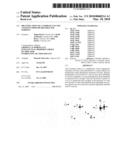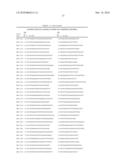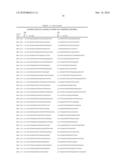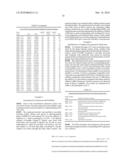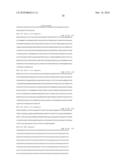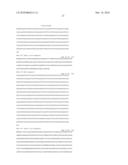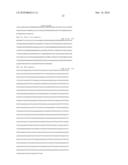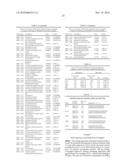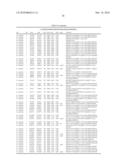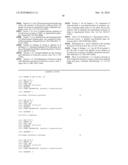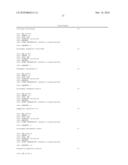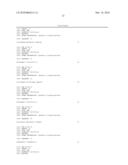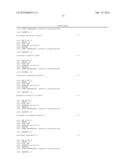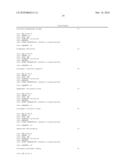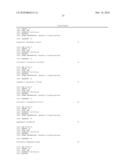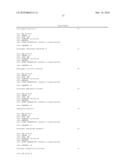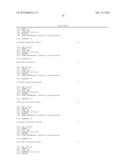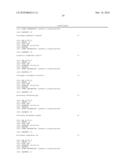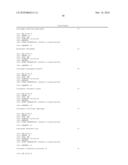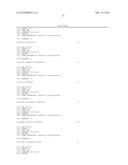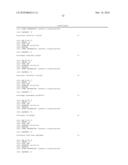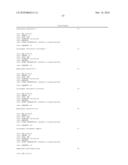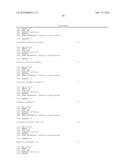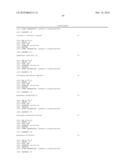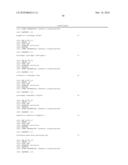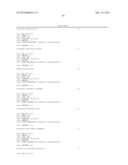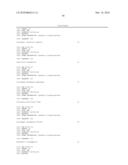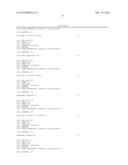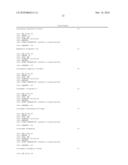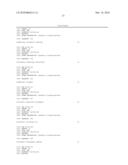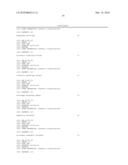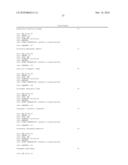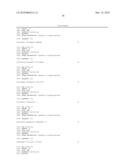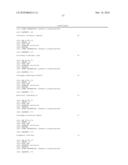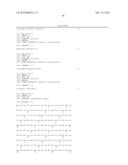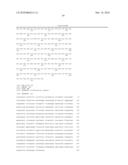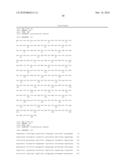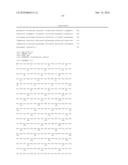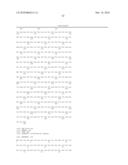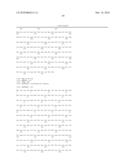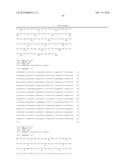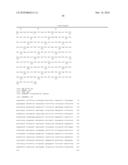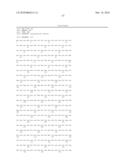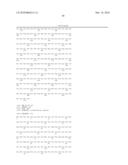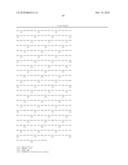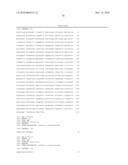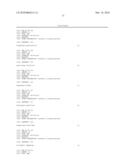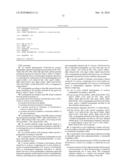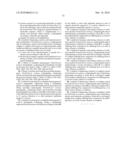Patent application title: Identification of Candidate Vaccine Antigens from Dichelobacter Nodosus
Inventors:
Julian Rood (Victoria, AU)
Keith Al-Hasani (Victoria, AU)
John Boyce (Victoria, AU)
Dane Parker (Victoria, AU)
Assignees:
Monash University
IPC8 Class: AA61K3940FI
USPC Class:
4241641
Class name: Drug, bio-affecting and body treating compositions immunoglobulin, antiserum, antibody, or antibody fragment, except conjugate or complex of the same with nonimmunoglobulin material binds bacterium or component thereof or substance produced by said bacterium
Publication date: 2010-03-18
Patent application number: 20100068214
Claims:
1-35. (canceled)
36. An isolated immunogenic Dichelobacter nodosus polypeptide, selected from the group consisting of PilT, PilU, ChpA, PilJ, PilI, PilG, PilH, Ppk and FimX, and the proteins encoded by the gene loci listed in Table 3, Table 5 or Table 6, or a biologically active or immunogenic fragment, derivative, or variant thereof, with the proviso that the polypeptide is not AprV2 (DNO--1167; SEQ ID NO: 189), AprV5 (DNO--0603; SEQ ID NO: 183), BprV (DNO--0605; SEQ ID NO: 184), YfeA (DNO--0644; SEQ ID NO: 185), or a fragment or variant thereof.
37. A polypeptide according to claim 36, selected from the group consisting of the proteins encoded by the gene loci listed in Table 3, Table 5 or Table 6.
38. A polypeptide according to claim 36, which is selected from the group consisting of:a) a protein involved in transport of molecules across a Dichelobacter nodosus outer membrane;b) a protein involved in iron uptake;c) a protein involved in transport of nutrients;d) a protein involved in resistance of Dichelobacter nodosus to heavy metals; ande) a protein involved in synthesis or structural stability of the outer membrane.
39. A polypeptide according to claim 36, which is selected from the group consisting of DNO--0012 (SEQ ID NO: 179), DNO--0033 (SEQ ID NO: 181), DNO--0725 (SEQ ID NO: 187) and DNO--1241 (SEQ ID NO: 190).
40. An isolated antibody which specifically binds to a Dichelobacter nodosus polypeptide according to claim 36, or to a biologically-active or immunogenic fragment, derivative, or variant thereof.
41. An isolated nucleic acid molecule which encodes a polypeptide according to claim 36.
42. A composition or kit comprising a polypeptide according to claim 36, together with a pharmaceutically- or veterinarily-acceptable carrier.
43. A vaccine capable of treating or preventing a disease caused by D. nodosus, comprising one or more surface-exposed or secreted polypeptides of D. nodosus or biologically active or immunogenic fragments, derivatives or variants thereof, the one or more polypeptides comprising signal and lipoprotein peptides and having fewer than 2 transmembrane domains, and being reactive against sera recovered from animals repeatedly infected with D. nodosus, with the proviso that if individual polypeptides are used, then they are not AprV2 (DNO--1167; SEQ ID NO: 189), AprV5 (DNO--0603; SEQ ID NO: 183), BprV (DNO--0605; SEQ ID NO: 184), a polypeptide encoded by the Omp1 locus, or a fimbrial polypeptide encoded by the fimA fimbrial subunit gene.
44. A vaccine capable of treating or preventing a disease caused by D. nodosus, comprising one or more surface-exposed or secretes polypeptides of D. nodosus or a biologically active or immunogenic fragment, derivative or variant thereof, comprising(a) one or more isolated immunogenic D. nodosus polypeptides according to claim 36,(b) one or more of YfeA (DNO--0644; SEQ ID NO: 185), AprV2 (DNO--1167; SEQ ID NO: 189), AprV5 (DNO--0603; SEQ ID NO: 183), BprV (DNO--0605; SEQ ID NO: 184), a polypeptide encoded by the Omp1 locus, and/or a fimbrial polypeptide encoded by the fimA fimbrial subunit gene, oran immunogenic fragment, derivative, or variant thereof,with the proviso that if the vaccine comprises AprV2 (DNO--1167; SEQ ID NO: 189), AprV5 (DNO--0603; SEQ ID NO: 183), BprV (DNO--0605; SEQ ID NO: 184), a polypeptide encoded by the Omp1 locus, and/or a fimbrial polypeptide encoded by the fimA fimbrial subunit gene, or an immunogenic fragment, derivative, or variant thereof, at least one of (a) or YfeA (DNO--0644; SEQ ID NO: 185) is present.
45. A composition or kit comprising a nucleic acid molecule according to claim 41, together with a pharmaceutically or veterinarily acceptable carrier.
46. A composition or kit comprising an antibody according to claim 40, together with a pharmaceutically or veterinarily acceptable carrier.
47. A kit for detecting the presence of DNA associated with Dichelobacter nodosus in a sample, in which the kit comprises:a) a known amount of a first oligonucleotide which consists of at least about 7 to about 50 nucleotides, in which the oligonucleotide has at least about 70% contiguous sequence identity to a nucleic acid molecule which encodes a polypeptide according to claim 36;b) a known amount of a second oligonucleotide, in which the second oligonucleotide consists of at least about 7 to about 50 nucleotides, and in which the oligonucleotide has at least about 70% contiguous sequence identity to a nucleotide sequence which is complementary to a nucleic acid molecule which encodes a polypeptide according to claim 36, and optionallyc) reagents for nucleic acid amplification.
48. A method of detecting a nucleic acid molecule encoding a polypeptide of Dichelobacter nodosus, comprising the step of contacting a nucleic acid obtained from a biological sample of a subject with at least two oligonucleotides, under conditions effective to amplify the nucleic acid so as to yield an amount of amplified nucleic acid, in whicha) at least one of the oligonucleotides is specific for a nucleic acid according to claim 41, andb) the biological sample comprises cells suspected of containing a nucleic acid molecule encoding the immunogenic polypeptide.
49. A library of candidate immunogenic Dichelobacter nodosus polypeptides, comprising the polypeptides encoded by the gene loci listed in Table 3, Table 5 or Table 6, PilT, PilU, ChpA, PilJ, PilI, PilG, PilH, Ppk and FimX.
50. A library of nucleic acid molecules encoding immunogenic Dichelobacter nodosus polypeptides, comprising nucleic acid molecules encoding the polypeptides encoded by the gene loci listed in Table 3, Table 5 or Table 6, PilT, PilU, ChpA, PilJ, PilI, PilG, PilH, Ppk and FimX.
51. A method of screening for a candidate immunogenic D. nodosus polypeptide, comprising testing a polypeptide library according to claim 49, expressed from the nucleic acid library encoding immunogenic Dichelobacter nodosus polypeptides, comprising nucleic acid molecules encoding the polypeptides according to claim 49, for the ability to react with antibodies present in sera of animals previously exposed to D. nodosus infection or to elicit protective antibodies against D. nodosus.
52. A method of screening for a candidate immunogenic D. nodosus polypeptide comprising testing a polypeptide expressed from the nucleic acid library according to claim 50, for the ability to react with antibodies present in sera of animals previously exposed to D. nodosus infection or to elicit protective antibodies against D. nodosus.
53. A method of treating or preventing a disease or condition caused by Dichelobacter nodosus, comprising the step of administering a polypeptide according to claim 36, to a subject suffering from, suspected to be suffering from or at risk of such a disease or condition.
54. A method of treating or preventing a disease or condition caused by Dichelobacter nodosus, comprising the step of administering a antibody according to claim 40, to a subject suffering from, suspected to be suffering from or at risk of such a disease or condition.
55. A method of treating or preventing a disease or condition caused by Dichelobacter nodosus, comprising the step of administering a nucleic acid molecule according to claim 41, to a subject suffering from, suspected to be suffering from or at risk of such a disease or condition.
56. A method of treating or preventing a disease or condition caused by Dichelobacter nodosus, comprising the step of administering a vaccine according to claim 43, to a subject suffering from, suspected to be suffering from or at risk of such a disease or condition.
57. A method of diagnosing a disease or condition caused by Dichelobacter nodosus, comprising the step of detecting a polypeptide according to claim 36 in a biological sample from a subject suffering from, suspected to be suffering from, or at risk of such a disease or condition.
58. A method of diagnosing a disease or condition caused by Dichelobacter nodosus, comprising the step of detecting a antibody according to claim 40 in a biological sample from a subject suffering from, suspected to be suffering from, or at risk of such a disease or condition.
59. A method of diagnosing a disease or condition caused by Dichelobacter nodosus, comprising the step of detecting a nucleic acid molecule according to claim 41 in a biological sample from a subject suffering from, suspected to be suffering from, or at risk of such a disease or condition.
Description:
FIELD
[0001]This invention relates to a prophylactic and/or therapeutic treatment of footrot, and in particular to a vaccine effective in prophylactic and/or therapeutic treatment of footrot.
BACKGROUND
[0002]All references, including any patents or patent application, cited in this specification are hereby incorporated by reference to enable full understanding of the invention. Nevertheless, such references are not to be read as constituting an admission that any of these documents forms part of the common general knowledge in the art, in Australia or in any other country. The discussion of the references states what their authors assert, and the applicants reserve the right to challenge the accuracy and pertinency of the cited documents.
[0003]Footrot is a highly contagious and debilitating disease of the feet of sheep and other ruminants, and is characterized by the separation of the keratinous hoof from the underlying epidermal tissue, resulting in severe lameness and loss of body condition. The consequences of this disease are very significant for the wool and sheep meat industries, and footrot is among the most significant ovine bacterial diseases, causing severe economic losses in most producer countries.
[0004]Footrot is dependent on a mixed bacterial infection, but the essential causative agent is Dichelobacter nodosus, a slow-growing, anaerobic, gram-negative rod. D. nodosus exhibits a spectrum of virulence, ranging from virulent strains, which lead to severe underrunning of the horn of the hoof, to benign strains, which cause a self-limiting interdigital dermatitis (Stewart, 1989).
[0005]Dichelobacter nodosus, formerly designated as Bacteroides nodosus, is a fastidious and slow-growing Gram-negative aerotolerant anaerobe which is the principal causative agent of footrot in ruminants. In addition to its effects on sheep, D. nodosus is also capable of causing footrot in other animals with cloven hooves, such as cattle, goats and deer; however, apart from ovine footrot only the disease in goats is recognised as a serious clinical problem. Goats are usually less severely affected, and may exhibit different symptoms to sheep infected with the same strain of bacteria.
[0006]The virulence of D. nodosus refers to its ability to infect the connective tissue between the horn and flesh of the hoof, and its ability to under-run the horn of the foot. Virulence varies widely between the various strains of D. nodosus. D. nodosus strains of low virulence have poor ability to under-run the hoof horn, and therefore mostly affect the skin between the toes; this is known as benign footrot. Virulent D. nodosus strains rapidly under-run and separate the hoof horn from the foot. Many strains fall somewhere between the benign and virulent extremes. Ovine footrot begins as an interdigital dermatitis before destruction of the epidermal matrix leads to necrotic separation of the hoof from the underlying soft tissue. Infection with D. nodosus requires suitable climatic and environmental conditions, in particular warm weather and moist lush pastures; transmission of the disease ceases in dry conditions which allow dehydration of the interdigital skin. Footrot is virtually always carried into a property and flock by means of a carrier sheep or goat, although cattle and possibly vehicles can also act as carriers. Spread is primarily from foot to foot via pasture or mud; however, moist pastures, laneways and muddy yards are the main areas where footrot is spread. Footrot will therefore spread most rapidly when it is warm and moist, as in spring, early summer and sometimes in autumn.
[0007]The treatment of footrot and elimination of infection from a flock requires a combination of methods, including relocation of the sheep to a dry paddock, foot baths, antibiotic therapy, vaccination and effective management, all of which place severe economic strain on farmers. Sheep which have been infected with or exposed to footrot do not develop any significant natural immunity or resistance. In Australia alone the estimated losses due to footrot amount to millions of dollars annually.
[0008]Vaccination against D. nodosus has been available for many years (Egerton & Burrell, 1970; Every & Skerman, 1982), but confers only short-term immunity. Vaccines are typically composed of whole cells or purified fimbriae, which provide homologous protection against the serogroup infecting the flock. However, the ability of D. nodosus to undergo serogroup conversion and the observation that reservoirs of serogroups are found in infected hooves highlights the need for heterologous protection (Claxton et al., 1983, Zhou & Hickford, 2000a, Kennan et al., 2003).
[0009]Classification of strains of D. nodosus into serogroups and subgroups is based on agglutinogens which are present on surface filaments, which are called pili or fimbriae. These terms are used interchangeably herein. The pili induce a high level of protection in vaccinated sheep against homologous serogroups of D. nodosus. Since there are at least 10 serogroups, the current commercially-available vaccines contain killed whole cells of 8-10 well-piliated strains representative of most of the known serogroups (Claxton et al, 1983). Multivalent recombinant fimbrial vaccines have also been prepared by overexpression of each of the nine fimbrial subunit genes in Pseudomonas aeruginosa.
[0010]The currently-available vaccines suffer from a number of disadvantages: [0011](a) they provide only a 60-80% protection rate; [0012](b) multiple immunizations during the wet season are required; [0013](c) they are more expensive than other vaccines used in sheep, partly because of the need for the incorporation of multiple strains into the vaccine and partly because of the fastidious growth requirements and relatively sparse growth of D. nodosus in liquid medium; [0014](d) pilus expression tends to be variable and, especially with some strains, the irreversible loss of pili from cells following subculture in liquid medium is a major problem to manufacturers; [0015](e) there is a physical limit to the number of strains which can be incorporated into commercial footrot vaccines, and the efficacy of the whole vaccine could decrease if additional strains need to be incorporated; [0016](f) antigenic competition has limited the application of these vaccines, so that the most effective strategies are based on univalent and divalent formulations; [0017](g) multivalent whole bacterial cell vaccines cause clinical problems because they cause large granulomas at the injection site; and [0018](h) the dominant serogroup causing disease varies from country to country, region to region, and property to property.
[0019]Although homologous protection is superior to that obtained against heterologous strains, some cross-protection against heterologous serogroups has been obtained with whole cell vaccines (Thorley and Egerton 1981; Stewart et al 1983; Stewart et al 1985); however, this is not statistically significant.
[0020]The surface of Gram-negative bacteria is critical for the interaction of the bacterium with the host cell environment, as it mediates nutrient uptake and secretion of toxins and other products, and is involved in avoidance of the host immune system (Niemann et al., 2004). Furthermore, it is the surface molecules of bacteria which are detected by the host immune system, and it is likely to be these molecules against which the host must mount a protective response. Indeed, outer membrane proteins have been shown to be important for conferring protective immunity in a range of models of infection (Brown et al., 2001, Frazer et al., 2006). Outer membrane proteins are also known to promote adherence to host cell surfaces, and are therefore likely to be involved in D. nodosus virulence (Boyle and Finlay, 2003).
[0021]The only experimentally validated vaccine against D. nodosus consists of purified fimbriae, which can only protect against individual serogroups (Stewart, 1989b). Although the protection conferred by fimbrial vaccines is serogroup-specific, low levels of protection, which are not statistically significant, are observed against heterologous challenge, and antibodies raised against fimbriae from one serogroup cross-react with heterologous serogroups (Stewart et al., 1985a).
[0022]There have been attempts to identify non-fimbrial antigens which will provide cross-protection against a range of serogroups. For example, U.S. Pat. No. 4,737,363 and PCT/AU88/00176 (WO88/09668) by Commonwealth Scientific and Industrial Research Organisation disclose vaccines respectively comprising an extracellular serine protease and a basic serine protease of D. nodosus, in which the enzymes used in as antigens are found in virulent but not benign strains of D. nodosus. PCT/AU91/00366 (WO92/03553) by Daratech Pty Ltd discloses a vaccine comprising a recombinant secreted outer membrane protein of D. nodosus. However, these vaccines have not been made commercially available, and it is our understanding that the vaccine disclosed in PCT/AU91/00366 proved not to be protective.
[0023]There is therefore a need in the art for the identification of suitable antigens which can form the basis of vaccines suitable for use in sheep. In particular there is a need for a vaccine which provides heterologous protection, i.e. protection against more than one serogroup of D. nodosus.
SUMMARY
[0024]In a first aspect, the invention provides an isolated immunogenic D. nodosus polypeptide, expressed from a gene locus selected from the group consisting of the proteins encoded by the gene loci listed in Table 3, Table 5 or Table 6, or a biologically active or immunogenic fragment, derivative, or variant thereof, with the proviso that the polypeptide is not AprV2 (DNO--1167; SEQ ID NO: 189), AprV5 (DNO--0603; SEQ ID NO: 183), BprV (DNO--0605; SEQ ID NO: 184), a polypeptide encoded by the Omp1 locus, or a fimbrial polypeptide encoded by the fimA fimbrial subunit gene.
[0025]The polypeptide may be a recombinant or synthetic polypeptide, or may be extracted from D. nodosus bacteria or from D. nodosus culture supernatant or from biological material infected with D. nodosus.
[0026]Polypeptides which are expressed at the bacterial cell surface, secreted, encoded by nucleic acid sequences comprise regions of atypical nucleotide composition, found in strains associated with virulence, or exhibit similarity to putative vaccine candidate proteins from other bacterial species are considered likely to be useful as antigens for use in vaccines against D. nodosus, and are used in some embodiments of the invention.
[0027]In some embodiments, the polypeptide is selected from the group consisting of the proteins whose corresponding gene loci are listed in Table 3, Table 5 or Table 6.
[0028]In some embodiments, the polypeptide is selected from the group consisting of: [0029]a) a protein involved in transport of molecules across a D. nodosus outer membrane; [0030]b) a protein involved in iron uptake; [0031]c) a protein involved in transport of nutrients; [0032]d) a protein involved in resistance of D. nodosus to heavy metals; and [0033]e) a protein involved in synthesis or structural stability of the outer membrane.
[0034]In some embodiments, the polypeptide is expressed more strongly when the bacterium is grown in vivo.
[0035]In some embodiments, the polypeptide is expressed more strongly when D. nodosus is grown in vitro in the presence of ovine hoof powder.
[0036]In some embodiments, the polypeptide is selected from the group consisting of PilT, PilU, ChpA, PilJ, PilI, PilG, PilH, Ppk, FimX, PilC, PilQ, RTX-like toxin (DNO--0334), DNO--0335-0336, putative large highly repetitive secreted protein (DNO--0690), DNO--0466, DNO--0650, DNO--1067, DNO--0681, DNO--0902, DNO--0012 (SEQ ID NO: 179), DNO--0033 (SEQ ID NO: 181), DNO--0725 (SEQ ID NO: 187), and DNO--1241 (SEQ ID NO: 190). In some embodiments, the polypeptide is selected from the group consisting of DNO--0012 (SEQ ID NO: 179), DNO--0033 (SEQ ID NO: 181), DNO--0725 (SEQ ID NO: 187) and DNO--1241 (SEQ ID NO: 190).
[0037]In some embodiments, the D. nodosus strain is one isolated from sheep, goats or cattle. In some embodiments the isolate is from sheep, and may be a virulent strain, for example strain VCS1703A serogroup G. Many other virulent strains are known in the art, for example those discussed herein.
[0038]The polypeptide may optionally be linked to a heterologous polypeptide. In one embodiment the heterologous polypeptide is an immunogenic carrier polypeptide. The linkage may be effected by chemical coupling, or the polypeptide of the invention may be expressed as a fusion protein with a heterologous polypeptide.
[0039]It will be clearly understood that the invention also encompasses biologically-active or immunogenic fragments, variants and derivatives of the polypeptides of the invention. In one embodiment the polypeptide of the invention is an outer membrane protein, and may comprise an extracellular domain. In another embodiment a fragment according to the invention corresponds to one or more extracellular domains of a cell surface polypeptide of D. nodosus. The fragment may comprise one or more epitopes.
[0040]In some embodiments, the polypeptide elicits an immune response which is protective against infection with D. nodosus. Preferably the polypeptide provides heterologous protection, i.e. protection against at least two different serotypes of D. nodosus. In some embodiments the polypeptide elicits antibodies which bind specifically to a D. nodosus polypeptide, and which may or may not be protective. Such antibodies are useful in immunoassays. In these embodiments the antibody may be a neutralizing antibody.
[0041]A polypeptide of the invention, or a biologically active or immunogenic fragment, derivative, or variant thereof, is useful in immunogenic compositions to prepare antisera or vaccines. A polypeptide of the invention, a fragment thereof such as a peptide, or a variant or derivative thereof, is also useful in assays to detect antibodies specific for the peptide, or for a polypeptide of which a portion has an amino acid sequence corresponding to an epitope within the peptide. These include diagnostic assays.
[0042]In a second aspect the invention provides a composition comprising a polypeptide according to the invention, or a biologically-active or immunogenic fragment, derivative, or variant thereof, together with a pharmaceutically or veterinarily acceptable carrier.
[0043]In a third aspect the invention provides an isolated antibody which specifically binds to a polypeptide of the invention, or to an epitope, fragment, derivative, or variant thereof. The antibodies of the invention may confer protection against infection with D. nodosus; such antibodies are useful in providing passive immunity to a subject to which the preparation is administered. Antibodies of the invention may react specifically with D. nodosus antigens, even though they do not confer protection against infection with D. nodosus; such antibodies are useful in immunoassays for detection of polypeptides of the invention or for diagnosis of D. nodosus infection.
[0044]The antibody may be raised in any convenient mammalian host, including but not limited to mice, rabbits, sheep, cattle, goats or horses, or may be produced in tissue or cell culture. The antibody may be polyclonal or monoclonal. Methods for production of polyclonal and monoclonal antibodies are very well known in the art.
[0045]In a fourth aspect the invention provides a composition comprising an antibody of the invention, together with a pharmaceutically or veterinarily acceptable carrier.
[0046]In a fifth aspect the invention provides an isolated nucleic acid molecule an isolated nucleic acid molecule which encodes a polypeptide of the invention, or a biologically active or immunogenic fragment, derivative, or variant thereof.
[0047]In a sixth aspect the invention provides an isolated nucleic acid molecule of the invention, together with a physiologically-acceptable carrier.
[0048]The invention further provides a vector comprising a nucleic acid molecule which encodes a polypeptide of the invention, or a biologically active or immunogenic fragment, derivative, or variant thereof, and a host cell comprising the vector. Preferably the vector is an expression cassette, and may comprise a preselected DNA sequence which is operably linked to a promoter which is functional in the host cell, in which the DNA sequence encodes one or more D. nodosus polypeptides of the invention. The host cell may be prokaryotic or eukaryotic in origin.
[0049]In a seventh aspect the invention provides a vaccine capable of treating or preventing a disease caused by D. nodosus, comprising one or more surface-exposed or secreted polypeptides of D. nodosus, in which the polypeptides comprise signal and lipopeptides and have fewer than 2 transmembrane domains, and in which the polypeptides are reactive against sera recovered from animals repeatedly infected with D. nodosus.
[0050]In some embodiments the polypeptides are encoded by genes located in gene loci selected from the group consisting of the loci listed in Table 3, Table 5 and Table 6.
[0051]In some embodiments the polypeptides are biologically active or immunogenic fragments, derivative, or variants of the surface-exposed or secreted proteins of D. nodosus, with the proviso that if individual polypeptides are used, then they are not AprV2 (DNO--1167; SEQ ID NO: 189), AprV5 (DNO--0603; SEQ ID NO: 183), BprV (DNO--0605; SEQ ID NO: 184), a polypeptide encoded by the Omp1 locus, or a fimbrial polypeptide encoded by the fimA fimbrial subunit gene.
[0052]The polypeptides may be isolated from a natural source, produced recombinantly or synthetically produced, or may be extracted from D. nodosus bacteria or from D. nodosus culture supernatant or from biological material infected with D. nodosus.
[0053]In some embodiments the polypeptide is selected from the group consisting of: [0054]a) a protein involved in transport of molecules across a D. nodosus outer membrane; [0055]b) a protein involved in iron uptake; [0056]c) a protein involved in transport of nutrients; [0057]d) a protein involved in resistance of D. nodosus to heavy metals; and [0058]e) a protein involved in synthesis or structural stability of the outer membrane.
[0059]In some embodiments, the polypeptide is expressed more strongly when the bacterium is grown in vivo.
[0060]In some embodiments, the polypeptide is expressed more strongly when D. nodosus is grown in vitro in the presence of ovine hoof powder.
[0061]In some embodiments the vaccine comprises [0062](a) one or more isolated immunogenic D. nodosus polypeptides according to the first aspect of the invention, [0063](b) one or more of YfeA (DNO--0644; SEQ ID NO: 185), AprV2 (DNO--1167; SEQ ID NO: 189), AprV5 (DNO--0603; SEQ ID NO: 183), BprV (DNO--0605; SEQ ID NO: 184), a polypeptide encoded by the Omp1 locus, and/or a fimbrial polypeptide encoded by the fimA fimbrial subunit gene, or [0064](c) an immunogenic fragment, derivative, or variant of (a) or (b),with the proviso that if the vaccine comprises AprV2 (DNO--1167; SEQ ID NO: 189), AprV5 (DNO--0603; SEQ ID NO: 183), BprV (DNO--0605; SEQ ID NO: 184), a polypeptide encoded by the Omp1 locus, and/or a fimbrial polypeptide encoded by the fimA fimbrial subunit gene or an immunogenic fragment, derivative, or variant thereof, at least one of (a) is present.
[0065]The vaccine may additionally comprise an adjuvant. Preferably the vaccine provides heterologous protection, i.e. protection against at least two different serotypes of D. nodosus.
[0066]Two or more of the polypeptides may be administered either simultaneously or at different times, and may be administered to the same site or at different sites. It is contemplated that a mixture of two or more antigens will provide maximum cross-protection against different serogroups of D. nodosus.
[0067]In some embodiments, the subject is a sheep, and immunization results in an immune response which inhibits or prevents ovine footrot, or in the production of antibodies to the polypeptide employed as an immunogen. Both local and systemic administration is contemplated. Systemic administration of the vaccine is preferred.
[0068]While the invention is particularly directed to polypeptides suitable as antigens in vaccines for use in sheep, it will be clearly understood that it is applicable to any other animal which is susceptible to infection with D. nodosus, including but not limited to other animals with cloven hooves, such as members of the families Bovidae, including sheep, goats, cattle and antelope, and Cervidae, such as deer. It would be expected because of the close evolutionary relationship of these families of animals that a vaccine which was effective in sheep would also be effective in members of the other families. The invention is applicable to domestic, zoo or wild animals in all of these families. Many of the economically important animals in these families, such as goats, sheep and cattle, have very similar biology and share a high degree of genomic homology. The closeness of their relationship is illustrated by the fact that it is well known that some of these animals, such as goats and sheep, can interbreed. It would therefore be expected that a vaccine which was effective in sheep would also be effective in these other groups of animals. It will be appreciated that the diagnostic, therapeutic and prophylactic aspects of the invention are also applicable to subjects which have been exposed to an animal infected with D. nodosus, or to an environmental source contaminated with D. nodosus, such as pasture, soil, plant material or vehicles.
[0069]In an eighth aspect the invention provides a method of treating or preventing a disease or condition caused by D. nodosus, comprising the step of administering a polypeptide, antibody, nucleic acid and/or vaccine of the invention to a subject suffering from, suspected to be suffering from, or at risk of such a condition.
[0070]In a ninth aspect the invention provides a method of diagnosing a disease or condition caused by D. nodosus, comprising the step of detecting a polypeptide or fragment thereof, an antibody, and/or a nucleic acid molecule of the invention in a biological sample from a subject suffering from, suspected to be suffering from, or at risk of such a condition. Detection of the polypeptide or antibody may for example be achieved by a variety of methods, including but not limited to immunoassay methods such as radioimmunoassays, enzyme-linked immunosorbent assay (ELISA), chemiluminescence assays, scintillation proximity assays, immunohistochemistry, immunoblotting, for example Western blotting, and immunofluorescence. Detection of the nucleic acid molecule, or fragment, variant or derivative thereof may for example be achieved by nucleic acid amplification. Such methods are very well known in the art.
[0071]Thus the method of diagnosis may comprise contacting a sample of DNA obtained from a biological sample from a subject at risk of or suffering from D. nodosus infection with at least two oligonucleotides which bind to complementary strands of said DNA at preselected regions under conditions effective to amplify the DNA, so as to yield amplified DNA. The amplification may be effected by conventional methods, such as polymerase chain reaction. Alternatively the DNA may be obtained by reverse transcription of RNA from the cells. At least one of the oligonucleotides may be specific for DNA encoding a polypeptide of the invention. The presence of amplified DNA is then detected or determined by conventional methods. The presence of amplified DNA is indicative that the subject is infected with D. nodosus. It will be appreciated that any convenient biological sample from the subject may be used, including but not limited to blood and other biological fluids, sputum, hoof lesion exudate and tissue samples.
[0072]In a tenth aspect the invention provides the use of a polypeptide, antibody, nucleic acid and/or vaccine of the invention in the treatment or prevention of a disease or condition caused by D. nodosus.
[0073]In an eleventh aspect the invention provides the use of a polypeptide, antibody and/or nucleic acid molecule of the invention in the diagnosis of a disease or condition caused by D. nodosus. The disease or condition may be diagnosed following nucleic acid amplification.
[0074]The subject may be suspected of or at risk of having the disease or condition, or may have been, or may be suspected to have been, exposed to a subject known or suspected to be infected with D. nodosus.
[0075]In a twelfth aspect the invention provides a kit comprising one or more of a polypeptide, antibody, and/or nucleic acid molecule of the invention. The kit may be used as a diagnostic kit, and may comprise one or more pairs of nucleic acid molecules which can be used as primers for nucleic acid amplification.
[0076]In one embodiment the kit is a diagnostic kit for detecting the presence of DNA associated with D. nodosus in a sample, in which the kit comprises:
(a) a known amount of a first oligonucleotide which consists of at least about 7, 8, 9, 10, 11, 12, 13, 14, 15, 16, 17, 18, 19, 20, 21, 22, 23, 24, 25, 26, 27, 28, 29, 30, 31, 32, 33, 34, 35, 36, 37, 38, 39, 40, 41, 42, 43, 44, 45, 46, 47, 48, or 49 to about 50 nucleotides, in which the oligonucleotide has at least about 70% contiguous sequence identity to a nucleic acid molecule of the invention;(b) a known amount of a second oligonucleotide, in which the second oligonucleotide consists of at least about 7, 8, 9, 10, 11, 12, 13, 14, 15, 16, 17, 18, 19, 20, 21, 22, 23, 24, 25, 26, 27, 28, 29, 30, 31, 32, 33, 34, 35, 36, 37, 38, 39, 40, 41, 42, 43, 44, 45, 46, 47, 48, or 49 to about 50 nucleotides, and in which the oligonucleotide has at least about 70% contiguous sequence identity to a nucleotide sequence which is complementary to a nucleic acid molecule of the invention; and optionally(c) reagents for nucleic acid amplification.
[0077]Preferably the first oligonucleotide consists of at least about 12, 13, 14, 15, 16, 17, 18, 19, 20, 21, 22, 23, 24, 25, 26, 27, 28, 29, 30, 31, 32, 33, 34, 35, 36, 37, 38, or 39 to about 40 nucleotides, and even more preferably about 15, 16, 17, 18, 19, 20, 21, 22, 23, or 24 to about 25 nucleotides. Also preferably the second oligonucleotide consists of at least about 12, 13, 14, 15, 16, 17, 18, 19, 20, 21, 22, 23, 24, 25, 26, 27, 28, 29, 30, 31, 32, 33, 34, 35, 36, 37, 38, or 39 to about 40 nucleotides, and even more preferably about 15, 16, 17, 18, 19, 20, 21, 22, 23, or 24 to about 25 nucleotides. The skilled person will be able to optimize the oligonucleotides using methods known in the art.
[0078]In a thirteenth aspect, the invention provides a method for detecting a nucleic acid molecule encoding a polypeptide of D. nodosus, comprising the step of contacting a nucleic acid obtained from a biological sample from a subject with at least two oligonucleotides, under conditions effective to amplify the nucleic acid so as to yield an amount of amplified nucleic acid, in which the biological sample comprises cells suspected of containing a nucleic acid molecule encoding an immunogenic polypeptide, and at least one of the oligonucleotides is specific for a nucleic acid encoding a polypeptide of the invention, i.e. is able to hybridise to the nucleic acid under stringent conditions. Suitable conditions are well known in the art. The presence of the amplified nucleic acid may be detected by conventional methods, such as ethidium bromide or silver staining. A variety of other methods is known in the art.
[0079]In another aspect, the invention provides a method for detecting a nucleic acid molecule encoding a polypeptide of D. nodosus, comprising the step of contacting a nucleic acid obtained from a biological sample from a subject with at least two oligonucleotides, under conditions effective to amplify the nucleic acid so as to yield an amount of amplified nucleic acid, in which the biological sample comprises cells suspected of containing a nucleic acid molecule encoding an immunogenic polypeptide, and at least one of the oligonucleotides is specific for a nucleic acid encoding a polypeptide of the invention, i.e. is able to hybridise to the nucleic acid under stringent conditions. The presence of the amplified nucleic acid may be detected by conventional methods, such as ethidium bromide or silver staining. A variety of other methods is known in the art.
[0080]In a fourteenth aspect the invention provides a library of candidate immunogenic D. nodosus polypeptides, comprising the polypeptides encoded by the gene loci listed in Table 3, Table 5 or Table 6.
[0081]In a fifteenth aspect the invention provides a library of nucleic acid molecules encoding candidate immunogenic D. nodosus polypeptides, comprising nucleic acid molecules encoding the polypeptides encoded by the gene loci listed in Table 3, Table 5 or Table 6.
[0082]In a sixteenth aspect the invention provides a method of screening for candidate immunogenic D. nodosus polypeptides, comprising testing a polypeptide library according to the invention, or polypeptides expressed from the nucleic acid library according to the invention, for the ability to react with antibodies present in sera of animals previously exposed to D. nodosus infection or to elicit protective antibodies against D. nodosus.
[0083]Methods and pharmaceutical carriers for preparation of pharmaceutical compositions are well known in the art, as set out in textbooks such as Remington's Pharmaceutical Sciences, 20th Edition, Williams & Wilkins, Pennsylvania, USA.
[0084]The compounds and compositions of the invention may be administered by any suitable route, and the person skilled in the art will readily be able to determine the most suitable route and dose for the condition to be treated. Dosage will be at the discretion of the attendant physician or veterinarian, and will depend on the nature and state of the condition to be treated, the age and general state of health of the subject to be treated, the route of administration, and any previous treatment which may have been administered.
[0085]The carrier or diluent, and other excipients, will depend on the route of administration, and again the person skilled in the art will readily be able to determine the most suitable formulation for each particular case.
BRIEF DESCRIPTION OF THE FIGURE
[0086]FIG. 1 shows immunoblots demonstrating recognition of D. nodosus proteins by pooled sera from experimentally infected sheep. A. Preimmune sera; B. Pooled immune sera; protein bands: 1, DNO--0012 (SEQ ID NO: 179; 37 kDa+60 kDa NusA tag); 2, DNO--0033 (SEQ ID NO: 181; 29 kDa); 3, DNO--0603 (SEQ ID NO: 183; 67 kDa); 4, DNO--0605 (SEQ ID NO: 184; 64 kDa); 5, DNO--0644 (SEQ ID NO: 185; 34 kDa); 6, DNO--0725 (SEQ ID NO: 187; 29 kDa); 7, DNO--1167 (SEQ ID NO: 189; 66 kDa); 8, DNO--1241 (SEQ ID NO: 190; 57 kDa) and 9, D. nodosus whole cell lysate.
DETAILED DESCRIPTION
[0087]In an effort to identify novel D. nodosus immunogens to which sheep respond during natural infection, a detailed antigen profiling analysis was undertaken. We utilised a range of bioinformatics analyses of the unpublished annotated D. nodosus genome sequence, and our own unpublished experimental data in order to select genes according to their vaccine potential. This work was based on the premise that protective antigens are likely to be surface-exposed or secreted by the bacteria, and therefore accessible to the host immune system. These proteins are considered to be suitable candidate antigens. We used PSORTB (Gardy et al., 2003), SignalP (Neilsen et al, 1997) and ProteomeAnalyst (Neilsen et al, et al., 1997) to predict all outer membrane and secreted proteins and LipoP (Juncker et al., 2003) to predict all lipoproteins. Using these bioinformatics predictions we have identified 99 proteins which are likely to be surface-exposed or secreted by the bacteria. We also excluded proteins with >2 predicted transmembrane domains due to likely problems with purification. We have also identified 86 proteins which are differentially expressed in the presence of ovine hoof powder. Of the proteins tested so far, we have identified 8 proteins which react specifically with pooled antiserum from sheep infected with virulent D. nodosus, but not with control sera.
DEFINITIONS
[0088]In the description of the invention and in the claims which follow, except where the context requires otherwise due to express language or necessary implication, the word "comprise" or variations such as "comprises" or "comprising" is used in an inclusive sense, i.e. to specify the presence of the stated features but not to preclude the presence or addition of further features in various embodiments of the invention.
[0089]As used herein, the singular forms "a", "an", and "the" include the corresponding plural reference unless the context clearly dictates otherwise. Thus, for example, a reference to "an enzyme" includes a plurality of such enzymes, and a reference to "an amino acid" is a reference to one or more amino acids.
[0090]Where a range of values is expressed, it will be clearly understood that this range encompasses the upper and lower limits of the range, and all values in between these limits.
[0091]Unless defined otherwise, all technical and scientific terms used herein have the same meaning as commonly understood by one of ordinary skill in the art to which this invention belongs. Although any materials and methods similar or equivalent to those described herein can be used to practice or test the present invention, the preferred materials and methods are described.
[0092]The terms "isolated" and/or "purified" refer to an in vitro preparation of a molecule of the invention, or fragment, variant, or derivative thereof, so that the molecule is not substantially associated with molecules with which it normally occurs in vivo, and is substantially free of infectious agents.
[0093]The terms "polypeptide" and "protein" are herein used interchangeably. Where they are used to refer to an amino acid sequence of a naturally-occurring polypeptide, these terms are not meant to limit the amino acid sequence to the complete, native amino acid sequence associated with the recited polypeptide, but instead are meant also to encompass biologically active fragments, derivatives, or variants, including polypeptides having sequence similarity or sequence identity relative to the amino acid sequences provided herein. At various points in this specification individual polypeptides are identified by the name of the corresponding gene loci from which they are expressed.
[0094]As used herein, the term "surface polypeptide" means a polypeptide naturally located on the outer surface of D. nodosus, so that in vivo it is accessible to an immune response of a subject. An "antigenic" surface polypeptide is able to induce an antibody response. An "immunogenic" surface polypeptide is able to induce a specific immune response. Preferably the immunological response is an antibody response directed to a particular epitope on the surface polypeptide. In one embodiment the presence of antibodies specific for the polypeptide correlates with the D. nodosus infection status of the organism.
[0095]An epitope or antigenic determinant is a site on an antigen molecule which binds specifically to the antigen-combining site of an antibody or to a T cell receptor; it is a molecular structure which is recognized by an antibody. An epitope may be linear, e.g. a sequence of contiguous amino acid residues in a protein, or may be a three-dimensional, e.g. a part of the three-dimensional structure of a protein formed by non-contiguous amino acid residues. Antigens may be proteins, lipids or carbohydrates, and an antigen may comprise two or more different epitopes, and/or may have two or more repeated epitopes. Epitopes in any given polypeptide may readily be identified using well-known routine methods. A variety of algorithms may be used, for example for prediction of antigenicity (Hopp and Woods, 1983) or prediction of protein secondary structure (Chou and Fasman, 1974a, 1974b). Many others are known in the art; see for example www.epitopeinformatics.com. Commercial services are available for epitope analyses. For any given protein, epitopes may be empirically identified in a variety of ways, for example by testing proteolytically-generated fragments for their antigenic capacity, or preparing libraries of peptide fragments of the protein, either by expression on the filamentous phage PIII or PVIII surface proteins or by solid-phase peptide synthesis. See for example, Holzen et al. (2001) and references cited therein.
[0096]The term "vaccine antigen potential" means an estimate of the likely ability of a protein to elicit at least some degree of protective immunity. Any protein which confers some or total protection against a challenge with infective organisms can also be referred to as a potential vaccine candidate.
[0097]Polypeptides which have been subjected to chemical modifications, such as esterification, amidation, reduction, protection and the like, are referred to herein as "derivatives." In particular, it is envisioned that a derivative of a polypeptide of the invention may have been modified in a manner that increases its stability in vivo, or which presents immunogenic epitopes in a more native configuration. Methods for preparing such derivatives are well known in the art. For example, a modification known to improve the immunogenicity, stability and/or bioavailability of peptides in vivo is the cyclization of the peptide, for example by formation of one or more disulphide bonds, as described in PCT/US98/25990 (WO99/29724). Another modification is the synthesis of a cyclic reverse sequence derivative (CRD) of a peptide of the invention, in which a linear peptide is synthesized with all D-form amino acids using the reverse (i.e. C-terminal to N-terminal) sequence of the peptide. The term "CRD" also includes cyclization by other mechanisms, e.g. via a peptidyl bond. Cyclized peptides with different kinds of linkages are known in the art; see EP 471,453 (amide bonds); EP 467,701 (disulphide bonds); EP 467,699 (thioether bonds). Other modifications are disclosed in Jameson et al. 1994; U.S. Pat. No. 4,992,463; and U.S. Pat. No. 5,091,396.
[0098]The surface polypeptides of the invention or fragments, variants or derivatives thereof can be prepared in vitro, e.g. by a solid phase peptide synthetic method or by a recombinant DNA approach.
[0099]As used herein, a "fusion protein" is a polypeptide comprising two or more polypeptides that have been joined together, for example after transcription and translation of two or more fused nucleic acid molecules. The two or more polypeptides may be the same or different. Thus the fusion protein may comprise two or more copies of a surface polypeptide of the invention, copies of more than one different surface polypeptide of the invention, or at least one surface polypeptide of the invention fused to any other polypeptide. In one embodiment of the invention the fusion protein comprises at least an immunogenic or antigenic portion of a plurality of D. nodosus outer membrane polypeptides.
[0100]If the surface polypeptide of the invention is expressed as a fusion protein, the fusion protein may be purified by methods specific for the surface polypeptide or non-surface polypeptide portion of the fusion polypeptide. For example, if the fusion polypeptide is a histidine-tagged fusion polypeptide, Ni-NTA resin may be employed to purify the fusion polypeptide. Epitope tags such as FLAG® may also be used.
[0101]Fusion proteins can be prepared by in vitro transcription and translation reactions. An expression cassette can be employed to generate surface polypeptide gene-specific transcripts which are subsequently translated in vitro. The construction of vectors for use in in vitro transcription/translation reactions, and methods for such reactions, are well known in the art.
[0102]The polypeptides or fusion proteins of the invention may also be prepared by solid phase peptide synthesis, which is an established and widely used method, described in the following references: Stewart et al. 1969; Merrifield, 1963; Meienhofer in "Hormonal Proteins and Peptides," ed.; C. H. Li, Vol. 2 (Academic Press, 1973), pp. 48-267; and Bavaay and Merrifield, "The Peptides," eds. E. Gross and F. Meienhofer, Vol. 2 (Academic Press, 1980) pp. 3-285.
[0103]A "monoclonal antibody" is an antibody obtained from a population of substantially homogeneous antibodies, i.e. the individual antibodies comprising the population are identical except for possible naturally occurring mutations that may be present in minor amounts. Monoclonal antibodies are highly specific, being directed against a single antigenic site. Furthermore, in contrast to conventional (polyclonal) antibody preparations which typically include different antibodies directed against different determinants (epitopes), each monoclonal antibody is directed against a single determinant on the antigen. The modifier "monoclonal" indicates the character of the antibody as being obtained from a substantially homogeneous population of antibodies, and is not to be construed as requiring production of the antibody by any particular method. For example, the monoclonal antibodies to be used in accordance with the present invention may be made by the hybridoma method first described by Kohler et al., 1975, or may be made by recombinant DNA methods (see, e.g., U.S. Pat. No. 4,816,567). The person skilled in the art will be aware of numerous other references, such as Goding, J. W. Monoclonal Antibodies: principles and practice (Academic Press, New York: 3rd 1996).
[0104]"Nucleic acid molecule" as used herein refers to an oligonucleotide, polynucleotide, nucleotide, and fragments, variants, derivatives, and antisense molecules thereof, as well as to peptide nucleic acids (PNA), fragments, variants, derivatives and antisense molecules thereof, and to DNA or RNA of genomic or synthetic origin which can be single- or double-stranded, and represent the sense or antisense strand. Where "nucleic acid" is used to refer to a specific nucleic acid sequence, it is intended to encompass polynucleotides that encode a polypeptide that is functionally equivalent to the recited polypeptide, e.g., polynucleotides that are degenerate variants, or polynucleotides which encode biologically active fragments, variants, or derivatives of the polypeptide, including polynucleotides having substantial sequence similarity or sequence identity relative to the sequences provided herein.
[0105]The nucleic acid molecules of the invention, or fragments, variants, or derivatives thereof, may be used to prepare probes, primers or expression cassettes which, in turn, are useful to detect, amplify and express other outer membrane protein genes and related genes.
[0106]The terms "nucleotide sequence" and "nucleic acid sequence" are used herein interchangeably.
[0107]The term "antisense nucleic acid molecule" as used herein defines a sequence which is complementary to a nucleic acid molecule of interest or fragment, variant, or derivative thereof.
[0108]Nucleic acid molecules encoding a surface polypeptide of the invention, or a fragment, variant, or derivative thereof, may be obtained from any isolate of D. nodosus or from physiological fluid or tissue of animals infected with D. nodosus. Other sources of the DNA molecules of the invention include genomic libraries derived from any D. nodosus-infected eukaryotic cellular source. Moreover, DNA molecules which encode a subunit of a full-length surface polypeptide may be prepared in vitro, e.g. by synthesizing an oligonucleotide of about 200, preferably about 100, more preferably about 75, nucleotides in length, or by subcloning a portion of a DNA segment which encodes a particular OMP. A nucleic acid molecule encoding a surface polypeptide of the invention can be identified and isolated using standard methods, for example as described by Sambrook et al., Molecular Cloning. A Laboratory Manual, Cold Spring Harbor, N.Y. (1989).
[0109]A "variant" nucleic acid molecule of the invention is a nucleic acid molecule which has at least 80%, 81%, 82%, 83%, 84% or 85%, preferably at least about 90%, 91%, 92%, 93% or 94%, and more preferably at least about 95%, 96%, 97%, 98%, 99% but less than 100, contiguous nucleotide sequence homology or identity to the nucleotide sequence of the corresponding wild type nucleic acid molecule, which encodes a surface polypeptide of D. nodosus. A variant nucleic acid molecule of the invention may also include nucleotide bases not present in the corresponding wild type nucleic acid molecule, and/or internal deletions relative to the corresponding wild type nucleic acid molecule.
[0110]Nucleic acid molecules encoding amino acid sequence variants of surface polypeptides of the invention may be prepared by a variety of methods known in the art. These include, but are not limited to, isolation from a natural source (in the case of naturally-occurring amino acid sequence variants or serotypes) or preparation by site-directed mutagenesis, PCR mutagenesis, and cassette mutagenesis of an earlier prepared variant or a native surface polypeptide. An optimal oligonucleotide will have 12, 13, 14 or 15 nucleotides which are completely complementary to the template on either side of the nucleotide(s) coding for the mutation. This ensures that the oligonucleotide will hybridize properly to the single-stranded DNA template molecule. The oligonucleotides are readily synthesized using techniques known in the art, such as that described by Crea et al., 1978.
[0111]"Cloning" of DNA, also known as gene cloning or molecular cloning, refers to the use of recombinant DNA technology to insert a desired DNA fragment into a cloning vector, which is then introduced into a host cell in which it can replicate, and culturing the host cell. The DNA may be isolated from its natural source, or may be cDNA or synthetic DNA.
[0112]A "vector" or "cloning vector" is a DNA molecule originating from a virus, a plasmid, or the cell of a higher organism into which another DNA fragment of appropriate size can be integrated without loss of the vector's capacity for self-replication; vectors are routinely used to introduce foreign DNA into host cells, in which the DNA can be reproduced in large quantities. Examples include plasmids, cosmids, and yeast artificial chromosomes; vectors are often recombinant molecules containing DNA sequences from several sources.
[0113]A vector may include one or more nucleic acid sequences, such as an origin of replication, which permit the vector to replicate in a host cell. A vector also may include one or more selectable marker genes and other genetic elements known in the art. The term "vector" as used herein is intended to encompass any carrier for nucleic acid, including plasmids, cosmids and phage. Preferably the vector is an expression cassette.
[0114]To prepare expression cassettes for transformation of host organisms, a recombinant or preselected nucleic acid sequence or segment may be circular or linear, double-stranded or single-stranded. A preselected DNA sequence which encodes an RNA sequence which is substantially complementary to a RNA sequence encoding surface polypeptide is typically a "sense" DNA sequence cloned into a cassette in the opposite orientation (i.e. 3' to 5' rather than 5' to 3'). Generally the preselected DNA sequence or segment is in the form of chimeric DNA, such as plasmid DNA, which can also contain coding regions flanked by control sequences which promote the expression of the preselected DNA present in the resultant cell line.
[0115]"Chimeric" means that a vector comprises DNA from at least two different species, or comprises DNA from the same species, which is linked or associated in a manner which does not occur in the "native" or wild type of the species.
[0116]Apart from preselected DNA sequences which serve as transcription units for surface polypeptides, or fragments, variants, or derivatives thereof, a portion of the preselected DNA may be untranscribed, serving a regulatory or a structural function. For example, the preselected DNA may itself comprise a promoter which is active in the host cell, or may utilize a promoter already present in the genome that is the transformation target. Many promoter elements well known to the art may be employed in the practice of the invention.
[0117]"Control sequences" are nucleic acid sequences necessary for the expression of an operably-linked coding sequence in a particular host organism. Control sequences which are suitable for prokaryotic cells, for example, include a promoter, and optionally an operator sequence, and a ribosome binding site. Such elements may or may not be necessary for the function of the nucleic acid molecule, but may provide improved expression of the nucleic acid molecule by affecting factors such as transcription or stability of mRNA, and may be included in the nucleic acid molecule to obtain optimal performance of the transforming DNA in the cell.
[0118]"Operably linked" means that a nucleic acid molecule is placed in a functional relationship with another nucleic acid molecule. Generally, "Operationally linked" means that the nucleic acid molecules being linked are contiguous and, in the case of a secretory leader, contiguous and in reading phase. However, enhancers do not have to be contiguous. Linking is accomplished by ligation at convenient restriction sites. If such sites do not exist, the synthetic oligonucleotide adaptors or linkers are used in accordance with conventional practice.
[0119]The preselected nucleic acid molecule to be introduced into the cells further will generally contain a selectable marker gene and/or a reporter gene, to facilitate identification and selection of transformed cells from the population of cells sought to be transformed. Alternatively, the selectable marker may be carried on a separate piece of DNA and used in a co-transformation procedure. Both selectable markers and reporter genes may be flanked with appropriate regulatory sequences to enable expression in the host cells. Useful selectable markers are well known in the art, and include antibiotic genes, such as those listed in Table 1 of U.S. Pat. No. 5,848,956 by Lundquist et al.
[0120]Reporter genes are used for identifying potentially transformed cells and for evaluating the functionality of regulatory sequences. Reporter genes which encode for easily assayable proteins are well known in the art. In general, a reporter gene is a gene which is not present in or expressed by the recipient organism or tissue and which encodes a protein whose expression is manifested by some easily detectable property, e.g. enzymatic activity. Preferred genes include the lacZ encoding β-galactosidase and the chloramphenicol acetyl transferase gene (cat) from Tn9 of E. coli, the β-glucuronidase gene (gus) of the uidA locus of E. coli, and the luciferase gene from the firefly Photinus. Expression of the reporter gene is assayed at a suitable time after a nucleic acid molecule has been introduced into the recipient cells.
[0121]As used herein, the term "recombinant" nucleic acid molecule refers to a nucleic acid molecule which has been derived or isolated from any appropriate cellular source, and which may subsequently be chemically altered in vitro, so that its sequence is not naturally occurring, or corresponds to naturally occurring sequences which are not positioned as they would be positioned in a genome which has not been transformed with exogenous DNA. A recombinant nucleic acid "derived" from a source may be a DNA sequence which is identified as a useful fragment within a given organism, and which is then chemically synthesized in essentially pure form. Therefore the term "recombinant nucleic acid" includes completely synthetic DNA sequences, semi-synthetic DNA sequences, DNA sequences isolated from biological sources, and DNA sequences derived from RNA, and mixtures thereof. The term "derived" with respect to a RNA molecule means that the RNA molecule has complementary sequence identity to a particular DNA molecule. A DNA "isolated" from a source may be a DNA sequence which is excised or removed from the source by chemical means, e.g. by the use of restriction endonucleases, so that it can be further manipulated for use in the invention, by genetic engineering methodology.
[0122]As used herein, the term "host cell" is intended to refer to well-characterized homogenous, biologically pure populations of cells. The cell line or host cell is preferably of bacterial origin, and most conveniently is Escherichia coli. "Transfected" or "transformed" is used herein to include any host cell or cell line, the genome of which has been altered or augmented by the presence of at least one preselected DNA sequence, which DNA is also referred to in the art of genetic engineering as "heterologous DNA" "recombinant DNA", "exogenous DNA", "genetically engineered", "non-native" or "foreign DNA", in which the DNA was isolated and introduced into the genome of the host cell or cell line by the process of genetic engineering. The host cells are typically produced by transfection with a DNA sequence in a plasmid expression vector, a viral expression vector, or as an isolated linear DNA sequence. Preferably the transfected DNA is a chromosomally-integrated recombinant DNA sequence, which comprises a gene encoding an OMP or its complement, which host cell may or may not express significant levels of autologous or "native" OMP.
[0123]General methods for constructing recombinant DNA which can transform target cells are well known to those skilled in the art, and the same compositions and methods of construction may be utilized to produce the DNA useful herein. For example, J. Sambrook et al., Molecular Cloning. A Laboratory Manual, Cold Spring Harbor Laboratory Press (2d ed., 1989), provides suitable methods of recombinant DNA construction.
[0124]The recombinant DNA can be readily introduced into the host cells by transfection with an expression vector comprising DNA encoding an OMP or its complement, by any procedure useful for the introduction into a particular cell, e.g., physical or biological methods (e.g., recombinant phage or viruses), to yield a transformed cell having the recombinant DNA stably integrated into its genome, so that the DNA molecules, sequences, or segments, of the present invention are expressed by the host cell.
[0125]Physical methods for introducing a recombinant nucleic acid molecule into a host cell include calcium phosphate precipitation, lipofection, particle bombardment, microinjection, electroporation, and the like. The main advantage of physical methods is that they are not associated with pathological or oncogenic processes of viruses in eukaryotic hosts. However, they are less precise, often resulting in multiple copy insertions, random integration, disruption of foreign and endogenous gene sequences, and unpredictable expression.
[0126]To confirm the presence of the preselected DNA sequence in the host cell, a variety of assays may be performed. Such assays include molecular biological assays well known to those of skill in the art, such as Southern and Northern blotting, RT-PCR and PCR; biochemical assays, such as detecting the presence or absence of a particular OMP, e.g. by immunological means such as ELISA assays and Western blots, or by functional assays to identify specific proteins falling within the scope of the invention.
[0127]To detect and quantify RNA produced from introduced preselected DNA segments, reverse transcription PCR (RT-PCR) may be employed. In this application of PCR, it is first necessary to reverse transcribe RNA into DNA, using enzymes such as reverse transcriptase, and then through the use of conventional PCR techniques amplify the DNA. In most instances PCR techniques will not demonstrate integrity of the RNA product, but Northern blotting demonstrates the presence of an RNA species, and gives information about the integrity of that RNA. The presence or absence of an RNA species can also be determined using dot or slot blot Northern hybridizations. These techniques are modifications of Northern blotting, and only demonstrate the presence or absence of an RNA species.
[0128]While Southern blotting and PCR may be used to detect the preselected DNA segment in question, they do not provide information as to whether the preselected DNA segment is being expressed. Expression may be evaluated by specifically identifying the products of the introduced preselected DNA sequences or evaluating the phenotypic changes brought about by the expression of the introduced preselected DNA segment in the host cell.
[0129]Recovery or isolation of a given fragment of DNA from a restriction digest employs methods well known in the art, such as separation of the digest on polyacrylamide or agarose gel by electrophoresis, identification of the fragment of interest by comparison of its mobility versus that of marker DNA fragments of known molecular weight, removal of the gel section containing the desired fragment, and separation of the gel from DNA. See Lawn et al., 1981, and Goeddel et al., 1980.
[0130]"Polymerase chain reaction" (PCR) refers to a procedure in which amounts of a preselected fragment of nucleic acid, RNA and/or DNA, are amplified, such as described in U.S. Pat. No. 4,683,195. Sequence information from the ends of the region of interest or beyond is generally employed to design oligonucleotide primers comprising at least 7-8 nucleotides. These primers will be identical or similar in sequence to opposite strands of the template to be amplified. PCR can be used to amplify specific RNA sequences, specific DNA sequences from total genomic DNA, and cDNA transcribed from total cellular RNA, bacteriophage or plasmid sequences, and the like. See generally Mullis et al., Cold Spring Harbor Symp. Quant. Biol., 51, 263 (1987); Erlich, ed., PCR Technology, (Stockton Press, New York, 1989). Thus PCR-based cloning approaches rely upon conserved sequences deduced from alignments of related gene or polypeptide sequences.
[0131]Primer oligonucleotide sequences are synthesized so as to correspond to highly-conserved regions of proteins or nucleotide sequences which were identified and compared to generate the primers, e.g., by a sequence comparison of other bacterial OMP genes. One primer is predicted to anneal to the antisense strand, and another primer is predicted to anneal to the sense strand, of a DNA molecule which encodes a specific protein. The products of each PCR reaction are separated, for example by agarose gel electrophoresis, and all consistently amplified products are gel-purified and cloned directly into a suitable vector, such as a known plasmid vector. The resultant plasmids are subjected to restriction endonuclease and dideoxy sequencing of double-stranded plasmid DNAs. Alternatively the gel-purified fragment can be directly sequenced.
[0132]"Stringent conditions" for hybridization or annealing of nucleic acid molecules are well known in the art, and include those which
(1) employ low ionic strength and high temperature for washing, for example 0.015 M NaCl/0.0015 M sodium citrate/0.1% sodium dodecyl sulfate (SDS) at 50° C., or(2) employ during hybridization a denaturing agent such as formamide, for example 50% (vol/vol) formamide with 0.1% bovine serum albumin/0.1% Ficoll/0.1% polyvinylpyrrolidone/50 mM sodium phosphate buffer at pH 6.5 with 750 mM NaCl, 75 mM sodium citrate at 42° C. Another example is use of 50% formamide, 5×SSC (0.75 M NaCl, 0.075 M sodium citrate), 50 mM sodium phosphate (pH 6.8), 0.1% sodium pyrophosphate, 5×Denhardt's solution, sonicated salmon sperm DNA (50 μg/mL), 0.1% SDS, and 10% dextran sulfate at 42° C., with washes at 42° C. in 0.2×SSC and 0.1% SDS. See Maniatis et al, op. cit.
[0133]Generally, the terms "treating", "treatment" and the like are used herein to mean affecting a subject, tissue or cell to obtain a desired pharmacological and/or physiological effect. The effect may be prophylactic in terms of completely or partially preventing a disease or condition, or sign or symptom thereof, and/or may be therapeutic in terms of a partial or complete cure of a disease or condition. "Treating" as used herein covers any treatment of, or prevention of, disease in the subject, and includes preventing the disease from occurring in a subject who may be predisposed to the disease, but has not yet been diagnosed as having it; inhibiting the disease, i.e., arresting its development; or relieving or ameliorating the effects of the disease, i.e., cause regression of the effects of the disease. As used herein "condition" means abnormal functioning, and may be any condition caused by D. nodosus.
[0134]As used herein "diagnosis" means identifying the nature or cause of a disease or condition, such as the diagnosis of D. nodosus infection.
[0135]The invention further relates to diagnostic assays for use in veterinary medicine. For diagnosis of D. nodosus infection status, the presence of antibodies to a D. nodosus polypeptide of the invention in animal serum or in exudate from footrot lesions is determined. Many types of test formats may be used. Such tests include, but are not limited to, immunofluorescence assay, radioimmunoassy, radioimmunosorbent test, enzyme-linked immunosorbent assay, scintillation proximity assays, immunohistochemistry, immunoblotting, for example Western blotting, immunofluorescence, agglutination and hemagglutination.
[0136]Alternatively diagnosis may involve PCR or DNA hybridization detection of a specific gene encoding a D. nodosus polypeptide of the invention. The diagnostic assays can be performed using standard protocols.
[0137]For example, a diagnostic assay of the invention can be constructed by coating all or a unique portion of a polypeptide or peptide, or an isolated D. nodosus preparation (the antigen) on a solid support, for example a plastic bead, a test tube, a fibre strip, a microtitration plate or a membrane, and contacting it with a sample of serum, lesion exudate or other physiological fluid taken from a subject suspected of having a D. nodosus infection. Following removal of the sample, any antibody bound to the immobilized antigen can be detected, preferably by reacting the binary antibody-antigen complexes with a "detection antibody", which comprises a detectable label or a binding site for a detectable label. Suitable detectable labels are enzymes, fluorescent labels or radiolabels. Binding sites for detectable labels include avidin, biotin, streptavidin and the like. In another embodiment of the diagnostic assay of the invention, all or a unique portion of the antigen is bound to an inert particle, for example a bentonite, polystyrene, or latex particle. The particles are mixed with serum from a subject in a well of a plastic agglutination tray. The presence or absence of antibodies in the subject's serum is determined by observing the settling pattern of the particles in the well.
[0138]Isolated surface polypeptides or nucleic acids, of the invention may be administered to a subject in an amount effective to elicit an immune response specific for D. nodosus. Methods and pharmaceutical carriers for preparation of pharmaceutical and veterinary compositions are well known in the art, as set out in textbooks such as Remington's Pharmaceutical Sciences, 20th Edition, Williams & Wilkins, Pennsylvania, USA. The compounds and compositions of the invention may be administered by any suitable route, and the person skilled in the art will readily be able to determine the most suitable route and dose for the condition to be treated. Dosage will be at the discretion of the attendant veterinarian, and will depend on the nature and state of the disease or condition to be treated, the age and general state of health of the subject to be treated, the route of administration, and any previous treatment which may have been administered.
[0139]Typically, dosages used in vitro may provide useful guidance in the amounts useful for in situ administration of the pharmaceutical composition, and animal models may be used to determine effective dosages for treatment of the cytotoxic side effects. Various considerations are described in references such as Langer, 1990.
[0140]The carrier or diluent, and other excipients, will depend on the route of administration, and again the person skilled in the art will readily be able to determine the most suitable formulation and dosage for each particular case.
[0141]In general, the dosage of recombinant bacteria required for efficacy will range from about 104, 109, 106, 107, 108, 109, 1010 or 1011 to 1012, preferably about 109, 106, 107, 108 or 109 to 1010, and more preferably about 109, 107 or 108 to 109, colony-forming units (CFU), although other amounts may prove efficacious. For proteins and peptides of the invention, the dosage required is about 1 pg to about 10 mg, preferably about 10 pg to about 1 mg, and more preferably about 100 pg to about 500 μg, although other dosages may be employed. In particular, for administration of a protein or peptide of the invention to a sheep, the amount administered may be at dosages of at least about 1 pg to about 10 mg, preferably about 10 μg to about 1 mg, and more preferably about 100, 200, 300, 400 or 500 μg, although other dosages may provide beneficial results. Dosages within these ranges can be administered via bolus doses or via a plurality of unit dosage forms, until the desired effects have been obtained.
[0142]The amount administered will vary depending on various factors, including, but not limited to, the specific immunogen chosen, the weight, physical condition and age of the subject, and the route of inoculation. Thus for polypeptide and peptides, the absolute weight of polypeptide or peptide in a given unit dosage form of vaccine can vary widely, and depends upon factors such as the species, age, weight and physical condition of the subject to be vaccinated, as well as the method of administration. Such factors can be readily determined by the veterinarian employing animal models or other test systems which are well known to the art.
[0143]Methods for assessing the efficacy of the vaccine are known in the art. For example, the ability of the vaccine to prevent the development of footrot lesions or to reduce the severity of such lesions following challenge with D. nodosus is assessed. Suitable grading systems are known; see for example the review by Whittington and Nicholls (1995). In some embodiments the "total weighted footscore" system described therein is used.
[0144]A unit dose of a protein or peptide vaccine is preferably administered parenterally, e.g. by subcutaneous or intramuscular injection.
[0145]The proteins or peptides of the invention may also be conjugated or linked to an immunogenic protein, such as keyhole limpet haemocyanin (KLH) or albumin, to enhance their immunogenicity. For example, synthetic peptides are coupled to KLH through the C-terminal cysteine of the peptide using the heterobifunctional reagent N-γ-maleimidobutyric acid N-hydroxysuccinimide ester (GMBS; Sigma) according to the manufacturer's directions. The carrier-conjugated peptides are stored at -20° C. until used.
[0146]The compositions of recombinant bacteria which express the polypeptides of the invention may be administered as live, modified-live (attenuated) or inactivated bacteria, or as a combination of attenuated, inactivated, and/or live bacteria, or in combination with a protein or peptide of the invention, or any combination thereof. The bacteria may be inactivated by agents including, but not limited to, formalin, phenol, ultraviolet radiation, and β-propiolactone.
[0147]Immunogenic compositions are typically prepared for injection or infusion, either as liquid solutions or suspensions. Solid forms suitable for solution in, or suspension in, liquid vehicles prior to injection or infusion may also be prepared. The preparation may also be emulsified. The active ingredient may be mixed with diluents, carriers or excipients which are physiologically acceptable and compatible with the active ingredient(s). Suitable carriers can be positively or negatively-charged or neutral pyridine-containing liposomes, oil emulsions, such as live-in-oil; killed-in-oil, or water-in-oil emulsions; aluminium hydroxide; oil emulsion with terpene oils or squalene; or aqueous. Suitable diluents and excipients include water, saline, PBS, glycerol, or the like, and combinations thereof. In addition, if desired, the compositions may contain minor amounts of auxiliary substances such as wetting or emulsifying agents, stabilizing or pH-buffering agents, and the like.
[0148]Aqueous suspensions normally contain the active materials in admixture with excipients suitable for the manufacture of aqueous suspensions. Such excipients may be suspending agents such as sodium carboxymethyl cellulose, methyl cellulose, hydroxypropylmethylcellulose, sodium alginate, polyvinylpyrrolidone, gum tragacanth and gum acacia; dispersing or wetting agents, which may be
(a) naturally occurring phosphatide such as lecithin;(b) a condensation product of an alkylene oxide with a fatty acid, for example, polyoxyethylene stearate;(c) a condensation product of ethylene oxide with a long chain aliphatic alcohol, for example, heptadecaethylenoxycetanol;(d) a condensation product of ethylene oxide with a partial ester derived from a fatty acid and hexitol such as polyoxyethylene sorbitol monooleate, or(e) a condensation product of ethylene oxide with a partial ester derived from fatty acids and hexitol anhydrides, for example polyoxyethylene sorbitan monooleate.
[0149]The compositions may be in the form of a sterile injectable aqueous or oleaginous suspension. This suspension may be formulated according to known methods using suitable dispersing or wetting agents and suspending agents such as those mentioned above. The sterile injectable preparation may also be a sterile injectable solution or suspension in a non-toxic parenterally-acceptable diluent or solvent, for example, as a solution in 1,3-butanediol. Among the acceptable vehicles and solvents which may be employed are water, Ringer's solution, and isotonic sodium chloride solution. In addition, sterile, fixed oils are conventionally employed as a solvent or suspending medium. For this purpose, any bland fixed oil may be employed, including synthetic mono- or diglycerides. In addition, fatty acids such as oleic acid may be used in the preparation of injectables.
[0150]To prepare a vaccine composition comprising a surface polypeptide, the polypeptide can be isolated as described above, lyophilized and stabilized. Alternatively the surface polypeptide may be modified so as to produce a derivative, as described above. The polypeptide antigen may then be adjusted to an appropriate concentration, optionally combined with a suitable carrier and/or suitable vaccine adjuvant, and preferably packaged for use as a vaccine.
[0151]An "adjuvant" is a substance which augments, stimulates, activates, potentiates, or modulates the immune response at either the cellular or humoral level. An adjuvant may be added to a vaccine, or may be administered before administering an antigen, in order to improve the immune response, so that less vaccine is needed to produce the immune response. Widely-used adjuvants include alum, ISCOMs which comprise saponins such as Quil A, liposomes, and agents such as Freund's adjuvant, Bacillus Calmette Guerin (BCG), Corynebacterium parvum or mycobacterial peptides which contain bacterial antigens. Other adjuvants include, but are not limited to, surfactants, e.g. hexadecylamine, octadecylamine, lysolecithin, di-methyldioctadecylammonium bromide, N,N-dioctadecyl-n'-N-bis(2-hydroxyethylpropane diamine), methoxyhexadecyl-glycerol, and pluronic polyols; polyanions, e.g. pyran, dextran sulphate, poly IC, polyacrylic acid, and carbopol; peptides, e.g. muramyl dipeptide, dimethylglycine, and tuftsin; oil emulsions, and mixtures thereof. Only some of these are currently approved for human or veterinary use; others are in clinical trial. The immunogenic product may be incorporated into liposomes for use in a vaccine formulation, or may be conjugated to polysaccharides or other polymers. Some adjuvants are endogenous to the subject to be vaccinated; these include histamine, interferon, transfer factor, tuftsin and interleukin-1. Their mode of action is either non-specific, resulting in increased immune responsiveness to a wide variety of antigens, or antigen-specific, i.e. affecting a restricted type of immune response to a narrow group of antigens.
[0152]It is to be clearly understood that this invention is not limited to the particular materials and methods described herein, as these may vary. It is also to be understood that the terminology used herein is for the purpose of describing particular embodiments only, and it is not intended to limit the scope of the present invention, which will be limited only by the appended claims.
[0153]Unless otherwise indicated, the present invention employs conventional chemistry, protein chemistry, molecular biological and enzymological techniques within the capacity of those skilled in the art. Such techniques are well known to the skilled worker, and are explained fully in the literature. See Coligan, Dunn, Ploegh, Speicher and Wingfield: "Current protocols in Protein Science" (1999) Volumes I and II (John Wiley & Sons Inc.); Sambrook, Fritsch and Maniatis: "Molecular Cloning: A Laboratory Manual" (2001); Shuler, M. L.: Bioprocess Engineering: Basic Concepts (2nd Edition, Prentice-Hall International, 1991); Glazer, A. N., DeLange, R. J., and Sigman, D. S.: Chemical Modification of Proteins (North Holland Publishing Company, Amsterdam, 1975); Graves, D. J., Martin, B. L., and Wang, J. H.: Co- and post-translational modification of proteins: chemical principles and biological effects (Oxford University Press, 1994); Lundblad, R. L. (1995) Techniques in protein modification. CRC Press, Inc. Boca Raton, Fl. USA; and Goding, J. W Monoclonal Antibodies: principles and practice (Academic Press, New York: 3rd ed. 1996).
Abbreviations Used Herein are as Follows:
[0154]CDS predicted coding sequencesELISA enzyme-linked immunosorbent assayEYE Eugon yeast extractLPS lipopolysaccharide3-mer trinucleotideOMP outer membrane proteinsORF open reading framePBS phosphate-buffered salineQRT-PCR quantitative real-time polymerase chain reactionSDS-PAGE sodium dodecyl sulphate polyacrylamide gel electrophoresis
[0155]The surface of Gram-negative bacteria is critical for the interaction of the bacterium with the environment. It consists primarily of lipopolysaccharide (LPS), phospholipids and proteins. The LPS and phospholipids provide a significant permeability barrier to hydrophobic compounds, while the proteins known as outer membrane proteins (OMPs) are generally involved in outer membrane stability and in transport of various molecules in and out of the cell. These OMPs include porins, which allow non-specific diffusion of charged and neutral solutes, and high affinity transporters, which mediate transport of specific ligands in and out of the cell. The expression of the various OMPs is influenced by the extracellular environment. While these principles apply to most Gram-negative bacteria, the surface of D. nodosus has not hitherto been well-characterized, and consequently it was not known prior to the present study whether this organism fitted the typical pattern.
[0156]The D. nodosus strain VCS1703A was chosen for whole genome sequence analysis, as it is both virulent and naturally transformable, and has been used in footrot virulence studies (Kennan et al, 2001). The genome data were used for the identification of vaccine candidates by screening heterologously-expressed predicted coding sequences (CDSs) with sheep immune sera. These investigations have led to the identification of novel surface or secreted proteins with substantive vaccine potential. The effectiveness of this approach, which has been termed "reverse vaccinology" or "reverse immunology" has been reported for several organisms, including Plasmodium falciparum (Haddad et al., 2004), Streptococcus pneumoniae (Wizemann et al., 2001), Treponema pallidum (McKevitt et al., 2003), Neisseria meningitidis serogroup B (Pizza et al., 2000), and Chlamydia pneumoniae (Montigiani et al., 2002). However, although this approach appears to be applicable to a wide range of organisms, the individual antigens which confer protection in any individual case cannot be predicted.
[0157]This approach to immunogen discovery suffers from the drawbacks that [0158](a) it is limited to protein coding regions which can be expressed in E. coli or Ps. Aeruginosa or other cells suitable for heterologous protein expression; [0159](b) antibodies specific for conformational epitopes which are denatured in SDS-PAGE will not be detected; [0160](c) a lack of antibody recognition to a given recombinant protein may be the result either of a poor immune response to the antigen or of a reflection of its low level or total absence of expression in the host.
[0161]In the present case, alternative strains of E. coli are available which are suitable as expression hosts, and Ps aerginosa may also be used. Conformational epitopes may be identified by testing the vaccine potential of soluble non-denatured antigens in vivo, for examples in sheep.
[0162]The invention will now be described in detail by way of reference only to the following non-limiting examples and drawings.
[0163]The D. nodosus strain VCS1703A was chosen for whole genome sequence analysis, as it is both virulent and naturally transformable, and has been used in footrot virulence studies (Kennan et al, 2001). The genome data was used for the identification of vaccine candidates by screening heterologously-expressed predicted coding sequences (CDSs) with sheep immune sera. These investigations have led to the identification of novel surface or secreted proteins with substantive vaccine potential.
Materials and Methods
Growth Conditions
[0164]D. nodosus strains were grown either on Eugon (Difco) yeast extract (EYE) agar containing 5% defibrinated horse blood (Equicell) or in Eugon (Difco) broth with yeast extract in an anaerobic chamber, as previously described (Parker et al, 2005). Anaerobic jar experiments were performed using AnaeroGen and CampyGen atmosphere generation sachets (Oxoid) in Oxoid anaerobic jars.
Example 1
Genome Sequencing and Annotation
[0165]The complete genome sequence of the virulent serogroup G D. nodosus strain VCS1703A was determined using the whole-genome shotgun method as previously described (Fraser, 1997). Physical and sequencing gaps were closed using a combination of primer walking, generation and sequencing of transposon-tagged libraries of large-insert clones, and multiplex PCR (Tettelin, 1998). Identification of putative protein-encoding genes and annotation of the genome were performed as previously described (Bulach, 2006). An initial set of genes predicted to encode proteins was identified with GLIMMER (Delcher, 2002). Genes consisting of fewer than 30 codons and those containing overlaps were eliminated. Frame shifts and point mutations were corrected or designated "authentic".
[0166]Functional assignment, identification of membrane-spanning domains, determination of paralogous gene families and identification of regions of unusual nucleotide composition, sequence alignments and phylogenetic trees were performed as previously described (Fraser, 1997).
[0167]The complete annotated genome sequence is available at GenBank accession number CP000513, and is incorporated herein by this reference. This sequence was published on 4th May 2007. The sequences of the polypeptides listed herein, including those in Table 5, can be downloaded from GenBank accession No. CP000513, or can readily be derived from this source.
Example 2
Virulence Factors and Strain Diversity
[0168]D. nodosus differs from other organisms with small genomes in its surprising extent of apparent lateral gene transfer and strain diversity. This was assessed by analysis of regions of atypical trinucleotide composition, combined with comparative genomic microarray experiments on eight selected D. nodosus isolates using a custom 70mer oligonucleotide array for all 1299 genes derived from the whole genome sequence. The strains used are summarized in Table 1.
TABLE-US-00001 TABLE 1 Characteristics of strains used in comparative genomic hybridization analysis ORIGINAL SERO- No VIRULENCE TYPE GROUP SOURCE AC424 BENIGN II H Albany, WA, Australia VCS1703A VIRULENT I G University of Sydney, Australia VCS1690A VIRULENT II H University of Sydney, Australia A198 VIRULENT I A University of Sydney, Australia AC390 BENIGN II D Albany, WA, Australia 806(2a) INTER- I I Wagga Wagga, NSW, MEDIATE Australia CS101 BENIGN I G CSIRO, Vic, Australia 375(4b) -- -- -- Wagga Wagga, NSW, Australia HA320 INTER- -- -- Hamilton, Vic, MEDIATE Australia
[0169]Genomic DNA was extracted from two-day-old EYE agar cultures of D. nodosus using the DNeasy extraction kit (Qiagen). DNA (4 μg) was digested with 20 U of AluI for 2 h at 37° C. and purified (PCR purification kit, Qiagen). Labelled genomic DNA (2 μg in 20 μl) was prepared by the addition of 25 μg of random hexamers with 20 μl of reaction buffer (42 mM 2-mercaptoethanol, 21 mM MgCl2, 210 mM Tris-HCl pH7.0), boiled for 5 min then placed on ice. Fluorescent dyes (60 nM, Cy5-dUTP or Cy3-dUTP, Amersham Biosciences) were coupled using 40 U of Klenow enzyme and nucleotides (1.2 mM dCTP, dGTP, dATP and 0.6 mM dTTP) in a final volume of 50 μl. Reactions were incubated for two hours and stopped in the presence of 50 mM EDTA, pH 8.0. Reaction mixtures were purified with Microcon columns (Millipore) and concentrated in a Speedvac SVC (Savant). Samples were then hybridised, washed, scanned and analysed as previously described (Parker, 2006).
[0170]The D. nodosus VCS1703A genome was compared to other genomes at the nucleotide level by suffix tree analysis using MUMmer. D. nodosus CDSs were compared by BLAST against the complete set of non-redundant CDSs, using an E-value cut-off of 1×10-5. Genes which had greater than a 1.5-fold change in signal and a Wilcoxon signed ranked p-value<0.05 were included in the final data set.
[0171]Microarray data have been deposited at the National Center for Biotechnology Information's Gene Expression Omnibus (GEO) database (http://www.ncbi.nlm.nih.gov/geo) under the series accession number GSE5157, and are incorporated herein by this reference.
[0172]Twenty-one distinct zones of unusual trinucleotide composition were identified; many of these regions also corresponded to strain-specific regions of variability identified by microarray analysis.
[0173]The largest region of atypical trinucleotide composition is a 38.4 kb integrated Mu-like bacteriophage. This region encodes homologues of phage terminase and head and tail morphogenesis proteins. This region is divergent in at least five of the eight isolates examined (confirmed by Southern blotting, data not shown). attP-like binding sites and phage-like integrases have been previously reported to be associated with D. nodosus genomic islands (Haring et al, 1995); however, the sequence disclosed in this specification is the first complete D. nodosus bacteriophage-like sequence reported.
[0174]The distribution of all 64 trinucleotides (3-mers) was determined, and the 3-mer distribution in 2,000-bp windows which overlapped by half their length (1,000 bp) across the genome was computed. For each window, we computed the χ2 statistic on the difference between its 3-mer content and that of the whole chromosome. A large value for χ2 indicates the 3-mer composition in this window is different from the rest of the chromosome. Probability values for this analysis are based on assumptions that the DNA composition is relatively uniform throughout the genome, and that 3-mer composition is independent. Because these assumptions may be incorrect, we prefer to interpret high χ2 values as indicators of regions on the chromosome which appear unusual and demand further scrutiny.
[0175]Two vap loci which include phage-like integrases and plasmid gene homologues are present in D. nodosus VCS1703A, corresponding to the regions of unusual trinucleotide composition. These two vap loci are conserved in only two of the eight D. nodosus isolates (HA320, with intermediate virulence; and the virulent strain A198), with the remainder of the isolates exhibiting significant variability within these loci. Similarly, strain VCS1703A has the vr1 island, also associated with significant unusual trinucleotide composition. The vr1 island from strain VCS1703A has only 3 by differences to the 27 kb vrl region from strain A198. The vrl region was also present in strain HA320 and AC424, a benign isolate. Despite the association of the vap and vrl loci with D. nodosus virulence, none of the genes within these loci has yet been assigned a known virulence function.
[0176]Type IV fimbriae are present on many important pathogens, such as Pseudomonas aeruginosa, Neisseria sp, Legionella pneumophila, and enteropathogenic Escherichia coli, and are required for virulence, natural transformation, adhesion, twitching motility and protease secretion in D. nodosus (Parker et al, 2006; Kennan, et al 2001).
[0177]The type IV fimbrial biogenesis genes are scattered throughout the VCS1703A genome, in eight different locations. The fimAB genes are located within a region of atypical trinucleotide composition, and microarray analysis indicated that fimA is divergent in all but two strains. fimA encodes the type IV fimbrial subunit; variation in fimA is the primary basis for D. nodosus serogroup typing (Claxton, 1983). Of the two strains which exhibit fimA conservation, one belongs to serogroup G, which is the same as the sequenced strain; the other belongs to serogroup I. fimB is divergent or missing in four of the strains, three of which are type II serogroup strains which characteristically lack fimB (Hobbs, 1991).
[0178]The genome contains 21 genes putatively involved in fimbrial biogenesis and 10 genes which appear to be involved in their regulation. Many of the absent genes are involved in regulation. Genes potentially involved in twitching motility (pilT, pilU) and its regulation (chpA, pilJ, pilI, pilG, pilH, ppk, fimX) were identified. In addition to putative tip adhesin (pilC) and secretin (pilQ) genes. pilQ was located in a region of atypical nucleotide composition, which was shown by microarray and PCR analysis to contain sequence variations.
[0179]PilQ appears to be the only outer membrane secretin encoded by D. nodosus. Since some type II secretion proteins share similarity to fimbrial proteins, we suggest that the type IV fimbriae may act as a secretion portal, expelling proteins through the motive force of fimbrial extension and retraction. We propose that in D. nodosus the type IV fimbrial secretin PilQ may act with the fimbrial biogenesis machinery as the only type II protein secretion system.
[0180]D. nodosus secretes three closely-related extracellular proteases (Riffkin et al, 1995) which are postulated to be involved in invasion and penetration by digesting the epidermal matrix of the hoof. Virulent isolates produce two acidic (AprV2, AprV5) proteases and one basic (BprV) protease, which are all members of the subtilisin protease family. These proteases are encoded within regions of unusual trinucleotide composition (AprV5, BprV and AprV2).
[0181]The major outer membrane protein of D. nodosus, Omp1, is encoded in a cluster of four homologous genes (Moses et al, 1995). This omp1 locus is located in a region of unusual trinucleotide composition, which is highly divergent in all strains examined by comparative hybridisation. This four-gene cluster is flanked on one side by two IS elements, belonging to the IS200 and IS605 families. These two elements were the only genes to give microarray intensity data indicative of being present in multiple copies.
[0182]The genome sequence also revealed potentially novel virulence factors, again associated with regions of atypical nucleotide composition. One of these regions encodes a putative secreted RTX-like toxin (DNO--0334) and two ABC-family proteins which are probably involved in efflux of this protein (DNO--0335-0336). RTX (repeats in toxin) toxins are large pore-forming protein toxins which damage host cells and tissues and also impair host defence mechanisms, and thus are important virulence factors in a variety of Gram-negative bacteria (Frey, 2002). A D. nodosus RTX-like toxin may potentially play a role in the necrotic sequelae of footrot.
[0183]Another region of atypical nucleotide composition encodes a putative large highly repetitive secreted protein (DNO--0690; 32 nine amino acid repeat units), which may participate in adhesion to the extracellular matrix. This protein may be associated with virulence, since on the basis of the microarray data it is conserved in all virulent strains and absent in all benign strains.
[0184]Several other genes were identified which are homologous to virulence-associated genes in other organisms, or to genes in other organisms which encode protective antigens. These included two genes, DNO--0466 and DNO 0650, which showed similarity to Shigella flexneri ispA and vacJ genes, which are involved in inter- and intracellular spreading of this pathogen (Mac Siomoin, 1996; Suzuki, 1994). DNO--1067, a homologue of cell wall-associated hydrolases, was also identified. This gene product also exhibited similarity to GNA2001, a putative vaccine candidate from N. meningitidis (Pizza et al, 2000), and to the cell surface-associated Listeria monocytogenes protein P60, which promotes phagocyte invasion (Kuhn, 1989; Hess, 1995). Another gene, DNO--0681, showed similarity to the D15 and Oma 87 proteins from Haemophilus influenzae and Pasteurella multocida, respectively, both of which are highly immunogenic and show some vaccine protection in animal models (Ruffolo, 1996: Loosmore, 1997) We identified a serine protease, DNO--0902, which showed similarity to MucD from P. aeruginosa. MucD is involved in alginate biosynthesis and the production of extracellular toxins (Yorgey, 2001).
[0185]Proteins encoded by nucleic acid sequences which comprise regions of atypical nucleotide composition, which are otherwise associated with virulence, or which exhibit similarity to putative vaccine candidate proteins from other bacterial, species are considered likely to be useful as antigens for use in vaccines against D. nodosus. Thus for example PilT, PilU, ChpA, PilJ, PilI, PilG, PilH, Ppk, FimX, PilC, PilQ, RTX-like toxin (DNO--0334), DNO--0335-0336, putative large highly repetitive secreted protein (DNO--0690), DNO--0466, DNO--0650, DNO--1067, DNO--0681 and DNO--0902 are candidate antigens.
Example 3
Vaccine Candidate Selection and Analysis
[0186]We have taken a high-throughput reverse vaccinology approach to identify potential cross-protective vaccine candidates. A bioinformatic screen identified 99 predicted surface exposed or secreted proteins which were identified as potential vaccine candidates, 89 of which were able to be cloned into hexahistidine and NusA-tagged expression vectors. The recombinant proteins were screened against pooled immune and preimmune sera using Western blotting, and led to the identification of eight proteins which reacted to the immune antisera, but not to preimmune sera.
[0187]Putative vaccine candidates were identified from the D. nodosus genome on the basis of predicted cell localisation and the presence of signal and lipoprotein peptides and of the presence of fewer than two transmembrane domains, using the programs PSORTB (Gardy, 2003), SignalP (Neilsen, 1997), LipoP (Lu, 2004) and ProteomeAnalyst (Lu et al., 2004) to predict all outer membrane and secreted proteins and LipoP (Juncker et al., 2003) to predict all lipoproteins.
Example 4
Cloning of Candidate Antigen Genes
[0188]The large number of D. nodosus proteins which were identified as candidate antigens necessitated the adoption of a high-throughput cloning strategy. A recombinant cloning strategy was employed; this used the Gateway (Invitrogen Inc., Carlsbad, Calif.) cloning and expression system to clone PCR-amplified D. nodosus ORFs. Genes were cloned into the expression vectors pBAD-DEST49®, pDEST-17® and a Gateway-adapted expression vector containing a NusA solubility tag, pLIC-Nus lacking signal peptides (Cabrita et al, 2006), using the Gateway® recombination system (Invitrogen).
[0189]In general PCR primers were designed so as to amplify the gene region encoding the mature length protein, excluding the signal sequence, except where a signal sequence could not be predicted; in this case the primers were designed to encompass the entire gene. The primers used are listed in Table 2.
TABLE-US-00002 TABLE 2 Primers used for cloning of genes for candidate antigens SEQ SEQ LOCUS ID ID tag NO: 5' primer NO: 3' primer DNO_0007 1 CACCATGAGTCATAAAACAAAGCACAAATC 2 ATTCTCATCATCTGGCGATG DNO_0012 3 CACCATGGGCGTTGTGTTAAAAAATGAAG 4 TTTTTTAGCCGCTTCATCAG DNO_0018 5 CACCATGAGCGTAGATATCAACATTTTAGC 6 TAACGGCGTTGATAAACGCGAC DNO_0024 7 CACCATGGTGCAAAGCGACAGCATCA 8 ACGGGTAATACGAATACCACTTC DNO_0025 9 CACCATGGCGGATATGACGATTAAACC 10 AAACGTTTTAGAAAATTCCACAACCAC DNO_0033 11 CACCATGGCGGATAAATATCGCGTTGC 12 ATTAGCGGATTCCATTTCCAAC DNO_0034 13 CACCATGGAAACTTATCAGGTTGGCACC 14 ATTAGCGGATTCCATTTCCAAC DNO_0043 15 CACCATGCAAGAAATCGCCCAGCAGTA 16 TCGGCGGCAATCAGAAGCAAG DNO_0067 17 CACCATGAGCAGCACCAATCCCAGCCA 18 TTTAATCGCATTAATATCTTGGATA DNO_0068 19 CACCATGCTGCAAAATGTGGAAAAATCAC 20 GTTGAGTTCAAAACGTTTTCCTATGTTA DNO_0081 21 CACCATGGTTTCTAACGGTGGCGGTTTGA 22 ATAAACAGATTGATAAGCCGCC DNO_0105 23 CACCATGCAAGAAGAAAAAGCGCCGGC 24 TTCGGTAGCGATGCCCATTG DNO_0110 25 CACCATGATCCCTGCATACAACGACTAC 26 TGGAGTAGCTTCTTTCAATGCTTTAG DNO_0125 27 CACCATGGACACCATCATCACCCGTT 28 TGATGCCCGATGTTTATCGGGA DNO_0128 29 CACCATGCGCGCACCCGAACAAAACG 30 ATAGACACTCAAAATGTGATTTAATTC DNO_0135 31 CACCATGCATTTTCAATTAATTTATACGCC 32 CAATGATTCTGTTGCCAATTCCTCAGC DNO_0155 33 CACCATGTCTTCAACGAAAGACCCCTTTC 34 CGGACGGACAATCCAGTCTG DNO_0194 35 CACCATGCAAAGCGGCAATGTGATG 36 TAAAGCGGCAGGACCAGAAC DNO_0235 37 CACCATGATGTTGATTTGCAGTTTGAAGAAG 38 TACAATGTAAATGCTTGTTTGATCGAT DNO_0245 39 CACCATGGGTTTTCATCTGCGCGCGAC 40 TTGCGGTAATTGCTGTTGTTTC DNO_0248 41 CACCATGGATAACGCTAACAATCAATCCGC 42 TTTTTTAGCGTTTATTTCATC DNO_0250 43 CACCATGGAAACGTATAAAGTTGTTATTGAAC 44 AAAATAAGGTTTTTTCCCTACAATATTG DNO_0255 45 CACCATGAAAGAGCCGCTGCATTTAATG 46 CGGTTGCACGGCATACTCC DNO_0296 47 CACCATGATTGAATCGCCGGTGATGATTA 48 TTCATCAGTTGATGATTCTGTTTTTTCTGC DNO_0300 49 CACCATGATGGACGCCAGTCAGCAAC 50 ATAACCGTAACCGCCGCCGTA DNO_0311 51 CACCATGGCTGAAATTACGGATATCCG 52 TTGTTCTAAAAGCATATGTTGCGGTA DNO_0316 53 CACCATGATTGATAGCGCGCCTGCCGT 54 TTTTTCTGGTTGATAATAAGTCGGTTC DNO_0318 55 CACCATGGAAGAAGAAACTACGGCAGC 56 CTCGATTTTTAAAGAACGTAACGTTTC DNO_0320 57 CACCATGGATACTATGGAAAACCTAACTTC 58 GTTAATAACGCGTTGAACAGGGC DNO_0333 59 CACCATGCAAGATAGCGATGACGGCG 60 ATTCTGAAAAACGGCAATAACGC DNO_0348 61 CACCATGGGAACGATCACAGGGATTGATGC 62 GTTGTCGCGCAAATTAGAGA DNO_0370 63 CACCATGAGCGATGAAGCGGAAAAAATC 64 TTTTGAAACGTCAATAATACAACTGC DNO_0377 65 CACCATGAAAACTTATTTGGTCGGTACGGA 66 TCGCCAACGCGCAATAATTTGAC DNO_0393 67 CACCATGCTTCCTAGTTTGAATATTTACGCCA 68 CTGAAAACGCGCGCGAATTGCT DNO_0406 69 CACCATGCATTGGGATTTCAATGAAAAAAAC 70 TTTCTTTTTAGCGCTGGT DNO_0424 71 CACCATGGTCGCGCGCACGATTTGGTATTG 72 ATTAACGGATTGTTGTTCTCGATAAATC DNO_0425 73 CACCATGCAACCGCGAGCAATTGCTAC 74 ATTAATAAAATAAACTTCTTTCAACGC DNO_0452 75 CACCATGGAAACGCTGCGCCGCGCGA 76 ACGCTCAATCCATAAATATTTACTATGC DNO_0462 77 CACCATGGGCGAAAAAGATGCGCAGTATTA 78 TTTACCGAATTTTTTCAGCG DNO_0484 79 CACCATGCAATTGTTTCAAACGGCAGAGC 80 ATGTTCGCCGCCGACCACATC DNO_0494 81 CACCATGGAAAATACCACAACCCTTTATGGC 82 GAAATCGTGACGCAATCCTAC DNO_0495 83 CACCATGGAAAACACAACAACTCTTTATG 84 GAAATCGTGACGCAATCCTAAG DNO_0496 85 CACCATGGCAACACAAAAAACGGATTA 86 TGGCAAAAATGATTTTAAAGATTGC DNO_0515 87 CACCATGGTGTCGACGACGCAATCAACGC 88 TATTCCTAAAGATTTTGCTTGAGGTG DNO_0519 89 CACCATGTCAAGTTGGTTTTATGGTCATTC 90 TTGCGGTCGAAAAGCGACCA DNO_0546 91 CACCATGGCGGATCTGCCACAGATTCTGC 92 GGGTTTTTCCGGCAAAGTATAGC DNO_0556 93 CACCATGTCTTCAACGTATTACGACGC 94 TGATGCCGCTCGCTTCATTTTG DNO_0571 95 CACCATGACGGGCATGATGTATGGCAATC 96 GAATGACGCCGCGCGTTCGGCA DNO_0603 97 CACCATGGCCGTAAATTACGAATCCGC 98 GAATGCAACACTCCAACCTC DNO_0605 99 CACCATGGCTGAAAGTATCGTCAACTATGA 100 GAATGTCAAACTCCAACTATCG DNO_0615 101 CACCATGAGTCCTTCAAATACCCCGCA 102 AAACCAATGCATTTCTTGATGATTACGC DNO_0632 103 CACCATGCAATCTTCATTAGAAAAAAAACA 104 CTCCTGAAGACGGCAGCCCGTC DNO_0644 105 CACCATGCAAAAATTCACTGTTGTAAGCAC 106 CTTAGCGTTTTTATTGAGTGC DNO_0650 107 CACCATGAGCAGCGCCGTTGATGAACA 108 CTCGCTGGTTTCGGGCGCA DNO_0681 109 CACCATGCAATCGTTTTTGGTGGAAGATA 110 AAATGCCGTGCCCAACGTA DNO_0700 111 CACCATGCAAACTGCACCTGACGAGC 112 ATAGGTTTTATCTAAAAAGAAATCGTC DNO_0712 113 CACCATGGTTAATTTAGGTCCAATTCAGGTA 114 CCCCAATTTTTTCAATAAGTTTTGC DNO_0725 115 CACCATGGAATTGATGAGTTACCGCTGC 116 ACGTGCTTTACACATTTTATAAAGGATTTC DNO_0861 117 CACCATGCAAGAATCTTTAGAATCATTGCGCGA 118 TAAATCCAATTGCGTTCCAATG DNO_0864 119 CACCATGATCGGCTCCTTAGCTGATAA 120 ACGAGATACGGGAACCGGC DNO_0873 121 CACCATGATGCCGATTGCCATTGGCGGC 122 ATTGCTGATGGTGAATAAAGTAATC DNO_0881 123 CACCATGCATGATTTATGGGTTTGGGGTGA 124 TTTAACTTCAAATACTAAAGTTGCTTTATC DNO_0890 125 CACCATGATTCCAAATTATCAGCGTTAC 126 CCGTCCCCAACAACGAGTAGA DNO_0895 127 CACCATGGCGGACGCGAAAAAAGATAAAGC 128 CTTCAAAACAGATTCTTTGATTTCGC DNO_0920 129 CACCATGGATCCGCTGGCGAATTACACA 130 AAAACGCACTTCTTCGGGGAGC DNO_0958 131 CACCATGGGTTGCCATTCTTACCCCTC 132 ATACCTTGGTGAAGTTCCGATATA DNO_1034 133 CACCATGACCACAACTTATCCGCAAA 134 ATGAGAAGAGTGGCGCAACTG DNO_1064 135 CACCATGCAAAATCCGTTATTTTTATATCGTC 136 TTGAGTGGTCAGCCGCACTGC DNO_1067 137 CACCATGCAGCCGCAATTAACCTTATTA 138 GAGGCGCTTAATCGATGATTTTG DNO_1115 139 CACCATGACGACCGGTTCATTATTAGAAC 140 CAAACGGGTTTTTAAACGCGTC DNO_1155 141 CACCATGGATAACAAAAAAGAATCTCAAGA 142 CTTCATCGGAATTGGCGCAG DNO_1167 143 CACCATGGAAACTATGGTCAACTATGC 144 CAAAGTTAAACTCCAGCTCTTAATATAG DNO_1170 145 CACCATGATGCAAAATCAGCAATTATCTGA 146 TTGGATCGCTTTTGCGCC DNO_1171 147 CACCATGTCCAAGCCTTATAACATGGCGC 148 ATAAATAATCACCACACGCCGA DNO_1190 149 CACCATGAATCAATCGAAAGCAGATGC 150 GCGGGCGGTGAAATCTCGCG DNO_1192 151 CACCATGTCCTTTGTTCCTGATTACGA 152 TTTAATATCAGGTAATTGCGCGCCGTA DNO_1241 153 CACCATGGGTGGCAGCAGCGAGGAAT 154 AGGACGTTTGGCGCCGAATC DNO_1302 155 CACCATGGCACAAGAAGCTTATCAAGTGC 156 AAATGTTTTGCTCAATTCAATATAAGC DNO_1310 157 CACCATGTCGGGAATGCAGTTGGATCA 158 TAATTTTTTTATTGAGCTTCCGCGC DNO_1317 159 CACCATGGATGATGCCGTCATTGAA 160 TAAACGCGTTTCTAAAATTTTCCGCAAATC DNO_1320 161 CACCATGTTGCCGCTGAAAGAAGATTTTA 162 TAAAGCGGCAGGACCAGAAC DNO_1322 163 CACCATGCACATTATGGCGCCGGAAAG 164 TTTTTTAACGGTATGCGTTTTTTTCAGAG DNO_1327 165 CACCATGGTGACCGTGAATATTTATTTTCC 166 TTTTTGTTGCCACGAACCGTC DNO_1329 167 CACCATGTCAGAAGAAACTAAAAAAGAACCTC 168 TTGAACGGATTTTTCCGCTTCTTTAAC DNO_1338 169 CACCATGCTTCCCACGCCACCAGACATC 170 TTCTTTAATACCCAATTGATCCAGC DNO_1343 171 CACCATGGACGCGTATTGCGATGCATAC 172 GCTACCCCATTTGTTGATGATG DNO_1345 173 CACCATGGAAATCTATACCGTCGGCAC 174 TTCGAGCCATTTATCCACG DNO_1348 175 CACCATGAGCTACACTTTTCAAAATCTTCC 176 AGCGTTTGCCGCAGCAAATAATT DNO_1351 177 CACCATGGAAGAAGCTGCCGTGCCAG 178 TTTCAAGCCTTTTGCTTTGAG
[0190]All 5' PCR primers included a 5'-CACC tail to facilitate directional topoisomerase cloning. Where the primers were designed to amplify only the mature length portion without the signal sequence, the 5'-CACCATG tail was added so as to include a start codon. As the genes were to be expressed in-frame with either a C-terminal or an N-terminal tag, the native stop codon was not included in the reverse primers.
[0191]All PCR products were amplified from D. nodosus strain VCS1703A and cloned into the Gateway entry vector pENTR/SD/D-TOPO® (Invitrogen Inc., Carlsbad, Calif.). After the cloned genes were verified by sequencing and restriction digestion analysis, they were transferred by recombination using the LR Clonase kit (Invitrogen Inc., Carlsbad, Calif.) from the entry clone to the Invitrogen destination vectors pBAD-DEST49®, pDEST-17® and a Gateway-adapted expression vector containing a NusA solubility tag, pLIC-Nus which lacks signal peptides (Cabrita et al., 2006). The expression host was E. coli BL21 codon plus (Stratagene). The gene loci encoding the expressed proteins are listed in Table 3.
TABLE-US-00003 TABLE 3 Loci of the D. nodosus proteins expressed by Gateway cloning Gene pDEST pDEST pDEST locus Stop Start 17 41BA 49 Mw DNO_0007 9416 8034 Yes Yes Yes 54 DNO_0012 13170 12181 Yes Yes Yes 37 DNO_0018 20089 190061 Yes Yes Yes 39 DNO_0024 29564 29205 Yes Yes Yes 14 DNO_0025 31198 29747 Yes Yes Yes 58 DNO_0033 39716 38976 Yes Yes Yes 29 DNO_0034 40630 39902 Yes Yes Yes 29 DNO_0043 48736 49614 Yes Yes Yes 34 DNO_0067 65162 65749 Yes Yes Yes 22 DNO_0068 65736 67439 Yes No Yes 69 DNO_0081 80348 79671 Yes Yes Yes 26 DNO_0105 109557 110990 Yes Yes Yes 54 DNO_0110 117650 118144 Yes Yes Yes 17 DNO_0125 130178 129189 Yes Yes Yes 38 DNO_0128 131888 132634 Yes No Yes 30 DNO_0135 140130 139333 Yes Yes Yes 30 DNO_0155 160111 161163 Yes Yes Yes 46 DNO_0194 208788 209279 Yes Yes Yes 18 DNO_0235 255637 254189 Yes Yes Yes 54 DNO_0245 266726 267220 Yes Yes Yes 19 DNO_0248 271510 272541 Yes Yes Yes 37 DNO_0250 273969 273496 Yes Yes Yes 19 DNO_0255 281032 281961 Yes Yes Yes 34 DNO_0296 312988 314325 Yes Yes Yes 52 DNO_0300 318254 317880 Yes Yes Yes 14 DNO_0311 331362 329908 Yes Yes Yes 54 DNO_0316 337224 336643 Yes Yes Yes 21 DNO_0318 339031 338072 Yes Yes Yes 37 DNO_0320 340376 340984 Yes Yes Yes 22 DNO_0333 358405 357509 Yes Yes Yes 33 DNO_0348 379691 377487 Yes Yes Yes 83 DNO_0370 410834 411358 Yes Yes Yes 20 DNO_0377 417108 416362 Yes Yes Yes 28 DNO_0393 438036 437011 Yes Yes No 36 DNO_0406 450314 450565 Yes Yes Yes 29 DNO_0424 37571 38413 Yes Yes Yes 35 DNO_0425 37578 37153 Yes Yes Yes 18 DNO_0452 493370 494944 Yes Yes Yes 62 DNO_0462 501199 502290 Yes Yes Yes 43 DNO_0484 520815 520123 Yes Yes Yes 28 DNO_0494 530026 528896 Yes Yes Yes 43 DNO_0495 531263 530286 Yes Yes Yes 36 DNO_0496 531324 531890 Yes Yes Yes 22 DNO_0515 551692 550931 Yes Yes Yes 30 DNO_0519 555758 554613 Yes Yes Yes 41 DNO_0546 584467 582782 Yes Yes Yes 63 DNO_0556 594317 593673 Yes Yes Yes 27 DNO_0571 609364 608477 Yes Yes Yes 34 DNO_0603 641765 639978 Yes Yes Yes 67 DNO_0605 644789 642978 Yes No Yes 64 DNO_0615 658109 657873 Yes No Yes 10 DNO_0632 677212 677610 Yes Yes Yes 14 DNO_0644 688490 689392 Yes Yes Yes 34 DNO_0650 694960 695712 Yes Yes Yes 29 DNO_0681 730295 727995 Yes Yes Yes 89 DNO_0700 755115 754651 Yes Yes Yes 19 DNO_0712 765921 768800 Yes Yes Yes 105 DNO_0725 778217 778909 Yes Yes Yes 29 DNO_0861 901013 902812 Yes Yes Yes 69 DNO_0864 905194 905433 Yes Yes Yes 9 DNO_0873 915475 914867 Yes Yes Yes 22 DNO_0881 923444 922683 Yes Yes Yes 30 DNO_0890 931566 932021 Yes Yes Yes 18 DNO_0895 934967 938785 Yes No Yes 143 DNO_0920 963669 961477 Yes Yes Yes 88 DNO_0958 997560 998261 Yes Yes Yes 27 DNO_1034 1069598 1067601 Yes Yes No 76 DNO_1064 1103515 1103183 Yes Yes Yes 13 DNO_1067 1106171 1105557 Yes Yes Yes 23 DNO_1115 1162485 1161418 Yes Yes Yes 41 DNO_1155 1200411 1201931 Yes Yes Yes 59 DNO_1167 1215097 1216902 Yes Yes Yes 66 DNO_1170 1217442 1217999 Yes Yes Yes 21 DNO_1171 1218024 1218608 Yes Yes Yes 22 DNO_1190 1238072 1236759 Yes Yes Yes 49 DNO_1192 1242646 1241243 Yes Yes Yes 53 DNO_1241 1283149 1284618 Yes Yes Yes 57 DNO_1302 1327812 1329248 Yes Yes Yes 57 DNO_1310 1337830 1338666 Yes Yes Yes 34 DNO_1317 1346829 1347515 Yes Yes Yes 28 DNO_1320 1349062 1350333 Yes Yes Yes 49 DNO_1322 1352918 1351854 Yes Yes Yes 42 DNO_1327 1356754 1356161 Yes Yes Yes 23 DNO_1329 1357841 1357317 Yes Yes Yes 19 DNO_1338 1369083 1366930 No Yes Yes 87 DNO_1343 1373146 1373895 Yes Yes Yes 29 DNO_1345 1375607 1374870 Yes Yes Yes 29 DNO_1348 1378439 1377828 Yes Yes Yes 24 DNO_1351 1384148 1381989 Yes Yes Yes 85
Example 5
Assessment for Expression and Solubility
[0192]Each of the recombinant expression clones was assessed for levels of protein expression and solubility using an inclusion body assay developed on a liquid handling robot (TECAN).
[0193]The expressed proteins were purified as insoluble inclusion bodies. Strains were grown to mid-exponential phase (OD600=0.5) and induced for 4 h by the addition of arabinose to a final concentration of 0.2%. 1 ml induced cultures (Overnight Express®, Merck) were lysed with PopCulture and Lysonase® (Merck) for 20 min at room temperature in a deep 24 well plate. Cell lysate (1 ml) was then added to a 96-well filter plate (AcroPrep®), and the solution was drawn through the filter under vacuum. The inclusion bodies were retained while soluble proteins passed through the filter. The retained inclusion bodies were washed once with Triton X-100 to remove any remaining soluble proteins, followed by two washes with phosphate buffer. The washed proteins were then denatured by the addition of 200 μl of 8M urea to each corresponding well, incubated for 2 hr at room temperature and collected under vacuum. Both soluble and insoluble fractions were then subjected to electrophoresis on an SDS-PAGE gel to assess the solubility of each protein.
Example 6
Identification of Antigens Recognised by Sheep Sera
[0194]To evaluate the range of D. nodosus proteins recognised by the sheep immune system serum, samples from sheep which had been repeatedly infected with the virulent D. nodosus strain VCS1001 serogroup A and then recovered after treatment with antibiotics were tested for reactivity against all the recombinant proteins by Western blot. So far 87 proteins have been purified and tested.
[0195]Recombinant proteins were screened against pooled sera from five infected sheep and five corresponding preimmune sera from the same sheep by Western blotting. Pooled serum samples from D. nodosus-infected sheep were reacted in immunoblot assays with comparable amounts of recombinant proteins. Five preimmune serum samples were reacted in parallel as controls. Fractions containing comparable levels of protein were separated by SDS-PAGE, transferred to nitrocellulose membranes and incubated with sera (1:200) before the addition of a peroxidase-conjugated anti-sheep antibody (diluted 1:800) (Chemicon). Positive reactions were detected using 4-chloro-1-naphthol. The results are summarized in Table 4, and illustrated in FIG. 1.
TABLE-US-00004 TABLE 4 Proteins showing specific reactivity to D. nodosus immune sera Gene/Antigen name Putative Function of protein DNO_0012 peptidyl-prolyl cis-trans isomerase, FKBP-type DNO_0033 bacterial extracellular solute-binding family protein DNO_0603 acidic extracellular subtilisin-like protease precursor AprV5 DNO_0605 basic extracellular subtilisin-like protease precursor BprV DNO_0644 periplasmic iron-binding protein YfeA DNO_0725 potential adhesin complex protein DNO_1167 acidic extracellular subtilisin-like protease DNA and AprV2 DNO_1241 hypothetical lipoprotein
[0196]The DNA and amino acid sequences of the proteins used in this example and their corresponding DNA sequences are as follows:
TABLE-US-00005 DNO_0012 Amino acid sequence (SEQ ID NO: 179) MKKTSLLLSAAIALSLTQVYAGVVLKNEGQKVGYAIGVDMGSSIAQLGISDGEELDFNAVILGL RDAYQKKDLLLTQDEMTKTLQDFSEKRLQAMKKEMEKIAAEEAEKGKAFLEENAKKDGVITTES GLQYKVVKKGTGAKPNSDDRVTVDYTGTLIDGTEFDSSKGREPITINVQDVIAGWVEGLQLMTE GANYIFYIPSDLAYGSRGAGNAIPPNATLIFDVNLLKIEKNEAEAEADKKESIAKSINKSLEEA TEIVKAEVEADKKESIAKSINKSLEEATETVKAEAEADKKEAIANSINKSLEEAAEAVKEVIEA KPDEAAKK DNO_0012 DNA sequence (SEQ ID NO: 180) ATGATGAAAAAAACTTCTTTACTATTATCAGCCGCGATTGCCTTGAGTTTGACGCAGGTT TATGCCGGCGTTGTGTTAAAAAATGAAGGGCAAAAAGTGGGTTATGCCATCGGGGTGGAT ATGGGAAGTTCCATTGCGCAATTAGGTATTTCTGATGGGGAAGAATTGGATTTTAATGCC GTGATTTTGGGATTGCGCGATGCTTATCAAAAGAAAGATTTGCTTTTAACTCAAGATGAA ATGACGAAAACGCTGCAAGATTTTTCTGAAAAACGTTTGCAAGCCATGAAAAAAGAAATG GAAAAAATCGCCGCTGAAGAAGCAGAAAAAGGCAAAGCGTTTTTAGAAGAAAATGCGAAA AAAGACGGCGTAATTACAACGGAATCTGGTTTGCAATATAAAGTTGTTAAAAAAGGAACC GGCGCAAAACCCAATAGCGACGACCGCGTTACCGTTGATTACACCGGCACTTTGATTGAC GGCACCGAATTTGACAGCTCAAAAGGACGCGAACCTATTACGATTAACGTACAAGATGTT ATTGCTGGTTGGGTTGAAGGTTTGCAACTGATGACCGAAGGCGCTAATTATATTTTCTAT ATTCCGTCTGATTTAGCTTATGGCTCTCGCGGCGCCGGTAACGCTATTCCGCCTAATGCT ACTTTGATTTTTGATGTGAATTTACTCAAAATTGAAAAAAATGAAGCGGAAGCCGAAGCT GATAAAAAAGAATCGATTGCAAAATCCATCAATAAATCTTTAGAAGAAGCCACGGAAATC GTAAAAGCAGAAGTGGAAGCTGACAAAAAAGAATCGATTGCAAAATCCATTAATAAATCT TTGGAAGAAGCCACAGAAACCGTAAAAGCGGAAGCCGAAGCTGATAAAAAAGAAGCCATT GCCAATTCTATTAATAAATCTTTAGAAGAAGCGGCGGAAGCGGTAAAAGAAGTGATCGAA GCGAAACCTGATGAAGCGGCTAAAAAATAG DNO_0033 Amino acid sequence (SEQ ID NO: 181) MKKLLLAALLSCSLPCLAADKYRVASHPTFAPYEFLDGNGIITGYDVDLIQEIAKDQGFEVEIH NDKWEELLDKLNDGKRDMIVSSLMDTEERRQLADLSKPYSEYEQFTVFYKRPDLSINSLSDLSG LNAGAEKGTANVERLKQAGANVTELDSNFEGFKAIIRGSIDAYYCDEASMAYILRGYKDKKLPI RTFRLPKEPGKTVIAVKKGNAELLEKINRGIDNLRANGKLDELRKKWLEMESAN DNO_0033 DNA sequence (SEQ ID NO: 182) ATGAAAAAATTATTATTGGCAGCATTATTGTCATGTAGTTTGCCCTGTTTGGCAGCGGAT AAATATCGCGTTGCTAGTCATCCGACTTTCGCACCGTATGAGTTTTTAGACGGAAACGGC ATCATCACCGGATATGACGTTGATCTCATTCAAGAAATTGCCAAAGATCAAGGCTTTGAA GTTGAAATTCATAATGATAAATGGGAAGAACTGCTTGATAAATTAAATGACGGCAAACGC GATATGATCGTTTCTTCCTTGATGGATACTGAAGAACGGCGCCAATTGGCTGATTTGAGT AAGCCTTATTCTGAATATGAACAATTTACCGTGTTTTATAAAAGACCCGATCTGTCAATC AATTCTTTATCCGATTTGTCCGGTTTAAATGCTGGTGCGGAAAAAGGTACGGCAAACGTT GAACGGCTGAAACAAGCTGGCGCAAATGTTACTGAATTGGATAGTAATTTTGAAGGATTT AAAGCCATTATTCGGGGTTCTATTGATGCTTACTATTGCGATGAAGCATCGATGGCTTAT ATTTTGAGAGGATATAAAGATAAAAAATTGCCGATTCGCACTTTTAGATTGCCGAAAGAA CCGGGAAAAACCGTTATCGCAGTTAAAAAAGGCAACGCGGAATTGCTCGAAAAAATCAAC CGTGGCATCGATAATTTGCGCGCAAATGGAAAACTCGATGAGCTTCGTAAAAAATGGTTG GAAATGGAATCCGCTAATTAA DNO_0603 Amino acid sequence (SEQ ID NO: 183) MKQSGINGVKTLTLVVCAALASQAYAAVNYESANYIGSQPEGSVRFIIKYKDKSQSQQMMTNRS TTSVMNNNNITIAGFNAQFVRTMTIGAGIFAVPDLKTTKEAHLVMDTIASNPDVEYVEVDRWLR PFAAPNDPFYNDQWHYYSEYGVKADKVWDRGITGKGVTVAVVDTGIVNHPDLNANVIPGSGYDF IQEAEIAQDGDGRDSNPADAGDWHSNWACGKYPDPRYEKRNSSWHGSHVAGTIAAVTNNRIGVS GVAYDAKIVPVRVLGRCGGYNSDINEGMYWAAGGHIDGVPDNKHPAQVINMSLGGPGVCGSTEQ TLINRATQLGATIIVAAGNDNIDAYGVTPASCDNILTVGATTSNGTRAYFSNHGSVVDISAPGA GITSTVDSGARYPSGPSYSLMDGTSMATPHVAGVAALVISAANSVNREMTPAQVRDVLVRTVSS FNGTPDRRIGAGIVDADAAVNAVLDGNVVERPIDELKPQAEYRNPQIKLIRDYQMMFSEIKVNG RPGNTKFAVVKADIRHTDPSQLKLRLVSPKGYEYAVHYDNIKNKSSELITFPRDEQMNGYWRLK IVDTKRGVTGYTRGWSVAF DNO_0605 Amino acid sequence (SEQ ID NO: 184) MNLSNISAVKVLTLVVSAAIAGQVCAAESIVNYESANAISKQPEGSVRFIVKYKDGTPSSQGLK TRSTTKVMASGMQVAGFEAQFVRTTGLGAGIFAVPELKTTKEAHLVMDTIASNPDVEFVEVDRL AYPKAAPNDPSYRQQWHYFGNYGVKANKVWDRGFTGQGVVVSVVDTGILDHVDLNGNMLPGYDF ISSAPNARDGDQRDNNPADEGDWFDNWDCGGYPDPRREKKFSTWHGSHVAGTIAAVTNNGVGVA GVAYGAKVIPVRVLGKCGGYDSDITDGMYWSAGGHIDGVPDNQNPAQVVNMSLGGGGGCSQNSQ RMIDKTTNLGALIVIAAGNENQDASRTWPSSCNNVLSVGATTPKGKRAPFSNYGARVHLAAPGT NILSTIDVGQAGPVRSSYGMKAGTSMAAPHVSGVAALVISAANSIGKTLTPSELSDILVRTTSR FNGRLDRGLGSGIVDANAAVNAVLGDQNRAQPRPPVNQPINSGNKVYRSDRRVAIRDLRSVTSG IRVNDQARVGSANITLTLDIRHGDRSQLAVELIAPSGRVYPIYHDGKRQPNIVGPATFSVKNER LQGTWTLKVTDKARGVTGSIDSWSLTF DNO_0644 Amino acid sequence (SEQ ID NO: 185) MKKSFLNSMMVLILTFFCSAAMAQKFTVVSTFTVIADIAQNIAGEHADVFSITKAGAEIHDYEP TPHDLVTAQKAQLLLHNGLQLERWFERFHQSLKNVPAVTVSAGVVPIPIEGDSGIPNPHAWMSI DNALIYVDNITQALQKYDPEHANDYAENARRYKEKIQALDTHLQQAFAKIPEQQRWLVTTEGAF SYLARDYHLREAYVWPVNSEQEGTPQQIADLIATVRKHQIPVVFSESTLSDKHAKVVAKETGAQ YGGVLYVDSLSTADGAVPTYLDLLKVTTDTIISGFESALNKNAK DNO_0644 DNA sequence (SEQ ID NO: 186) ATGAAAAAATCATTTCTTAACTCAATGATGGTACTCATTTTGACGTTTTTTTGCTCGGCA GCGATGGCGCAAAAATTCACTGTTGTAAGCACATTCACCGTCATTGCTGATATTGCTCAA AATATTGCTGGTGAACACGCTGATGTTTTTTCTATTACTAAAGCTGGCGCTGAAATCCAC GATTACGAACCTACGCCTCATGATTTGGTTACCGCCCAAAAAGCGCAACTTTTATTACAT AATGGATTGCAACTAGAACGTTGGTTTGAGCGTTTTCATCAATCATTAAAAAATGTGCCA GCAGTAACAGTCAGTGCGGGGGTAGTACCCATTCCTATTGAAGGTGATTCTGGCATTCCT AATCCACATGCATGGATGTCGATCGATAATGCTTTGATTTATGTTGATAATATCACTCAA GCACTGCAAAAATATGATCCTGAACACGCCAATGATTACGCTGAAAATGCACGGCGTTAC AAAGAAAAAATTCAAGCGCTTGATACGCATCTTCAGCAAGCTTTTGCCAAAATTCCGGAA CAACAACGTTGGTTAGTAACCACAGAAGGCGCTTTTTCCTATTTAGCACGCGATTATCAC CTTCGTGAAGCCTATGTGTGGCCGGTTAACTCTGAGCAAGAAGGCACTCCACAACAAATT GCCGATTTAATAGCAACTGTACGAAAACATCAAATTCCTGTCGTATTTAGCGAAAGTACC CTGTCAGATAAACATGCAAAAGTTGTTGCTAAGGAAACTGGTGCTCAATATGGCGGCGTT TTATACGTTGATTCACTTTCTACTGCTGATGGCGCGGTACCTACTTATTTAGATTTATTG AAAGTAACTACCGATACAATAATCAGCGGTTTTGAATCTGCACTCAATAAAAACGCTAAG TAA DNO_0725 Amino acid sequence (SEQ ID NO: 187) MKKEQFLAAALLVFGFSTAAHAELMSYRCDQDRKIDVVYSFNSAGVPTKAEVMIQGKKRVLNYN MDRSDNVDSFFNDKAGYELSSNIITRDDYHSSSIMIMSPKSEILFKNCSAAMSTIQPVMSEDAP SVDANVVTSVKQANYVCQQGKKMKVEYGFNEVGIPVYALVNFKGTKLKLPYDLDQSSEASTFFT KDGYVFAGDGMTVDTYRNSFMMLTAPSNEILYKMCKAR DNO_0725 DNA sequence (SEQ ID NO: 188) ATGAAAAAATCATTTCTTAACTCAATGATGGTACTCATTTTGACGTTTTTTTGCTCGGCA GCGATGGCGCAAAAATTCACTGTTGTAAGCACATTCACCGTCATTGCTGATATTGCTCAA AATATTGCTGGTGAACACGCTGATGTTTTTTCTATTACTAAAGCTGGCGCTGAAATCCAC GATTACGAACCTACGCCTCATGATTTGGTTACCGCCCAAAAAGCGCAACTTTTATTACAT AATGGATTGCAACTAGAACGTTGGTTTGAGCGTTTTCATCAATCATTAAAAAATGTGCCA GCAGTAACAGTCAGTGCGGGGGTAGTACCCATTCCTATTGAAGGTGATTCTGGCATTCCT AATCCACATGCATGGATGTCGATCGATAATGCTTTGATTTATGTTGATAATATCACTCAA GCACTGCAAAAATATGATCCTGAACACGCCAATGATTACGCTGAAAATGCACGGCGTTAC AAAGAAAAAATTCAAGCGCTTGATACGCATCTTCAGCAAGCTTTTGCCAAAATTCCGGAA CAACAACGTTGGTTAGTAACCACAGAAGGCGCTTTTTCCTATTTAGCACGCGATTATCAC CTTCGTGAAGCCTATGTGTGGCCGGTTAACTCTGAGCAAGAAGGCACTCCACAACAAATT GCCGATTTAATAGCAACTGTACGAAAACATCAAATTCCTGTCGTATTTAGCGAAAGTACC CTGTCAGATAAACATGCAAAAGTTGTTGCTAAGGAAACTGGTGCTCAATATGGCGGCGTT TTATACGTTGATTCACTTTCTACTGCTGATGGCGCGGTACCTACTTATTTAGATTTATTG AAAGTAACTACCGATACAATAATCAGCGGTTTTGAATCTGCACTCAATAAAAACGCTAAG TAA DNO_1167 Amino acid sequence (SEQ ID NO: 189) MNKMALVVCAALVGQVASAETMVNYASAKAIGKQPAGSVRFIVKYKDNSQSSKDLKNRSTTKVM ANGMQVAGFNAQFVRMTGAGAGIFSVPDLKTTKEAHLVMDTIASNPDVEFVEVDRIARPTAAPN DQHYREQWHYFDRYGVKADKVWDMGFTGQNVVVAVVDTGILHHRDLNANVLPGYDFISNSQISL DGDGRDADPFDEGDWFDNWACGGYPDPRKERSDSSWHGSHVAGTIAAVTNNRIGVAGVAYGAKV VPVRALGRCGGYDSDISDGLYWAAGGRIAGIPENRNPAKVINMSLGSDGQCSYNAQTMIDRATR LGALVVVAAGNENQNASNTWPTSCNNVLSVGATTSRGIRASFSNYGVDVDLAAPGQDILSTVDS GTRRPVSDAYSFMAGTSMATPHVSGVAALVISAANSVNKNLTPAELKDVLVSTTSPFNGRLDRA LGSGIVDAEAAVNSVLGNEGNNGRDDRRDNVAPVENARNYANNSIKFIRDYRLTSSVIEVEGRS GAANGKINLALDIRHGNRSQLSIQLTSPAGHVYHINHDGARRPNLSGTVEIPVQNEQINGAWVL QVGDHGRGATGYIKSWSLTL DNO_1241 Amino acid sequence (SEQ ID NO: 190) MFTGNKFTVSVLSALTLAILTACGGSSEEFTLDRDHKWSHEPDRAKKEKRKHAELPAVNIPAPT SFLEGAKKMKQTDDDNKEDKAVSKRQEGNVVTVVDHDYGYKTVKFNQSGMVDHLCMRVSESGVC
KIDDNKVANGIKWKEKEKKAAEGELAKIQKSIDDYMKTWDENHKNAEFGEREKELERIKELNKI SDIEDRIEILEEELNELNEANKNMVFFLKSDGTQRLPNTSERILTKENYKNSYSKEKDIEDAGI VPVAGFYDKNGDLRVQKGMVGREFDGIIVLENEVNQKKEVVKRSYLRDPVAAGWSYNTFGVFQD STKSIERGYQSIGVKTRTSAQKRKEADESFEVDKGYENLPYYGRATYTGIGHAYHNDEQVTMNV KVDADFHDRHLNFETSNATAHTFEKEGHLTRVRPDLDLKGAADWAADVADFKGKVHNVGGNLEG QLEGSFYGPKAPEVGGVYGLHGKDKEGKPVNYVGGFGAKRP DNO_1241 DNA sequence (SEQ ID NO: 191) ATGTTTACAGGAAATAAGTTTACAGTTTCAGTGTTATCAGCTTTAACGCTGGCAATTTTG ACGGCATGCGGTGGCAGCAGCGAGGAATTCACCCTAGATAGAGATCATAAATGGTCACAT GAACCAGATCGCGCAAAAAAAGAAAAAAGAAAACATGCGGAATTACCGGCGGTTAATATC CCTGCGCCAACAAGTTTTTTAGAGGGCGCTAAAAAAATGAAACAAACTGATGACGATAAT AAAGAAGATAAAGCAGTTTCAAAGAGACAAGAAGGCAACGTGGTGACTGTGGTTGATCAT GATTATGGTTATAAAACAGTTAAGTTTAATCAATCAGGTATGGTTGACCATTTATGTATG AGAGTAAGTGAATCAGGTGTATGCAAGATTGATGATAACAAAGTTGCTAACGGTATCAAA AATAAGGAAAAAGAGAAAAAAGCTGCGGAAGGGGAACTCGCTAAAATTCAGAAAAGTATT GATGACTACATGAAGACATGGGATGAGAATCATAAAAACGCTGAATTTGGTGAGCGTGAA AAAGAGCTTGAGCGGATAAAGGAACTGAATAAGATCAGTGATATTGAAGATCGTATTGAA ATATTAGAAGAAGAACTAAATGAGCTGAATGAAGCAAATAAAAATATGGTTTTCTTTTTA AAATCAGATGGAACACAACGTCTTCCAAATACATCAGAGAGAATCTTGACAAAAGAGAAC TATAAAAATAGTTACAGCAAAGAAAAAGATATTGAAGATGCTGGTATTGTTCCCGTTGCT GGATTTTACGATAAAAATGGCGATTTAAGAGTGCAAAAGGGCATGGTTGGTAGAGAATTC GATGGCATTATCGTGCTTGAAAATGAAGTGAATCAAAAAAAAGAAGTGGTTAAACGCTCT TACTTACGCGATCCGGTAGCGGCAGGCTGGAGTTATAACACTTTTGGCGTTTTCCAAGAT TCAACGAAGAGTATTGAACGCGGTTACCAAAGTATTGGTGTTAAAACCCGAACCAGTGCT CAAAAAAGAAAAGAAGCTGACGAAAGCTTTGAAGTTGATAAAGGATATGAAAACTTACCC TATTATGGACGCGCAACCTATACCGGTATCGGTCATGCTTATCACAATGATGAGCAAGTG ACGATGAATGTAAAAGTTGATGCTGATTTCCATGATCGTCATTTAAATTTCGAAACTTCA AATGCCACTGCGCATACTTTTGAAAAAGAAGGTCATTTGACACGTGTTCGTCCTGATTTA GATTTAAAAGGCGCTGCGGATTGGGCAGCTGATGTTGCCGATTTTAAAGGTAAAGTGCAT AACGTAGGCGGCAACTTAGAAGGTCAATTGGAAGGCAGTTTCTATGGACCAAAAGCGCCT GAAGTGGGCGGCGTTTATGGTTTACACGGCAAAGATAAAGAAGGTAAACCAGTTAACTAT GTTGGCGGATTCGGCGCCAAACGTCCTTGA
[0197]The immune sheep sera generated during D. nodosus strain VCS1703A infection recognised a total of 8 recombinant proteins, none of which were recognised by the corresponding preimmune sera. To our knowledge six of these antigens have not been previously identified as capable of eliciting immune responses from sheep. Thus we have demonstrated the utility of this approach for the identification of novel immunoreactive D. nodosus antigens.
[0198]Three of the eight proteins identified in this example were the acidic and basic extracellular subtilisin proteases of D. nodosus (DNO--0603 (SEQ ID NO: 183), DNO--0605 (SEQ ID NO: 184) and DNO--1167 (SEQ ID NO: 189)), which have a predicted role in virulence via facilitating the digestion of the ovine hoof or connective tissue and thus aiding bacterial infiltration. Other proteins identified in this example include the Fur-regulated iron-binding protein YfeA (DNO--0644; SEQ ID NO: 185), which has been shown by two-dimensional gel electrophoresis to be secreted (Parker, 2005), and a peptidyl-prolyl cis-trans isomerase (DNO--0012; SEQ ID NO: 179) which is homologous to the macrophage infectivity potentiator (MIP) of Legionella pneumophila (40% identity). In L. pneumophila, MIP is an essential virulence factor which is antigenic, is located on the cell surface and is required for infection of protozoa and human macrophages (Cianciotto, 1992). A MIP homologue in Neisseria gonorrhoeae is also required for intracellular macrophage survival (Leuzzi, 2005).
[0199]Of the eight proteins identified, those encoded by genes DNO--0603, DNO--1167, DNO--0605, and DNO--0644 (SEQ ID NO: 186) are previously known, and those encoded by genes DNO--0603, DNO--1167 and DNO--0605 have been proposed as vaccine antigens (U.S. Pat. No. 4,734,363 and WO88/09688). However, to our knowledge the remaining proteins identified in this example, namely DNO--0012 (SEQ ID NO: 179), DNO--0033 (SEQ ID NO: 181), DNO--0725 (SEQ ID NO: 187), and DNO--1241 (SEQ ID NO: 190), are novel per se, and YfeA (DNO--0644; SEQ ID NO: 185) has not previously been shown or suggested to confer protective immunity, or proposed as a vaccine antigen.
[0200]The identification of these novel antigens constitutes a major advance towards the ultimate development of an efficacious cross-protective vaccine against ovine footrot. The novel antigens are being further tested in functional studies to elucidate the potential pathogenic role played by these immunogens in the establishment of disease. The results have important implications in understanding sheep immune responses to D. nodosus and in elucidating putative elements of a protective immune response.
Example 7
In Vitro Expression of D. nodosus Genes in the Presence of Hoof Powder
[0201]Little is known regarding D. nodosus gene expression in the ovine hoof. Moreover D. nodosus cell numbers in this site are probably not high enough to permit microarray analysis using in vivo material with current technologies. In an attempt to model in vivo conditions, and to examine subsequent changes in gene expression, transcriptional profiling was performed. RNA was extracted from cells grown on EYE agar, and compared by microarray analysis to RNA from cells grown on the same medium containing 2% ground ovine hoof powder.
[0202]RNA was extracted as described by Parker et al (2006) from two-day-old EYE agar cultures of D. nodosus, with and without 2% (w/v) ground sheep hoof (Thomas, 1958). RNA (3 μg) was labelled using the 3DNA Array 900 MPX labelling kit (Genisphere) and hybridisations were carried out as before (Parker et al, 2006), using the enhanced hybridisation buffer at 52° C. for cDNA hybridisation and the SDS-hybridisation buffer at 48° C. for 3DNA hybridisation.
[0203]Slides were scanned and analysed on four biological repeat samples with two dye swaps. Quantitative real-time RT-PCR (QRT-PCR) was performed on an ABI PRISM 7700 sequence detector using four biological replicates performed in triplicate, and the results are shown in Table 5. Statistical analysis was performed using a two-tailed student's t-test.
[0204]Microarray data have been deposited at the National Center for Biotechnology Information's Gene Expression Omnibus (GEO) database (http://www.ncbi.nlm.nih.gov/geo) under the series accession number GSE5166.
[0205]We identified 86 genes which were differentially expressed, and these are listed in Table 5. The genes identified in Table 6 represent a subset of those listed in Table 5. These genes covered a wide spectrum of functions, consistent with a growth-change experiment. Down-regulation of the global regulator integration host factor (IHF) was observed; conversely, increased expression was detected for the twitching motility gene pilU and a potential high affinity zinc uptake gene, znuA. These and several other genes were validated by QRT-PCR, and the results are shown in Table 6; the oligonucleotide primers used for QRT-PCR are listed in Table 7. These results provide valuable leads to genes which are potentially expressed upon contact of D. nodosus with the ovine hoof.
TABLE-US-00006 TABLE 5 Genes of D. nodosus differentially expressed when the organism is grown on hoof agar, as identified by microarray analysis Gene Locus Description Value p value DNO_0011 universal stress family protein 2.58649 0.00195312 DNO_0017 GTP pyrophosphokinase 2.0243 1.19E-07 DNO_0019 aminopeptidase, M1 family 2.32971 1.19E-07 DNO_0020 NADP-dependent malic enzyme 3.25714 1.19E-07 DNO_0021 beta-hexosaminidase 2.34494 0.000488281 DNO_0030 transcription termination factor 0.414821 1.19E-07 DNO_0031 conserved hypothetical protein 0.438369 0.000488281 DNO_0037 hypothetical protein 2.3675 1.91E-06 DNO_0043 hypothetical protein 2.17017 2.26E-06 DNO_0057 hypothetical protein 0.350972 0.000488281 DNO_0063 peptidyl-tRNA hydrolase 0.440563 0.000488281 DNO_0074 enoyl-[acyl-carrier-protein] 2.00899 2.38E-07 reductase DNO_0077 phosphoribosylaminoimidazole 2.03848 9.54E-07 carboxylase, catalytic subunit DNO_0106 conserved hypothetical protein 2.04969 3.58E-07 DNO_0109 fimbrial protein FimB 0.380252 8.39E-05 DNO_0112 cytidylate kinase 2.3152 6.68E-05 DNO_0115 Staphylococcal nuclease family 0.358757 3.58E-07 protein DNO_0116 poly(A) polymerase PcnB 0.454666 2.26E-06 DNO_0118 phosphoenolpyruvate-protein 2.31783 4.77E-07 phosphotransferase DNO_0135 conserved hypothetical protein 0.43516 1.19E-07 DNO_0139 NUDIX hydrolase domain 0.465511 5.33E-05 protein DNO_0155 LysM domain protein 2.28034 8.34E-07 DNO_0166 fructose-bisphosphate aldolase, 2.26531 1.19E-07 class II DNO_0181 conserved hypothetical protein 2.65669 1.19E-07 VrlK DNO_0201 peptidase T 2.48641 0.000488281 DNO_0219 conserved hypothetical protein 2.41926 0.000585556 DNO_0220 type I site-specific 2.00918 0.000205159 deoxyribonuclease DNO_0222 type I restriction modification 2.35787 3.81E-06 DNA specificity domain protein DNO_0232 hypothetical protein 0.252776 0.000488281 DNO_0268 hypothetical protein 0.273384 0.00488281 DNO_0280 virulence-associated protein 0.448003 0.000488281 VapG1 DNO_0282 integrase A1 0.254733 0.000255585 DNO_0333 OmpA family protein 0.406653 0.000488281 DNO_0353 RNA polymerase-binding 0.388598 0.000488281 protein DksA DNO_0370 conserved hypothetical 0.473265 0.000488281 lipoprotein DNO_0391 GTPase 0.454645 8.85E-05 DNO_0425 conserved hypothetical protein 0.499773 0.000488281 DNO_0466 intracellular septation protein A 0.269956 1.43E-06 DNO_0488 GTP binding domain protein 0.387934 0.000278115 DNO_0523 conserved hypothetical protein 0.420691 0.000488281 DNO_0552 electron transport complex 0.382056 1.19E-07 protein, D subunit DNO_0564 orotidine 5'-phosphate 0.391516 1.19E-07 decarboxylase DNO_0567 conserved hypothetical protein 0.447457 0.000488281 DNO_0604 lysyl-RNA synthetase 0.378311 2.38E-07 DNO_0606 bacterial extracellular solute- 0.466317 1.63E-05 binding family protein DNO_0638 hypothetical membrane protein 0.332705 1.19E-07 DNO_0639 conserved hypothetical protein 0.337417 4.77E-07 DNO_0676 twitching motility protein PilU 2.07219 8.34E-07 DNO_0707 zinc uptake regulation protein 0.443246 9.08E-05 DNO_0736 transcription termination factor 0.392143 1.19E-07 Rho DNO_0737 thioredoxin I 0.362944 0.000488281 DNO_0764 hypothetical protein 2.56433 0.000107646 DNO_0765 hypothetical protein 2.46077 1.19E-07 DNO_0775 conserved hypothetical protein 2.01629 6.56E-06 DNO_0776 DNA replication protein DnaC 3.03769 1.53E-05 DNO_0779 hypothetical protein 0.496597 0.000488281 DNO_0790 hypothetical protein 0.370534 0.000488281 DNO_0803 inositol monophosphatase 0.439729 1.19E-06 DNO_0879 conserved hypothetical protein 0.33152 9.54E-07 DNO_0880 formate/nitrite transporter 0.483022 2.26E-06 family protein DNO_0889 high-affinity zinc uptake system 5.059 3.81E-06 protein ZnuA DNO_0902 serine protease 2.20401 0.000349283 DNO_0928 conserved hypothetical protein 2.18447 1.67E-06 DNO_0944 hypothetical protein 0.197109 1.53E-05 DNO_0945 polyprenyl synthase 0.223567 1.19E-07 DNO_0948 tRNA modification GTPase 0.414215 1.19E-07 TrmE DNO_0949 preprotein translocase subunit 0.329517 2.98E-06 YidC DNO_0950 conserved hypothetical protein 0.349673 0.000488281 DNO_0952 50S ribosomal protein L34 0.365603 0.000488281 DNO_0955 DNA polymerase III, subunits 0.463417 1.19E-07 gamma and tau DNO_1017 ATP-dependent RNA helicase 0.346607 1.19E-07 DNO_1023 pyridoxamine 5'-phosphate 2.50439 5.96E-07 oxidase DNO_1045 integrase A2 0.331732 1.19E-07 DNO_1057 integration host factor, alpha 0.323678 0.000488281 subunit DNO_1079 DNA primase 0.465712 0.000152588 DNO_1082 conserved hypothetical protein 0.220464 0.000488281 DNO_1178 crossover junction 2.21331 0.000488281 endodeoxyribonuclease RuvC DNO_1179 conserved hypothetical protein 2.51217 1.19E-07 DNO_1240 YhbY family protein 2.18399 1.19E-07 DNO_1241 hypothetical lipoprotein 2.41645 4.77E-07 DNO_1288 preprotein translocase, SecE 0.446131 1.91E-06 subunit DNO_1311 ribosomal large subunit 2.15177 0.00012207 pseudouridine synthase, RluD DNO_1321 tyrosyl-tRNA synthetase 2.21911 3.58E-07 DNO_1346 heat shock protein HslVU, 2.07807 2.38E-07 protease HslV DNO_1347 heat shock protein HslVU, 2.25833 1.19E-07 ATPase subunit HslU DNO_1350 aminotripeptidase 2.27501 2.26E-06
TABLE-US-00007 TABLE 6 Genes of D. nodosus differentially expressed when the organism is grown on hoof agar, validated with QRT-PCR Microarray QRT-PCR Hoof/control Hoof/control ratio p-value ratio SD p-value feoA 0.54 1.81E-05 0.40 0.15 1.46E-02 pilU 2.07 8.43E-07 5.84 2.41 4.73E-04 znuA 5.06 3.81E-06 16.4 4.76 2.16E-05 ihfA 0.32 4.88E-04 0.21 0.12 7.88E-05 hslU 2.26 1.19E-07 1.72 0.72 6.92E-03
TABLE-US-00008 TABLE 7 Oligonucleotide primers used for QRT-PCR Primer SEQ ID Gene number NO: Sequence 5'-3' feoA JRP2876 192 CGGCGTCGTTTGATGGAT JRP2877 193 ACGGTGCAGGGCGAATAA pilU JRP2878 194 CATGGTTGAAGTGCCAAATGTT JRP2879 195 CGATCCCCGGCATATTTTTT znuA JRP2882 196 CGTGGTGCGCGTCGAT JRP2883 197 TGTTTGCGTAGCGCTTCAAT ihfA JRP2884 198 CCGGCTTTGGTAATTTCGAA JRP2885 199 TCTCCGGTTTTGGGATTGC hslU JRP2897 200 CGCGAGCGCATTTTGC JRP2898 201 TGGCGCTCATCGATTGATT
Example 7
Bulk Expression and Purification of Antigens
[0206]The coding sequences of the genes listed in Tables 3, 4 and 5 are cloned into the expression vectors as listed in Table 3 or into other expression vectors which can lead to protein overexpression in E coli or other bacteria such as Ps. aeruginosa. To produce recombinant proteins, 200 ml cultures (Overnight Express®, Merck) containing ampicillin (100 μg/ml) are grown overnight at 28° C., with constant shaking at 250 rpm. The cells are collected by centrifugation at 3500 g for 10 minutes and resuspended in nickel affinity buffer (100 mM sodium phosphate buffer, pH 7.4 containing 150 mM NaCl and 10 mM imidazole). The cells are then lysed by sonication on ice for 6 rounds of 30 sec with a 10 mm sonication probe, interspersed with 30 sec rest intervals. After sonication the soluble and insoluble fractions are separated by centrifugation at 7500 g for 20 min.
[0207]For the soluble proteins, the soluble fraction prepared above is filtered through a 0.22 μm filter and loaded on to a HisTrap FF nickel affinity column (GE Healthcare--Life Sciences) at 1 ml/min. After washing the column with the nickel affinity buffer to remove non-specific proteins, the recombinant proteins is eluted from the Nickel affinity column with 100 mM sodium phosphate buffer, pH 7.4, containing 150 mM NaCl and 0.5 M imidazole. The eluted proteins are then loaded on to a HiLoad 16/60 Superdex 200 pg size exclusion chromatography column (GE Healthcare--Life Sciences) and the fractions containing the protein of interest are collected in 100 mM sodium phosphate buffer, pH 7.4, containing 150 mM NaCl.
[0208]For the insoluble proteins, the insoluble fraction is washed twice with 100 mM sodium phosphate buffer, pH 7.4, with 150 mM NaCl and 1 mM 2-mercaptoethanol, 1% (v/v) Triton X-100 to remove non-specific proteins. This fraction is pelleted by centrifugation at 7500 g for 20 min and washed in 100 mM sodium phosphate buffer, pH 7.4, with 150 mM NaCl with 1 mM 2-mercaptoethanol and the insoluble fraction again pelleted by centrifugation at 7500 g for 20 min. The pellet is resuspended in 100 mM sodium phosphate buffer, pH 7.4, with 150 mM NaCl, 10 mM 2-mercaptoethanol and 8M urea and mixed for one hour at room temperature. The proteins which are still insoluble after this incubation period are removed by centrifugation at 27000 g for 20 min, and the urea solubilized material is loaded on to a HisTrap FF column at 1 ml/min. After washing this column with 100 mM sodium phosphate buffer, pH 7.4, with 0.15 M NaCl, 1 mM 2-mercaptoethanol and 8M urea, the recombinant proteins are eluted with the same buffer containing 0.5 M imidazole. The eluted proteins are loaded on to a Hiload 16/60 desalting column (GE Healthcare-Life sciences) and the various fractions collected in 100 mM sodium phosphate buffer, pH 7.4, with 0.15 M NaCl, 1 mM 2-mercaptoethanol, and 8 M urea.
[0209]The various fractions from both methods are analysed by visualization of the recombinant proteins using SDS-PAGE gels, which are stained with Coomassie blue.
[0210]A total of 200 μg of each of the recombinant antigens is mixed together with an adjuvant such as Alhydrogel, and optionally emulsified in Freund's incomplete adjuvant prior to vaccination. Other suitable adjuvants are known, and the person skilled in the art will readily be able to test which formulations are most suitable.
[0211]Table 8 summarizes the D. nodosus genes which have been cloned, expressed and purified.
TABLE-US-00009 TABLE 8 D. nodosus proteins which have been cloned and expressed gid chr stop start who locus_tag ftype gene comment D_nodosus 1 9416 8034 ZZ DNO_0007 CDS DN0065 VC002 pDEST-17 pLIC-Nus pBAD-DEST49 D_nodosus 1 13170 12181 ZZ DNO_0012 CDS potential virulence DN0068 VC003 pDEST-17 pLic- Nus pBAD-DEST49 D_nodosus 1 20089 19061 ZZ DNO_0018 CDS DN0072 VC004 pDEST-17 pLic-Nus pBAD-DEST49 D_nodosus 1 29564 29205 ZZ DNO_0024 CDS DN0079 VC65 pDEST-17 pLic-Nus pBAD-DEST49 D_nodosus 1 31198 29747 ZZ DNO_0025 CDS DN0082 VC66 pDEST-17 pLic-Nus pBAD-DEST49 D_nodosus 1 39716 38976 ZZ DNO_0033 CDS DN0087 VC67 pDEST-17 pLic-Nus pBAD-DEST49 D_nodosus 1 40630 39902 ZZ DNO_0034 CDS DN0088 VC68 pDEST-17 pLic-Nus pBAD-DEST49 D_nodosus 1 48736 49614 ZZ DNO_0043 CDS DN0098 VC70 pDEST-17 pLic-Nus pBAD-DEST49 D_nodosus 1 65162 65749 ZZ DNO_0067 CDS DN0113 VC31 pDEST-17 pLic-Nus pBAD-DEST49 D_nodosus 1 65736 67439 ZZ DNO_0068 CDS DN0114 VC72 pDEST-17 pBAD-DEST49 D_nodosus 1 80348 79671 ZZ DNO_0081 CDS DN0126 VC005 pDEST-17 pLic-Nus pBAD-DEST49 D_nodosus 1 109557 110990 ZZ DNO_0105 CDS DN0150 VC73 pDEST-17 pLic-Nus pBAD-DEST49 D_nodosus 1 117650 118144 ZZ DNO_0110 CDS fimA fimbriae ~~~ potential virulence DN0156 VC006 pDEST-17 pLic-Nus pBAD-DEST49 D_nodosus 1 130178 129189 ZZ DNO_0125 CDS DN0172 VC74 pDEST-17 pLic-Nus pBAD-DEST49 D_nodosus 1 131888 132634 ZZ DNO_0128 CDS DN0178 VC75 pDEST-17 pBAD-DEST49 D_nodosus 1 140130 139333 ZZ DNO_0135 CDS interest Fur regulated DN0182 VC007 pDEST-17 pLic-Nus pBAD-DEST49 D_nodosus 1 160111 161163 ZZ DNO_0155 CDS DN0203 VC76 pDEST-17 pLic-Nus pBAD-DEST49 D_nodosus 1 208788 209279 ZZ DNO_0194 CDS DN0237 VC33 pDEST-17 pLic-Nus pBAD-DEST49 D_nodosus 1 255637 254189 ZZ DNO_0235 CDS potential virulence DN0275 VC008 pDEST-17 pLic- Nus pBAD-DEST49 D_nodosus 1 266726 267220 ZZ DNO_0245 CDS DN0286 VC78 pDEST-17 pLic-Nus pBAD-DEST49 D_nodosus 1 271510 272541 ZZ DNO_0248 CDS potential virulence DN0289 VC35 pDEST-17 pLic- Nus pBAD-DEST49 D_nodosus 1 273969 273496 ZZ DNO_0250 CDS DN0291 VC79 pDEST-17 pLic-Nus pBAD-DEST49 D_nodosus 1 281032 281961 ZZ DNO_0255 CDS DN0297 VC80 pDEST-17 pLic-Nus pBAD-DEST49 D_nodosus 1 312988 314325 ZZ DNO_0296 CDS DN0333 VC81 pDEST-17 pLic-Nus pBAD-DEST49 D_nodosus 1 318254 317880 ZZ DNO_0300 CDS DN0337 VC82 pDEST-17 pLic-Nus pBAD-DEST49 D_nodosus 1 331362 329908 ZZ DNO_0311 CDS DN0348 VC83 pDEST-17 pLic-Nus pBAD-DEST49 D_nodosus 1 337224 336643 ZZ DNO_0316 CDS DN0353 VC84 pDEST-17 pLic-Nus pBAD-DEST49 D_nodosus 1 339031 338072 ZZ DNO_0318 CDS DN0355 VC85 pDEST-17 pLic-Nus pBAD-DEST49 D_nodosus 1 340376 340984 ZZ DNO_0320 CDS DN0357 VC9 pDEST-17 pLic-Nus pBAD-DEST49 D_nodosus 1 358405 357509 ZZ DNO_0333 CDS DN0370 VC10 pDEST-17 pLic-Nus pBAD-DEST49 D_nodosus 1 379691 377487 ZZ DNO_0348 CDS pilQ fimbriae DN0385 VC11 pDEST-17 pLic-Nus pBAD- DEST49 D_nodosus 1 410834 411358 ZZ DNO_0370 CDS DN0408 VC38 pDEST-17 pLic-Nus pBAD-DEST49 D_nodosus 1 417108 416362 ZZ DNO_0377 CDS DN0415 VC89 pDEST-17 pLic-Nus pBAD-DEST49 D_nodosus 1 438036 437011 ZZ DNO_0393 CDS DN0428 VC90 pDEST-17 pLic-Nus D_nodosus 1 450314 450565 ZZ DNO_0406 CDS DN0442 VC92 D_nodosus 1 464201 465043 ZZ DNO_0424 CDS DN0458 VC94 pDEST-17 pLic-Nus pBAD-DEST49 D_nodosus 1 464208 463783 ZZ DNO_0425 CDS DN0457 VC95 pDEST-17 pLic-Nus pBAD-DEST49 D_nodosus 1 493370 494944 ZZ DNO_0452 CDS DN0481 VC96 pDEST-17 pLic-Nus pBAD-DEST49 D_nodosus 1 501199 502290 ZZ DNO_0462 CDS DN0490 VC97 pDEST-17 pLic-Nus pBAD-DEST49 D_nodosus 1 520815 520123 ZZ DNO_0484 CDS DN0502 VC98 pDEST-17 pLic-Nus pBAD-DEST49 D_nodosus 1 530026 528896 ZZ DNO_0494 CDS DN0522 VC16 pDEST-17 pLic-Nus pBAD-DEST49 D_nodosus 1 531263 530286 ZZ DNO_0495 CDS DN0523 VC17 pDEST-17 pLic-Nus pBAD-DEST49 D_nodosus 1 531324 531890 ZZ DNO_0496 CDS DN0524 VC99 pDEST-17 pLic-Nus pBAD-DEST49 D_nodosus 1 551692 550931 ZZ DNO_0515 CDS fimbriae DN0544 VC103 pDEST-17 pLic-Nus pBAD- DEST49 D_nodosus 1 555758 554613 ZZ DNO_0519 CDS DN0548 VC39 pDEST-17 pLic-Nus pBAD-DEST49 D_nodosus 1 584467 582782 ZZ DNO_0546 CDS DN0576 VC40 pDEST-17 pLic-Nus pBAD-DEST49 D_nodosus 1 594317 593673 ZZ DNO_0556 CDS DN0586 VC105 pDEST-17 pLic-Nus pBAD-DEST49 D_nodosus 1 609364 608477 ZZ DNO_0571 CDS DN0601 VC41 pDEST-17 pLic-Nus pBAD-DEST49 D_nodosus 1 641765 639978 ZZ DNO_0603 CDS aprV5 potential virulence DN0632 VC18 pDEST-17 pLic- Nus pBAD-DEST49 D_nodosus 1 644789 642978 ZZ DNO_0605 CDS bprV potential virulence DN0634 VC19 pDEST-17 pBAD- DEST49 D_nodosus 1 658109 657873 ZZ DNO_0615 CDS DN0643 VC112 pDEST-17 pBAD-DEST49 D_nodosus 1 677212 677610 ZZ DNO_0632 CDS DN0659 VC114 pDEST-17 pLic-Nus pBAD-DEST49 D_nodosus 1 688490 689392 ZZ DNO_0644 CDS yfeA DN0671 VC20 pDEST-17 pLic-Nus pBAD-DEST49 D_nodosus 1 694960 695712 ZZ DNO_0650 CDS potential virulence DN0677 VC42 pDEST-17 pLIC- Nus pBAD-DEST49 D_nodosus 1 730295 727995 ZZ DNO_0681 CDS potential virulence DN0708 VC21 pDEST-17 pLic- Nus pBAD-DEST49 D_nodosus 1 755115 754651 ZZ DNO_0700 CDS DN0727 VC45 pDEST-17 pLic-Nus pBAD-DEST49 D_nodosus 1 765921 768800 ZZ DNO_0712 CDS fimV fimbriae DN0740 VC119 pDEST-17 pLic-Nus pBAD- DEST49 D_nodosus 1 778217 778909 ZZ DNO_0725 CDS potential virulence DN0753 VC46 pDEST-17 pLic- Nus pBAD-DEST49 D_nodosus 1 901013 902812 ZZ DNO_0861 CDS potential virulence DN0883 VC22 pDEST-17 pLic- Nus pBAD-DEST49 D_nodosus 1 905194 905433 ZZ DNO_0864 CDS DN0886 VC128 pDEST-17 pLic-Nus pBAD-DEST49 D_nodosus 1 915475 914867 ZZ DNO_0873 CDS DN0895 VC47 pDEST-17 pLic-Nus pBAD-DEST49 D_nodosus 1 923444 922683 ZZ DNO_0881 CDS interest Fur regulated DN0903 VC23 pDEST-17 pLic- Nus pBAD-DEST49 D_nodosus 1 931566 932021 ZZ DNO_0890 CDS fimbriae DN0908 pDEST-17 pLic-Nus pBAD-DEST49 D_nodosus 1 934967 938785 ZZ DNO_0895 CDS pilC fimbriae DN0913 VC49 pDEST-17 pBAD-DEST49 D_nodosus 1 963669 961477 ZZ DNO_0920 CDS ostA DN0937 VC136 pDEST-17 pLic-Nus pBAD-DEST49 D_nodosus 1 997560 998261 ZZ DNO_0958 CDS DN0969 VC51 pDEST-17 pLic-Nus pBAD-DEST49 D_nodosus 1 1069598 1067601 ZZ DNO_1034 CDS DN1045 VC155 pDEST-17 pLic-Nus D_nodosus 1 1103515 1103183 ZZ DNO_1064 CDS DN1074 VC52 pDEST-17 pLic-Nus pBAD-DEST49 D_nodosus 1 1106171 1105557 ZZ DNO_1067 CDS potential virulence DN1077 VC53 pDEST-17 pLic- Nus pBAD-DEST49 D_nodosus 1 1162485 1161418 ZZ DNO_1115 CDS DN1123 VC55 pDEST-17 pLic-Nus pBAD-DEST49 D_nodosus 1 1200411 1201931 ZZ DNO_1155 CDS DN1162 VC164 pDEST-17 pLic-Nus pBAD-DEST49 D_nodosus 1 1215097 1216902 ZZ DNO_1167 CDS aprV2 potential virulence DN1174 VC24 pDEST-17 pLic- Nus pBAD-DEST49 D_nodosus 1 1217442 1217999 ZZ DNO_1170 CDS DN1175 VC165 pDEST-17 pLic-Nus pBAD-DEST49 D_nodosus 1 1218024 1218608 ZZ DNO_1171 CDS pal DN1176 VC25 pDEST-17 pLic-Nus pBAD-DEST49 D_nodosus 1 1238072 1236759 ZZ DNO_1190 CDS interest DN1194 VC169 pDEST-17 pLic-Nus pBAD- DEST49 D_nodosus 1 1242646 1241243 ZZ DNO_1192 CDS DN1196 VC26 pDEST-17 pLic-Nus pBAD-DEST49 D_nodosus 1 1283149 1284618 ZZ DNO_1241 CDS DN1237 VC174 pDEST-17 pLic-Nus pBAD-DEST49 D_nodosus 1 1327812 1329248 ZZ DNO_1302 CDS DN0010 VC27 pDEST-17 pLIC-Nus pBAD-DEST49 D_nodosus 1 1337830 1338666 ZZ DNO_1310 CDS comL DN0013 VC28 pDEST-17 pLIC-Nus pBAD-DEST49 D_nodosus 1 1346829 1347515 ZZ DNO_1317 CDS dsbC DN0020 VC56 pDEST-17 pLIC-Nus pBAD-DEST49 D_nodosus 1 1349062 1350333 ZZ DNO_1320 CDS DN0023 VC57 pDEST-17 pLIC-Nus pBAD-DEST49 D_nodosus 1 1352918 1351854 ZZ DNO_1322 CDS DN0026 pDEST-17 pLIC-Nus pBAD-DEST49 D_nodosus 1 1356754 1356161 ZZ DNO_1327 CDS DN0031 VC59 pDEST-17 pLIC-Nus pBAD-DEST49 D_nodosus 1 1357841 1357317 ZZ DNO_1329 CDS DNCD33 VC60 pDEST-17 pLIC-Nus pBAD-DEST49 D_nodosus 1 1369083 1366930 ZZ DNO_1338 CDS ptrB DN0043 VC61 pLIC-Nus pBAD-DEST49 D_nodosus 1 1373146 1373895 ZZ DNO_1343 CDS DN0048 VC62 pDEST-17 pLic-Nus pBAD-DEST49 D_nodosus 1 1375607 1374870 ZZ DNO_1345 CDS DN0050 VC63 pDEST-17 pLic-Nus pBAD-DEST49 D_nodosus 1 1378439 1377828 ZZ DNO_1348 CDS DN0053 VC001 pDEST-17 pLic-Nus pBAD-DEST49 D_nodosus 1 1384148 1381989 ZZ DNO_1351 CDS dcpA DN0056 VC64 pDEST-17 pLIC-Nus pBAD-DEST49
Example 8
Field Immunization Trial
[0212]The ability of the recombinant antigens to protect against ovine footrot is examined in either a field virulence trial or a pen virulence trial.
[0213]A field trial of the vaccine is conducted on pasture which receives sufficient moisture for both pasture growth and transmission of footrot, if necessary using flood irrigation to supplement natural rainfall.
[0214]Merino sheep are vaccinated twice subcutaneously in the neck region, with an interval of 4 weeks between the injections. Any of the polypeptides of the invention may be used as the antigen. For example the antigen may be selected from the eight proteins identified in Example 5 as reacting with sera from sheep which have recovered from D. nodosus infection. It will be clearly understood that a combination of two or more of such antigens may be used, or that a combination of one or more of these antigens together with one or more previously-known protective antigens may be used.
[0215]Each protein is diluted in PBS to the required concentration. The amount of protein in each fraction is estimated by a modified Lowry method (Hartree 1972) or other suitable method. Many methods for protein estimation are known in the art. The aqueous phase of the vaccine is emulsified with incomplete Freund's adjuvant (Difco) in the ratio 1:2. Alternative adjuvants may be used, as discussed in Example 7.
[0216]Immunised and control groups of 2 to 10 sheep per group are used. The sheep are randomly allocated to each of the groups on a bodyweight basis. All groups are run as one flock, and are exposed at the time of the second vaccination to donor sheep previously infected with the virulent D. nodosus strain VCS1703A.
[0217]The sheep are immunised and bled at 55, 30 and 0 days prior to challenge. Sheep are injected subcutaneously behind the ear with 1 ml of vaccine. The control group is injected with saline alone. Each test sheep is injected with 50 to 1000 μg of a recombinant candidate antigen in saline.
[0218]On day 0 every foot of each sheep is subjected to experimental challenge with an agar culture of D. nodosus strain VCS1703A, the homologous virulent strain. The progression of disease on each foot is measured using a standard lesion scoring method (Whittington & Nicholls, 1995, Egerton & Roberts, 1971) at 14, 21, 27, 35, 42 and 49 days after challenge, in order to assess whether there is any significant protective effect after homologous challenge. The sheep are also bled at each of these time intervals, and the sera are tested for antibodies directed against the proteins used for immunization.
Example 9
Pen Immunization Trial
[0219]Pen immunization trials are performed using the method of Kennan et al. (2001). Six-month-old Merino sheep confirmed as being free of footrot are randomly allocated into groups of 2 to 10 sheep, and housed in an animal house on concrete floors, each group in a separate pen. The sheep are fed lucerne hay and oats; water is provided ad libitum. The groups of animals are immunised as described in Example 8.
[0220]The feet of the animals are then predisposed to infection by keeping the animals on wet foam mats for 4 days prior to challenge, to facilitate maceration of the skin. All animals are sampled for D. nodosus with a swab stick applied to the interdigital skin prior to challenge.
[0221]The sheep are then challenged by applying 4-day-old cultures of each strain, on plugs of 2% hoof agar (Thomas 1958), to the interdigital skin and holding them in place with bandages for 4 days. Each plug contains 8.4×105 to 9.5×105 CFU of D. nodosus; uninoculated agar is used for the negative control. The mats are removed from the floor one week after the start of the challenge, and the animals are again sampled for D. nodosus. All animals are examined, and their feet scored for footrot lesions at the start of the trial and then at weekly intervals. A standard lesion scoring method is used (Whittington & Nicholls, 1995, Egerton & Roberts, 1971). The total weighted foot score (TWFS), which includes information from each of the four feet, is used to provide an unambiguous overall score for the animal.
[0222]Further tests which may be performed are set out in the Australian Pesticides and Veterinary Medicines Authority's Guidelines for the Registration of Agents for the control and treatment of non-benign ovine footrot, which may be found at http://www.apvma.gov.au/guidelines/footrot.shtml.
Example 10
Sheep Immunization Trial
[0223]The ability of the recombinant antigens to protect against ovine footrot is examined in a field and pen-based virulence trial.
[0224]Merino sheep confirmed as being free of footrot are agisted on pasture and vaccinated twice subcutaneously in the neck region, with an interval of 30 days between the injections. Any of the polypeptides of the invention may be used as the antigen. For example, the antigen may be selected from the eight proteins identified in Example 5 as reacting with sera from sheep which have recovered from D. nodosus infection. It will be clearly understood that a combination of two or more of such antigens may be used, or that a combination of one or more of these antigens together with one or more previously-known protective antigens may be used.
[0225]Each protein is diluted in PBS to the required concentration. The amount of protein in each fraction is estimated by a conventional method, such as a modified Lowry method. Many methods for protein estimation are known in the art. The aqueous phase of the vaccine is emulsified with incomplete Freund's adjuvant (Difco) in the ratio 1:2. Alternative adjuvants may be used, as discussed in Example 7.
[0226]Immunised and control groups of 8 sheep per group are used. The sheep are tagged and randomly allocated to each of the groups on a bodyweight basis. All groups are initially run on pasture as one flock.
[0227]The sheep are bled at 65, 35 and 0 days prior to challenge. Sheep are injected subcutaneously behind the ear with 1 ml of vaccine at 65 and 35 days prior to challenge. The control group is injected with saline alone. Each test sheep is injected with 50 to 1000 μg of a recombinant candidate antigen in saline.
[0228]At 10 days prior to challenge the sheep are brought off the pasture and placed into separate enclosed pens in a large barn-like facility. Each group of eight sheep occupies a separate pen. The sheep are fed lucerne hay and oats; water is provided ad libitum. Five days prior to challenge the sheep are placed on wet foam mats, to facilitate maceration of the skin and to simulate the wet conditions normally required for footrot transmission. The feet of the animals are thus predisposed to infection. All animals are sampled for D. nodosus with a swab stick applied to the interdigital skin prior to challenge. On day 0 every foot of each sheep is subjected to experimental challenge (Kennan et al. (2001)) by applying 4-day-old cultures of D. nodosus strain VCS1703A on plugs of 2% hoof agar (Thomas 1958) to the interdigital skin and holding them in place with bandages for 4 days. Each plug contains 8.4×105 to 9.5×105 CFU of D. nodosus; uninoculated agar is used for the negative control. The mats are removed from the floor one week after the start of the challenge, and the animals are again sampled for D. nodosus.
[0229]The progression of disease on each foot is measured using a standard lesion scoring method (Whittington & Nicholls, 1995, Egerton & Roberts, 1971) at 0, 14, 21, 27, and 35 days after challenge, in order to assess whether there is any significant protective effect after homologous challenge. The total weighted foot score (TWFS), which includes information from each of the four feet, is used to provide an unambiguous overall score for the extent of disease in each animal. The TWFS from the test groups are compared to the TWFS from the control group to determine whether immunization has protected the animals from disease. The sheep are also bled at each of these time intervals, and the sera are tested for antibodies directed against the proteins used for immunization.
[0230]Two trials using this protocol have commenced, and the antigens used for the injection were as follows:
TABLE-US-00010 Vaccine Trial 1 01) DN0_0012 (SEQ ID NO: 179) 02) DN0_0033 (SEQ ID NO: 181) 03) DN0_0603 (SEQ ID NO: 183) 04) DN0_0605 (SEQ ID NO: 184) 05) DN0_0644 (SEQ ID NO: 185) 06) DN0_0725 (SEQ ID NO: 187) 07) DN0_1167 (SEQ ID NO: 189) 08) DN0_1241 (SEQ ID NO: 190) 09) DN0_0320 10) DN0_0081 11) DN0_0494 12) DN0_0861 13) DN0_0110
TABLE-US-00011 Vaccine Trial 2 14) DN0_1348 15) DN0_0650 16) DN0_0890 17) DN0_0700 18) DN0_1170 19) DN0_1302 20) DN0_1343 21) DN0_0024 22) DN0_0424 23) DN0_1192 24) DN0_0519 25) DN0_0873 26) DN0_0316
[0231]In subsequent trials the remaining proteins listed in Table 8 are used for immunization.
[0232]It will be apparent to the person skilled in the art that while the invention has been described in some detail for the purposes of clarity and understanding, various modifications and alterations to the embodiments and methods described herein may be made without departing from the scope of the inventive concept disclosed in this specification.
[0233]References cited herein are listed on the following pages, and are incorporated herein by this reference.
REFERENCES
[0234]Billington, S. J., Johnston, J. L. & Rood, J. I. Virulence regions and virulence factors of the ovine footrot pathogen, Dichelobacter nodosus. FEMS Microbiol. Lett. 145, 147-156 (1996). [0235]Bothelo, E. et al. Endocarditis caused by Cardiobacterium valvarum. J Clin Microbiol 44, 657-658 (2006). [0236]Bulach, D. M. et al. Genome reduction in Leptospira borgpetersenii reflects limited transmission potential. Proceedings of the National Academy of Sciences U.S.A (2006). [0237]Cabrita, L. D., Dai, W. & Bottomley, S. P. A family of E. coli expression vectors for laboratory scale and high throughput soluble protein production. BMC Biotechnology 6, 12 (2006). [0238]Calza, L., Manfredi, R. & Chiodo, F. Infective endocarditis: a review of the best treatment options. Expert Opin Pharmacother 5, 1899-1916 (2004). [0239]Chou, P. Y. & Fasman, G. D. 1974a Conformational parameters for amino acids in helical, β-sheet, and random coil regions calculated from proteins. Biochemistry, 13, 211-222 (1974). [0240]Chou, P. Y. & Fasman, G. D. 1974b Prediction of protein Conformation. Biochemistry, 13, 222-245 (1974). [0241]Cianciotto, N. P. & Fields, B. S. Legionella pneumophila mip gene potentiates intracellular infection of protozoa and human macrophages. Proceedings of the National Academy of Sciences U.S.A 89, 5188-5191 (1992). [0242]Claxton, P. D., Riberiro, L. A. & Egerton, J. R. Classification of Bacteroides nodosus by agglutination tests. Aust. Vet. J. 60, 331-334 (1983). [0243]Delcher, A. L., Phillippy, A., Carlton, J. & Salzberg, S. L. Fast algorithms for large-scale genome alignment and comparison. Nucleic Acids Res 30, 2478-2483 (2002). Gish, W. 2004). [0244]Edgar, R. C. MUSCLE: multiple sequence alignment with high accuracy and high throughput. Nucleic Acids Res 32, 1792-1797 (2004). [0245]Egerton, J. R. & Burrell, D. H. Prophylactic and therapeutic vaccination against ovine foot-rot. Aust. Vet. J. 46, 517-522 (1970). [0246]Egerton, J. R., and D. S. Roberts. 1971. Vaccination against ovine foot-rot. J. Comp. Pathol. 81:179-185. [0247]Foster, G. et al. Suttonella ornithocola sp. nov., from birds of the tit families, and emended description of the genus Suttonella. Int J Syst Evol Microbiol 55, 2269-2272 (2005). [0248]Fraser, C. M. et al. Genomic sequence of a Lyme disease spirochaete, Borrelia burgdorferi. Nature 390, 580-586 (1997). [0249]Frey, J. & Kuhnert, P. RTX toxins in Pasteurellaceae. Int J Med Microbiol 292, 149-158 (2002). [0250]Gardy, J. L. et al. PSORT-B: Improving protein subcellular localization prediction for Gram-negative bacteria. Nucleic Acids Research 31, 3613-3617 (2003). [0251]Ghimire, S. C., Egerton, J. R., Dhungyel, O. P. & Joshi, H. D. Identification and characterisation of serogroup M among Nepalese isolates of Dichelobacter nodosus, the transmitting agent of footrot in small ruminants. Veterinary Microbiology 62, 217-233. (1998). [0252]Giovannoni, S. J. et al. Genome streamlining in a cosmopolitan oceanic bacterium. Science 309, 1242-1245 (2005). [0253]Haring, V. et al. Delineation of the virulence-related locus (vrl) of Dichelobacter nodosus. Microbiology 141, 2081-2089 (1995). [0254]Hess, J. et al. Listeria monocytogenes p60 supports host cell invasion by and in vivo survival of attenuated Salmonella typhimurium. Infection and Immunity 63, 2047-2053 (1995). [0255]Hobbs, M. et al. Organization of the fimbrial gene region of Bacteroides nodosus: class I and class II strains. Mol. Microbiol. 5, 543-560 (1991). [0256]Hopp T. P. & Woods K. R. Prediction of protein antigenic determinants from amino acid sequences. Proc Natl Acad Sci USA. 78:3824-8 (1981) [0257]Holzem et al: Rapid identification of a tobacco mosaic virus epitope by using a coat protein gene-fragment-pVIII fusion library. Journal of General Virology. 82, 9-15 (2001) [0258]Howe, K., Bateman, A. & Durbin, R. QuickTree: building huge Neighbour-Joining trees of protein sequences. Bioinformatics 18, 1546-1547 (2002). [0259]Kennan, R. M., Billington, S. J. & Rood, J. I. Electroporation-mediated transformation of the ovine footrot pathogen Dichelobacter nodosus. FEMS Microbiol Lett 169, 383-389 (1998). [0260]Kennan, R. M., Dhungyel, O. P., Whittington, R. J., Egerton, J. R. & Rood, J. I. The Type IV fimbrial subunit gene (fimA) of Dichelobacter nodosus is essential for virulence, protease secretion, and natural competence. Journal of Bacteriology 183, 4451-4458 (2001). [0261]Kennan, R. M., Dhungyel, O. P., Whittington, R. J., Egerton, J. R. & Rood, J. I. Transformation-mediated serogroup conversion of Dichelobacter nodosus. Veterinary Microbiology 92, 169-178 (2003). [0262]Kirkwood, J. K., Macgregor, S. K., Malnick, H. & Foster, G. Unusual mortality incidents in tit species (family Paridae) associated with the novel bacterium Suttonella ornithocola. Vet Rec 158, 203-205 (2006). [0263]Konstantinidis, K. T. & Tiedje, J. M. Trends between gene content and genome size in prokaryotic species with larger genomes. Proceedings of the National Academy of Sciences U.S.A 101, 3160-3165 (2004). [0264]Kuhn, M. & Goebel, W. Identification of an extracellular protein of Listeria monocytogenes possibly involved in intracellular uptake by mammalian cells. Infection and Immunity 57, 55-61 (1989). [0265]Leuzzi, R. et al. Ng-MIP, a surface-exposed lipoprotein of Neisseria gonorrhoeae, has a peptidyl-prolyl cis/trans isomerase (PPIase) activity and is involved in persistence in macrophages. Mol. Microbiol. 58, 669-681 (2005). [0266]Loosmore, S. M. et al. Outer membrane protein D15 is conserved among Haemophilus influenzae species and may represent a universal protective antigen against invasive disease. Infection and Immunity 65, 3701-3707 (1997). [0267]Lu, Z. et al. Predicting subcellular localization of proteins using machine-learned classifiers. Bioinformatics 20, 547-556 (2004). [0268]Mac Siomoin, R. A. et al. Identification and characterization of ispA, a Shigella flexneri chromosomal gene essential for normal in vivo cell division and intracellular spreading. Mol. Microbiol. 19, 599-609 (1996). [0269]Moran, N. A. Microbial minimalism: genome reduction in bacterial pathogens. Cell 108, 583-586 (2002). [0270]Moses, E. K. et al. A multiple site-specific DNA-inversion model for the control of Omp1 phase and antigenic variation in Dichelobacter nodosus. Mol Microbiol 17, 183-196 (1995). [0271]Nielsen, H., Engelbrecht, J., Brunak, S. & von Heijne, G. Identification of prokaryotic and eukaryotic signal peptides and prediction of their cleavage sites. Protein Engineering 10, 1-6 (1997). [0272]Nunn, D. Bacterial type II protein export and pilus biogenesis: more than just homologies? Trends in Cell Biology 9, 402-408. (1999). [0273]Parker, D. et al. Regulation of type IV fimbrial biogenesis in Dichelobacter nodosus. J Bacteriol 188, 4801-4811 (2006). [0274]Parker, D., Kennan, R. M., Myers, G. S., Paulsen, I. & Rood, J. I. Identification of a Dichelobacter nodosus ferric uptake regulator and determination of its regulatory targets. Journal of Bacteriology 187, 366-375 (2005). [0275]Perez-Rueda, E. & Collado-Vides, J. The repertoire of DNA-binding transcriptional regulators in Escherichia coli K-12. Nucleic Acids Research 28, 1838-1847 (2000). [0276]Pizza, M. et al. Identification of vaccine candidates against serogroup B meningococcus by whole-genome sequencing. Science 287, 1816-1820 (2000). [0277]Riffkin, M. C., Wang, L. F., Kortt, A. A. & Stewart, D. J. A single amino-acid change between the antigenically different extracellular serine proteases V2 and B2 from Dichelobacter nodosus. Gene 167, 279-283 (1995). [0278]Rood, J. I. Genomic islands of Dichelobacter nodosus. Current Topics in Microbiology and Immunology 264, 47-60 (2002). [0279]Rood, J. I., Stewart, D. J., Vaughan, J. A. & Dewhirst, F. E. in Bergy's manual of systematic bacteriology, Volume 2: The Proteobacteria; Part B: The gammaproteobacteria, Edn. 2nd. (eds. D. J. Brenner, N. R. Kreig & J. T. Staley) 124-129 (Springer, New York; 2005). [0280]Ruffolo, C. G. & Adler, B. Cloning, sequencing, expression, and protective capacity of the oma87 gene encoding the Pasteurella multocida 87-kilodalton outer membrane antigen. Infection and Immunity 64, 3161-3167 (1996). [0281]Sallstrom, B. & Andersson, S. G. Genome reduction in the alpha-Proteobacteria. Curr Opin Microbiol 8, 579-585 (2005). [0282]Sandkvist, M. Biology of type II secretion. Mol. Microbiol. 40, 271-283. (2001). [0283]Schwartzkoff, C. L. et al. The effects of antigenic competition on the efficacy of multivalent footrot vaccines. Aust Vet J 70, 123-126 (1993). [0284]Stewart, D. J. in Footrot and foot abscess of ruminants. (eds. J. R. Egerton, W. K. Yong & G. G. Riffkin) 5-45 (CRC Press, Boca Raton; 1989). [0285]Stewart, D. J., Clark, B. L., Emery, D. L., Peterson, J. E. & Fahey, K. J. A Bacteroides nodosus immunogen, distinct from the pilus, which induces cross-protective immunity in sheep vaccinated against footrot. Aust. Vet. J. 60, 83-85 (1983). [0286]Stewart, D. J. et al. The protection given by pilus and whole cell vaccines of Bacteroides nodosus strain 198 against ovine foot-rot induced by strains of different serogroups. Aust. Vet. J. 62, 153-159 (1985). [0287]Stover, C. K. et al. Complete genome sequence of Pseudomonas aeruginosa PA01, an opportunistic pathogen. Nature 406, 959-964 (2000). [0288]Suzuki, T. et al. Identification and characterization of a chromosomal virulence gene, vacJ, required for intercellular spreading of Shigella flexneri. Mol. Microbiol. 11, 31-41 (1994). [0289]Tettelin, H., Radune, D., Kasif, S., Khouri, H. & Salzberg, S. L. Optimized multiplex PCR: efficiently closing a whole-genome shotgun sequencing project. Genomics 62, 500-507 (1999). [0290]Thomas, J. H. A Simple Medium for the Isolation and Cultivation of Fusiformis nodosus. Aust. Vet. J., 411 (1958). [0291]Thomas, J. H. The pathogenesis of footrot in sheep with reference to proteases of Fusiformis nodosus. Aust. J. Agric. Res 15, 1001-1016 (1964). [0292]Thorley, C. M. & Egerton, J. R. Comparison of alum-absorbed or non-alum-absorbed oil emulsion vaccines containing either pilate or non pilate Bacteroides nodosus cells in inducing and maintaining resistance of sheep to experimental footrot. Res. Vet. Sci. 30:32-37 (1981) [0293]Vissa, V. D. & Brennan, P. J. The genome of Mycobacterium leprae: a minimal mycobacterial gene set. Genome Biol 2, REVIEWS1023 (2001). [0294]Whittington, R. J., and P. J. Nicholls. 1995. Grading the lesions of ovine footrot. Res. Vet. Sci. 58:26-34. [0295]Yorgey, P., Rahme, L. G., Tan, M. W. & Ausubel, F. M. The roles of mucD and alginate in the virulence of Pseudomonas aeruginosa in plants, nematodes and mice. Mol. Microbiol. 41, 1063-1076 (2001). [0296]Zhou, H. & Hickford, J. G. Extensive diversity in New Zealand Dichelobacter nodosus strains from infected sheep and goats. Veterinary Microbiology 71, 113-123 (2000).
Sequence CWU
1
201130DNAArtificialSynthetic oligonucleotide 1caccatgagt cataaaacaa
agcacaaatc
30220DNAArtificialSynthetic oligonucleotide 2attctcatca tctggcgatg
20329DNAArtificialSynthetic
oligonucleotide 3caccatgggc gttgtgttaa aaaatgaag
29420DNAArtificialSynthetic oligonucleotide 4ttttttagcc
gcttcatcag
20530DNAArtificialSynthetic oligonucleotide 5caccatgagc gtagatatca
acattttagc
30622DNAArtificialSynthetic oligonucleotide 6taacggcgtt gataaacgcg ac
22726DNAArtificialSynthetic
oligonucleotide 7caccatggtg caaagcgaca gcatca
26823DNAArtificialSynthetic oligonucleotide 8acgggtaata
cgaataccac ttc
23927DNAArtificialSynthetic oligonucleotide 9caccatggcg gatatgacga
ttaaacc
271027DNAArtificialSynthetic oligonucleotide 10aaacgtttta gaaaattcca
caaccac
271127DNAArtificialSynthetic oligonucleotide 11caccatggcg gataaatatc
gcgttgc
271222DNAArtificialSynthetic oligonucleotide 12attagcggat tccatttcca ac
221328DNAArtificialSynthetic
oligonucleotide 13caccatggaa acttatcagg ttggcacc
281422DNAArtificialSynthetic oligonucleotide 14attagcggat
tccatttcca ac
221527DNAArtificialSynthetic oligonucleotide 15caccatgcaa gaaatcgccc
agcagta
271621DNAArtificialSynthetic oligonucleotide 16tcggcggcaa tcagaagcaa g
211727DNAArtificialSynthetic
oligonucleotide 17caccatgagc agcaccaatc ccagcca
271825DNAArtificialSynthetic oligonucleotide 18tttaatcgca
ttaatatctt ggata
251929DNAArtificialSynthetic oligonucleotide 19caccatgctg caaaatgtgg
aaaaatcac
292028DNAArtificialSynthetic oligonucleotide 20gttgagttca aaacgttttc
ctatgtta
282129DNAArtificialSynthetic oligonucleotide 21caccatggtt tctaacggtg
gcggtttga
292222DNAArtificialSynthetic oligonucleotide 22ataaacagat tgataagccg cc
222327DNAArtificialSynthetic
oligonucleotide 23caccatgcaa gaagaaaaag cgccggc
272420DNAArtificialSynthetic oligonucleotide 24ttcggtagcg
atgcccattg
202528DNAArtificialSynthetic oligonucleotide 25caccatgatc cctgcataca
acgactac
282626DNAArtificialSynthetic oligonucleotide 26tggagtagct tctttcaatg
ctttag
262726DNAArtificialSynthetic oligonucleotide 27caccatggac accatcatca
cccgtt
262822DNAArtificialSynthetic oligonucleotide 28tgatgcccga tgtttatcgg ga
222926DNAArtificialSynthetic
oligonucleotide 29caccatgcgc gcacccgaac aaaacg
263027DNAArtificialSynthetic oligonucleotide 30atagacactc
aaaatgtgat ttaattc
273130DNAArtificialSynthetic oligonucleotide 31caccatgcat tttcaattaa
tttatacgcc
303227DNAArtificialSynthetic oligonucleotide 32caatgattct gttgccaatt
cctcagc
273329DNAArtificialSynthetic oligonucleotide 33caccatgtct tcaacgaaag
acccctttc
293420DNAArtificialSynthetic oligonucleotide 34cggacggaca atccagtctg
203525DNAArtificialSynthetic
oligonucleotide 35caccatgcaa agcggcaatg tgatg
253620DNAArtificialSynthetic oligonucleotide 36taaagcggca
ggaccagaac
203731DNAArtificialSynthetic oligonucleotide 37caccatgatg ttgatttgca
gtttgaagaa g
313827DNAArtificialSynthetic oligonucleotide 38tacaatgtaa atgcttgttt
gatcgat
273927DNAArtificialSynthetic oligonucleotide 39caccatgggt tttcatctgc
gcgcgac
274022DNAArtificialSynthetic oligonucleotide 40ttgcggtaat tgctgttgtt tc
224130DNAArtificialSynthetic
oligonucleotide 41caccatggat aacgctaaca atcaatccgc
304221DNAArtificialSynthetic oligonucleotide 42ttttttagcg
tttatttcat c
214332DNAArtificialSynthetic oligonucleotide 43caccatggaa acgtataaag
ttgttattga ac
324428DNAArtificialSynthetic oligonucleotide 44aaaataaggt tttttcccta
caatattg
284528DNAArtificialSynthetic oligonucleotide 45caccatgaaa gagccgctgc
atttaatg
284619DNAArtificialSynthetic oligonucleotide 46cggttgcacg gcatactcc
194729DNAArtificialSynthetic
oligonucleotide 47caccatgatt gaatcgccgg tgatgatta
294830DNAArtificialSynthetic oligonucleotide 48ttcatcagtt
gatgattctg ttttttctgc
304926DNAArtificialSynthetic oligonucleotide 49caccatgatg gacgccagtc
agcaac
265021DNAArtificialSynthetic oligonucleotide 50ataaccgtaa ccgccgccgt a
215127DNAArtificialSynthetic
oligonucleotide 51caccatggct gaaattacgg atatccg
275226DNAArtificialSynthetic oligonucleotide 52ttgttctaaa
agcatatgtt gcggta
265327DNAArtificialSynthetic oligonucleotide 53caccatgatt gatagcgcgc
ctgccgt
275427DNAArtificialSynthetic oligonucleotide 54tttttctggt tgataataag
tcggttc
275527DNAArtificialSynthetic oligonucleotide 55caccatggaa gaagaaacta
cggcagc
275627DNAArtificialSynthetic oligonucleotide 56ctcgattttt aaagaacgta
acgtttc
275730DNAArtificialSynthetic oligonucleotide 57caccatggat actatggaaa
acctaacttc
305823DNAArtificialSynthetic oligonucleotide 58gttaataacg cgttgaacag ggc
235926DNAArtificialSynthetic
oligonucleotide 59caccatgcaa gatagcgatg acggcg
266023DNAArtificialSynthetic oligonucleotide 60attctgaaaa
acggcaataa cgc
236130DNAArtificialSynthetic oligonucleotide 61caccatggga acgatcacag
ggattgatgc
306220DNAArtificialSynthetic oligonucleotide 62gttgtcgcgc aaattagaga
206328DNAArtificialSynthetic
oligonucleotide 63caccatgagc gatgaagcgg aaaaaatc
286426DNAArtificialSynthetic oligonucleotide 64ttttgaaacg
tcaataatac aactgc
266530DNAArtificialSynthetic oligonucleotide 65caccatgaaa acttatttgg
tcggtacgga
306623DNAArtificialSynthetic oligonucleotide 66tcgccaacgc gcaataattt gac
236732DNAArtificialSynthetic
oligonucleotide 67caccatgctt cctagtttga atatttacgc ca
326822DNAArtificialSynthetic oligonucleotide 68ctgaaaacgc
gcgcgaattg ct
226931DNAArtificialSynthetic oligonucleotide 69caccatgcat tgggatttca
atgaaaaaaa c
317018DNAArtificialSynthetic oligonucleotide 70tttcttttta gcgctggt
187130DNAArtificialSynthetic
oligonucleotide 71caccatggtc gcgcgcacga tttggtattg
307228DNAArtificialSynthetic oligonucleotide 72attaacggat
tgttgttctc gataaatc
287327DNAArtificialSynthetic oligonucleotide 73caccatgcaa ccgcgagcaa
ttgctac
277427DNAArtificialSynthetic oligonucleotide 74attaataaaa taaacttctt
tcaacgc
277526DNAArtificialSynthetic oligonucleotide 75caccatggaa acgctgcgcc
gcgcga
267628DNAArtificialSynthetic oligonucleotide 76acgctcaatc cataaatatt
tactatgc
287730DNAArtificialSynthetic oligonucleotide 77caccatgggc gaaaaagatg
cgcagtatta
307820DNAArtificialSynthetic oligonucleotide 78tttaccgaat tttttgagcg
207929DNAArtificialSynthetic
oligonucleotide 79caccatgcaa ttgtttcaaa cggcagagc
298021DNAArtificialSynthetic oligonucleotide 80atgttcgccg
ccgaccacat c
218131DNAArtificialSynthetic oligonucleotide 81caccatggaa aataccacaa
ccctttatgg c
318221DNAArtificialSynthetic oligonucleotide 82gaaatcgtga cgcaatccta c
218329DNAArtificialSynthetic
oligonucleotide 83caccatggaa aacacaacaa ctctttatg
298422DNAArtificialSynthetic oligonucleotide 84gaaatcgtga
cgcaatccta ag
228527DNAArtificialSynthetic oligonucleotide 85caccatggca acacaaaaaa
cggatta
278625DNAArtificialSynthetic oligonucleotide 86tggcaaaaat gattttaaag
attgc
258729DNAArtificialSynthetic oligonucleotide 87caccatggtg tcgacgacgc
aatcaacgc
298826DNAArtificialSynthetic oligonucleotide 88tattcctaaa gattttgctt
gaggtg
268930DNAArtificialSynthetic oligonucleotide 89caccatgtca agttggtttt
atggtcattc
309020DNAArtificialSynthetic oligonucleotide 90ttgcggtcga aaagcgacca
209129DNAArtificialSynthetic
oligonucleotide 91caccatggcg gatctgccac agattctgc
299223DNAArtificialSynthetic oligonucleotide 92gggtttttcc
ggcaaagtat agc
239327DNAArtificialSynthetic oligonucleotide 93caccatgtct tcaacgtatt
acgacgc
279422DNAArtificialSynthetic oligonucleotide 94tgatgccgct cgcttcattt tg
229529DNAArtificialSynthetic
oligonucleotide 95caccatgacg ggcatgatgt atggcaatc
299622DNAArtificialSynthetic oligonucleotide 96gaatgacgcc
gcgcgttcgg ca
229727DNAArtificialSynthetic oligonucleotide 97caccatggcc gtaaattacg
aatccgc
279820DNAArtificialSynthetic oligonucleotide 98gaatgcaaca ctccaacctc
209930DNAArtificialSynthetic
oligonucleotide 99caccatggct gaaagtatcg tcaactatga
3010022DNAArtificialSynthetic oligonucleotide 100gaatgtcaaa
ctccaactat cg
2210127DNAArtificialSynthetic oligonucleotide 101caccatgagt ccttcaaata
ccccgca
2710228DNAArtificialSynthetic oligonucleotide 102aaaccaatgc atttcttgat
gattacgc
2810330DNAArtificialSynthetic oligonucleotide 103caccatgcaa tcttcattag
aaaaaaaaca
3010422DNAArtificialSynthetic oligonucleotide 104ctcctgaaga cggcagcccg tc
2210530DNAArtificialSynthetic oligonucleotide 105caccatgcaa aaattcactg
ttgtaagcac
3010621DNAArtificialSynthetic oligonucleotide 106cttagcgttt ttattgagtg c
2110727DNAArtificialSynthetic oligonucleotide 107caccatgagc agcgccgttg
atgaaca
2710819DNAArtificialSynthetic oligonucleotide 108ctcgctggtt tcgggcgca
1910929DNAArtificialSynthetic oligonucleotide 109caccatgcaa tcgtttttgg
tggaagata
2911019DNAArtificialSynthetic oligonucleotide 110aaatgccgtg cccaacgta
1911126DNAArtificialSynthetic oligonucleotide 111caccatgcaa actgcacctg
acgagc
2611227DNAArtificialSynthetic oligonucleotide 112ataggtttta tctaaaaaga
aatcgtc
2711331DNAArtificialSynthetic oligonucleotide 113caccatggtt aatttaggtc
caattcaggt a
3111425DNAArtificialSynthetic oligonucleotide 114ccccaatttt ttcaataagt
tttgc
2511528DNAArtificialSynthetic oligonucleotide 115caccatggaa ttgatgagtt
accgctgc
2811630DNAArtificialSynthetic oligonucleotide 116acgtgcttta cacattttat
aaaggatttc
3011733DNAArtificialSynthetic oligonucleotide 117caccatgcaa gaatctttag
aatcattgcg cga
3311822DNAArtificialSynthetic oligonucleotide 118taaatccaat tgcgttccaa tg
2211927DNAArtificialSynthetic oligonucleotide 119caccatgatc ggctccttag
ctgataa
2712019DNAArtificialSynthetic oligonucleotide 120acgagatacg ggaaccggc
1912128DNAArtificialSynthetic oligonucleotide 121caccatgatg ccgattgcca
ttggcggc
2812225DNAArtificialSynthetic oligonucleotide 122attgctgatg gtgaataaag
taatc
2512330DNAArtificialSynthetic oligonucleotide 123caccatgcat gatttatggg
tttggggtga
3012430DNAArtificialSynthetic oligonucleotide 124tttaacttca aatactaaag
ttgctttatc
3012528DNAArtificialSynthetic oligonucleotide 125caccatgatt ccaaattatc
agcgttac
2812621DNAArtificialSynthetic oligonucleotide 126ccgtccccaa caacgagtag a
2112730DNAArtificialSynthetic oligonucleotide 127caccatggcg gacgcgaaaa
aagataaagc
3012826DNAArtificialSynthetic oligonucleotide 128cttcaaaaca gattctttga
tttcgc
2612928DNAArtificialSynthetic oligonucleotide 129caccatggat ccgctggcga
attacaca
2813022DNAArtificialSynthetic oligonucleotide 130aaaacgcact tcttcgggga gc
2213127DNAArtificialSynthetic oligonucleotide 131caccatgggt tgccattctt
acccctc
2713224DNAArtificialSynthetic oligonucleotide 132ataccttggt gaagttccga
tata
2413326DNAArtificialSynthetic oligonucleotide 133caccatgacc acaacttatc
cgcaaa
2613421DNAArtificialSynthetic oligonucleotide 134atgagaagag tggcgcaact g
2113532DNAArtificialSynthetic oligonucleotide 135caccatgcaa aatccgttat
ttttatatcg tc
3213621DNAArtificialSynthetic oligonucleotide 136ttgagtggtc agcggcactg c
2113728DNAArtificialSynthetic oligonucleotide 137caccatgcag ccgcaattaa
ccttatta
2813823DNAArtificialSynthetic oligonucleotide 138gaggcgctta atcgatgatt
ttg
2313929DNAArtificialSynthetic oligonucleotide 139caccatgacg accggttcat
tattagaac
2914022DNAArtificialSynthetic oligonucleotide 140caaacgggtt tttaaacgcg tc
2214130DNAArtificialSynthetic oligonucleotide 141caccatggat aacaaaaaag
aatctcaaga
3014220DNAArtificialSynthetic oligonucleotide 142cttcatcgga attggcgcag
2014327DNAArtificialSynthetic oligonucleotide 143caccatggaa actatggtca
actatgc
2714428DNAArtificialSynthetic oligonucleotide 144caaagttaaa ctccagctct
taatatag
2814530DNAArtificialSynthetic oligonucleotide 145caccatgatg caaaatcagc
aattatctga
3014618DNAArtificialSynthetic oligonucleotide 146ttggatcgct tttgcgcc
1814729DNAArtificialSynthetic oligonucleotide 147caccatgtcc aagccttata
acatggcgc
2914822DNAArtificialSynthetic oligonucleotide 148ataaataatc accacacgcc ga
2214927DNAArtificialSynthetic oligonucleotide 149caccatgaat caatcgaaag
cagatgc
2715020DNAArtificialSynthetic oligonucleotide 150gcgggcggtg aaatctcgcg
2015127DNAArtificialSynthetic oligonucleotide 151caccatgtcc tttgttcctg
attacga
2715227DNAArtificialSynthetic oligonucleotide 152tttaatatca ggtaattgcg
cgccgta
2715326DNAArtificialSynthetic oligonucleotide 153caccatgggt ggcagcagcg
aggaat
2615420DNAArtificialSynthetic oligonucleotide 154aggacgtttg gcgccgaatc
2015529DNAArtificialSynthetic oligonucleotide 155caccatggca caagaagctt
atcaagtgc
2915627DNAArtificialSynthetic oligonucleotide 156aaatgttttg ctcaattcaa
tataagc
2715727DNAArtificialSynthetic oligonucleotide 157caccatgtcg ggaatgcagt
tggatca
2715825DNAArtificialSynthetic oligonucleotide 158taattttttt attgagcttc
cgcgc
2515925DNAArtificialSynthetic oligonucleotide 159caccatggat gatgccgtca
ttgaa
2516030DNAArtificialSynthetic oligonucleotide 160taaacgcgtt tctaaaattt
tccgcaaatc
3016129DNAArtificialSynthetic oligonucleotide 161caccatgttg ccgctgaaag
aagatttta
2916220DNAArtificialSynthetic oligonucleotide 162taaagcggca ggaccagaac
2016327DNAArtificialSynthetic oligonucleotide 163caccatgcac attatggcgc
cggaaag
2716429DNAArtificialSynthetic oligonucleotide 164ttttttaacg gtatgcgttt
ttttcagag
2916530DNAArtificialSynthetic oligonucleotide 165caccatggtg accgtgaata
tttattttcc
3016621DNAArtificialSynthetic oligonucleotide 166tttttgttgc cacgaaccgt c
2116732DNAArtificialSynthetic oligonucleotide 167caccatgtca gaagaaacta
aaaaagaacc tc
3216827DNAArtificialSynthetic oligonucleotide 168ttgaacggat ttttccgctt
ctttaac
2716928DNAArtificialSynthetic oligonucleotide 169caccatgctt cccacgccac
cagacatc
2817025DNAArtificialSynthetic oligonucleotide 170ttctttaata cccaattgat
ccagc
2517128DNAArtificialSynthetic oligonucleotide 171caccatggac gcgtattgcg
atgcatac
2817222DNAArtificialSynthetic oligonucleotide 172gctaccccat ttgttgatga tg
2217327DNAArtificialSynthetic oligonucleotide 173caccatggaa atctataccg
tcggcac
2717419DNAArtificialSynthetic oligonucleotide 174ttcgagccat ttatccacg
1917530DNAArtificialSynthetic oligonucleotide 175caccatgagc tacacttttc
aaaatcttcc
3017623DNAArtificialSynthetic oligonucleotide 176agcgtttgcc gcagcaaata
att
2317726DNAArtificialSynthetic oligonucleotide 177caccatggaa gaagctgccg
tgccag
2617821DNAArtificialSynthetic oligonucleotide 178tttcaagcct tttgctttga g
21179328PRTDichelobacter
nodosus 179Met Lys Lys Thr Ser Leu Leu Leu Ser Ala Ala Ile Ala Leu Ser
Leu1 5 10 15Thr Gln Val
Tyr Ala Gly Val Val Leu Lys Asn Glu Gly Gln Lys Val 20
25 30Gly Tyr Ala Ile Gly Val Asp Met Gly Ser
Ser Ile Ala Gln Leu Gly 35 40
45Ile Ser Asp Gly Glu Glu Leu Asp Phe Asn Ala Val Ile Leu Gly Leu 50
55 60Arg Asp Ala Tyr Gln Lys Lys Asp Leu
Leu Leu Thr Gln Asp Glu Met65 70 75
80Thr Lys Thr Leu Gln Asp Phe Ser Glu Lys Arg Leu Gln Ala
Met Lys 85 90 95Lys Glu
Met Glu Lys Ile Ala Ala Glu Glu Ala Glu Lys Gly Lys Ala 100
105 110Phe Leu Glu Glu Asn Ala Lys Lys Asp
Gly Val Ile Thr Thr Glu Ser 115 120
125Gly Leu Gln Tyr Lys Val Val Lys Lys Gly Thr Gly Ala Lys Pro Asn
130 135 140Ser Asp Asp Arg Val Thr Val
Asp Tyr Thr Gly Thr Leu Ile Asp Gly145 150
155 160Thr Glu Phe Asp Ser Ser Lys Gly Arg Glu Pro Ile
Thr Ile Asn Val 165 170
175Gln Asp Val Ile Ala Gly Trp Val Glu Gly Leu Gln Leu Met Thr Glu
180 185 190Gly Ala Asn Tyr Ile Phe
Tyr Ile Pro Ser Asp Leu Ala Tyr Gly Ser 195 200
205Arg Gly Ala Gly Asn Ala Ile Pro Pro Asn Ala Thr Leu Ile
Phe Asp 210 215 220Val Asn Leu Leu Lys
Ile Glu Lys Asn Glu Ala Glu Ala Glu Ala Asp225 230
235 240Lys Lys Glu Ser Ile Ala Lys Ser Ile Asn
Lys Ser Leu Glu Glu Ala 245 250
255Thr Glu Ile Val Lys Ala Glu Val Glu Ala Asp Lys Lys Glu Ser Ile
260 265 270Ala Lys Ser Ile Asn
Lys Ser Leu Glu Glu Ala Thr Glu Thr Val Lys 275
280 285Ala Glu Ala Glu Ala Asp Lys Lys Glu Ala Ile Ala
Asn Ser Ile Asn 290 295 300Lys Ser Leu
Glu Glu Ala Ala Glu Ala Val Lys Glu Val Ile Glu Ala305
310 315 320Lys Pro Asp Glu Ala Ala Lys
Lys 325180990DNADichelobacter nodosus 180atgatgaaaa
aaacttcttt actattatca gccgcgattg ccttgagttt gacgcaggtt 60tatgccggcg
ttgtgttaaa aaatgaaggg caaaaagtgg gttatgccat cggggtggat 120atgggaagtt
ccattgcgca attaggtatt tctgatgggg aagaattgga ttttaatgcc 180gtgattttgg
gattgcgcga tgcttatcaa aagaaagatt tgcttttaac tcaagatgaa 240atgacgaaaa
cgctgcaaga tttttctgaa aaacgtttgc aagccatgaa aaaagaaatg 300gaaaaaatcg
ccgctgaaga agcagaaaaa ggcaaagcgt ttttagaaga aaatgcgaaa 360aaagacggcg
taattacaac ggaatctggt ttgcaatata aagttgttaa aaaaggaacc 420ggcgcaaaac
ccaatagcga cgaccgcgtt accgttgatt acaccggcac tttgattgac 480ggcaccgaat
ttgacagctc aaaaggacgc gaacctatta cgattaacgt acaagatgtt 540attgctggtt
gggttgaagg tttgcaactg atgaccgaag gcgctaatta tattttctat 600attccgtctg
atttagctta tggctctcgc ggcgccggta acgctattcc gcctaatgct 660actttgattt
ttgatgtgaa tttactcaaa attgaaaaaa atgaagcgga agccgaagct 720gataaaaaag
aatcgattgc aaaatccatc aataaatctt tagaagaagc cacggaaatc 780gtaaaagcag
aagtggaagc tgacaaaaaa gaatcgattg caaaatccat taataaatct 840ttggaagaag
ccacagaaac cgtaaaagcg gaagccgaag ctgataaaaa agaagccatt 900gccaattcta
ttaataaatc tttagaagaa gcggcggaag cggtaaaaga agtgatcgaa 960gcgaaacctg
atgaagcggc taaaaaatag
990181246PRTDichelobacter nodosus 181Met Lys Lys Leu Leu Leu Ala Ala Leu
Leu Ser Cys Ser Leu Pro Cys1 5 10
15Leu Ala Ala Asp Lys Tyr Arg Val Ala Ser His Pro Thr Phe Ala
Pro 20 25 30Tyr Glu Phe Leu
Asp Gly Asn Gly Ile Ile Thr Gly Tyr Asp Val Asp 35
40 45Leu Ile Gln Glu Ile Ala Lys Asp Gln Gly Phe Glu
Val Glu Ile His 50 55 60Asn Asp Lys
Trp Glu Glu Leu Leu Asp Lys Leu Asn Asp Gly Lys Arg65 70
75 80Asp Met Ile Val Ser Ser Leu Met
Asp Thr Glu Glu Arg Arg Gln Leu 85 90
95Ala Asp Leu Ser Lys Pro Tyr Ser Glu Tyr Glu Gln Phe Thr
Val Phe 100 105 110Tyr Lys Arg
Pro Asp Leu Ser Ile Asn Ser Leu Ser Asp Leu Ser Gly 115
120 125Leu Asn Ala Gly Ala Glu Lys Gly Thr Ala Asn
Val Glu Arg Leu Lys 130 135 140Gln Ala
Gly Ala Asn Val Thr Glu Leu Asp Ser Asn Phe Glu Gly Phe145
150 155 160Lys Ala Ile Ile Arg Gly Ser
Ile Asp Ala Tyr Tyr Cys Asp Glu Ala 165
170 175Ser Met Ala Tyr Ile Leu Arg Gly Tyr Lys Asp Lys
Lys Leu Pro Ile 180 185 190Arg
Thr Phe Arg Leu Pro Lys Glu Pro Gly Lys Thr Val Ile Ala Val 195
200 205Lys Lys Gly Asn Ala Glu Leu Leu Glu
Lys Ile Asn Arg Gly Ile Asp 210 215
220Asn Leu Arg Ala Asn Gly Lys Leu Asp Glu Leu Arg Lys Lys Trp Leu225
230 235 240Glu Met Glu Ser
Ala Asn 245182741DNADichelobacter nodosus 182atgaaaaaat
tattattggc agcattattg tcatgtagtt tgccctgttt ggcagcggat 60aaatatcgcg
ttgctagtca tccgactttc gcaccgtatg agtttttaga cggaaacggc 120atcatcaccg
gatatgacgt tgatctcatt caagaaattg ccaaagatca aggctttgaa 180gttgaaattc
ataatgataa atgggaagaa ctgcttgata aattaaatga cggcaaacgc 240gatatgatcg
tttcttcctt gatggatact gaagaacggc gccaattggc tgatttgagt 300aagccttatt
ctgaatatga acaatttacc gtgttttata aaagacccga tctgtcaatc 360aattctttat
ccgatttgtc cggtttaaat gctggtgcgg aaaaaggtac ggcaaacgtt 420gaacggctga
aacaagctgg cgcaaatgtt actgaattgg atagtaattt tgaaggattt 480aaagccatta
ttcggggttc tattgatgct tactattgcg atgaagcatc gatggcttat 540attttgagag
gatataaaga taaaaaattg ccgattcgca cttttagatt gccgaaagaa 600ccgggaaaaa
ccgttatcgc agttaaaaaa ggcaacgcgg aattgctcga aaaaatcaac 660cgtggcatcg
ataatttgcg cgcaaatgga aaactcgatg agcttcgtaa aaaatggttg 720gaaatggaat
ccgctaatta a
741183595PRTDichelobacter nodosus 183Met Lys Gln Ser Gly Ile Asn Gly Val
Lys Thr Leu Thr Leu Val Val1 5 10
15Cys Ala Ala Leu Ala Ser Gln Ala Tyr Ala Ala Val Asn Tyr Glu
Ser 20 25 30Ala Asn Tyr Ile
Gly Ser Gln Pro Glu Gly Ser Val Arg Phe Ile Ile 35
40 45Lys Tyr Lys Asp Lys Ser Gln Ser Gln Gln Met Met
Thr Asn Arg Ser 50 55 60Thr Thr Ser
Val Met Asn Asn Asn Asn Ile Thr Ile Ala Gly Phe Asn65 70
75 80Ala Gln Phe Val Arg Thr Met Thr
Ile Gly Ala Gly Ile Phe Ala Val 85 90
95Pro Asp Leu Lys Thr Thr Lys Glu Ala His Leu Val Met Asp
Thr Ile 100 105 110Ala Ser Asn
Pro Asp Val Glu Tyr Val Glu Val Asp Arg Trp Leu Arg 115
120 125Pro Phe Ala Ala Pro Asn Asp Pro Phe Tyr Asn
Asp Gln Trp His Tyr 130 135 140Tyr Ser
Glu Tyr Gly Val Lys Ala Asp Lys Val Trp Asp Arg Gly Ile145
150 155 160Thr Gly Lys Gly Val Thr Val
Ala Val Val Asp Thr Gly Ile Val Asn 165
170 175His Pro Asp Leu Asn Ala Asn Val Ile Pro Gly Ser
Gly Tyr Asp Phe 180 185 190Ile
Gln Glu Ala Glu Ile Ala Gln Asp Gly Asp Gly Arg Asp Ser Asn 195
200 205Pro Ala Asp Ala Gly Asp Trp His Ser
Asn Trp Ala Cys Gly Lys Tyr 210 215
220Pro Asp Pro Arg Tyr Glu Lys Arg Asn Ser Ser Trp His Gly Ser His225
230 235 240Val Ala Gly Thr
Ile Ala Ala Val Thr Asn Asn Arg Ile Gly Val Ser 245
250 255Gly Val Ala Tyr Asp Ala Lys Ile Val Pro
Val Arg Val Leu Gly Arg 260 265
270Cys Gly Gly Tyr Asn Ser Asp Ile Asn Glu Gly Met Tyr Trp Ala Ala
275 280 285Gly Gly His Ile Asp Gly Val
Pro Asp Asn Lys His Pro Ala Gln Val 290 295
300Ile Asn Met Ser Leu Gly Gly Pro Gly Val Cys Gly Ser Thr Glu
Gln305 310 315 320Thr Leu
Ile Asn Arg Ala Thr Gln Leu Gly Ala Thr Ile Ile Val Ala
325 330 335Ala Gly Asn Asp Asn Ile Asp
Ala Tyr Gly Val Thr Pro Ala Ser Cys 340 345
350Asp Asn Ile Leu Thr Val Gly Ala Thr Thr Ser Asn Gly Thr
Arg Ala 355 360 365Tyr Phe Ser Asn
His Gly Ser Val Val Asp Ile Ser Ala Pro Gly Ala 370
375 380Gly Ile Thr Ser Thr Val Asp Ser Gly Ala Arg Tyr
Pro Ser Gly Pro385 390 395
400Ser Tyr Ser Leu Met Asp Gly Thr Ser Met Ala Thr Pro His Val Ala
405 410 415Gly Val Ala Ala Leu
Val Ile Ser Ala Ala Asn Ser Val Asn Lys Glu 420
425 430Met Thr Pro Ala Gln Val Arg Asp Val Leu Val Arg
Thr Val Ser Ser 435 440 445Phe Asn
Gly Thr Pro Asp Arg Arg Ile Gly Ala Gly Ile Val Asp Ala 450
455 460Asp Ala Ala Val Asn Ala Val Leu Asp Gly Asn
Val Val Glu Arg Pro465 470 475
480Ile Asp Glu Leu Lys Pro Gln Ala Glu Tyr Arg Asn Pro Gln Ile Lys
485 490 495Leu Ile Arg Asp
Tyr Gln Met Met Phe Ser Glu Ile Lys Val Asn Gly 500
505 510Arg Pro Gly Asn Thr Lys Phe Ala Val Val Lys
Ala Asp Ile Arg His 515 520 525Thr
Asp Pro Ser Gln Leu Lys Leu Arg Leu Val Ser Pro Lys Gly Tyr 530
535 540Glu Tyr Ala Val His Tyr Asp Asn Ile Lys
Asn Lys Ser Ser Glu Leu545 550 555
560Ile Thr Phe Pro Arg Asp Glu Gln Met Asn Gly Tyr Trp Arg Leu
Lys 565 570 575Ile Val Asp
Thr Lys Arg Gly Val Thr Gly Tyr Thr Arg Gly Trp Ser 580
585 590Val Ala Phe
595184603PRTDichelobacter nodosus 184Met Asn Leu Ser Asn Ile Ser Ala Val
Lys Val Leu Thr Leu Val Val1 5 10
15Ser Ala Ala Ile Ala Gly Gln Val Cys Ala Ala Glu Ser Ile Val
Asn 20 25 30Tyr Glu Ser Ala
Asn Ala Ile Ser Lys Gln Pro Glu Gly Ser Val Arg 35
40 45Phe Ile Val Lys Tyr Lys Asp Gly Thr Pro Ser Ser
Gln Gly Leu Lys 50 55 60Thr Arg Ser
Thr Thr Lys Val Met Ala Ser Gly Met Gln Val Ala Gly65 70
75 80Phe Glu Ala Gln Phe Val Arg Thr
Thr Gly Leu Gly Ala Gly Ile Phe 85 90
95Ala Val Pro Glu Leu Lys Thr Thr Lys Glu Ala His Leu Val
Met Asp 100 105 110Thr Ile Ala
Ser Asn Pro Asp Val Glu Phe Val Glu Val Asp Arg Leu 115
120 125Ala Tyr Pro Lys Ala Ala Pro Asn Asp Pro Ser
Tyr Arg Gln Gln Trp 130 135 140His Tyr
Phe Gly Asn Tyr Gly Val Lys Ala Asn Lys Val Trp Asp Arg145
150 155 160Gly Phe Thr Gly Gln Gly Val
Val Val Ser Val Val Asp Thr Gly Ile 165
170 175Leu Asp His Val Asp Leu Asn Gly Asn Met Leu Pro
Gly Tyr Asp Phe 180 185 190Ile
Ser Ser Ala Pro Asn Ala Arg Asp Gly Asp Gln Arg Asp Asn Asn 195
200 205Pro Ala Asp Glu Gly Asp Trp Phe Asp
Asn Trp Asp Cys Gly Gly Tyr 210 215
220Pro Asp Pro Arg Arg Glu Lys Lys Phe Ser Thr Trp His Gly Ser His225
230 235 240Val Ala Gly Thr
Ile Ala Ala Val Thr Asn Asn Gly Val Gly Val Ala 245
250 255Gly Val Ala Tyr Gly Ala Lys Val Ile Pro
Val Arg Val Leu Gly Lys 260 265
270Cys Gly Gly Tyr Asp Ser Asp Ile Thr Asp Gly Met Tyr Trp Ser Ala
275 280 285Gly Gly His Ile Asp Gly Val
Pro Asp Asn Gln Asn Pro Ala Gln Val 290 295
300Val Asn Met Ser Leu Gly Gly Gly Gly Gly Cys Ser Gln Asn Ser
Gln305 310 315 320Arg Met
Ile Asp Lys Thr Thr Asn Leu Gly Ala Leu Ile Val Ile Ala
325 330 335Ala Gly Asn Glu Asn Gln Asp
Ala Ser Arg Thr Trp Pro Ser Ser Cys 340 345
350Asn Asn Val Leu Ser Val Gly Ala Thr Thr Pro Lys Gly Lys
Arg Ala 355 360 365Pro Phe Ser Asn
Tyr Gly Ala Arg Val His Leu Ala Ala Pro Gly Thr 370
375 380Asn Ile Leu Ser Thr Ile Asp Val Gly Gln Ala Gly
Pro Val Arg Ser385 390 395
400Ser Tyr Gly Met Lys Ala Gly Thr Ser Met Ala Ala Pro His Val Ser
405 410 415Gly Val Ala Ala Leu
Val Ile Ser Ala Ala Asn Ser Ile Gly Lys Thr 420
425 430Leu Thr Pro Ser Glu Leu Ser Asp Ile Leu Val Arg
Thr Thr Ser Arg 435 440 445Phe Asn
Gly Arg Leu Asp Arg Gly Leu Gly Ser Gly Ile Val Asp Ala 450
455 460Asn Ala Ala Val Asn Ala Val Leu Gly Asp Gln
Asn Arg Ala Gln Pro465 470 475
480Arg Pro Pro Val Asn Gln Pro Ile Asn Ser Gly Asn Lys Val Tyr Arg
485 490 495Ser Asp Arg Arg
Val Ala Ile Arg Asp Leu Arg Ser Val Thr Ser Gly 500
505 510Ile Arg Val Asn Asp Gln Ala Arg Val Gly Ser
Ala Asn Ile Thr Leu 515 520 525Thr
Leu Asp Ile Arg His Gly Asp Arg Ser Gln Leu Ala Val Glu Leu 530
535 540Ile Ala Pro Ser Gly Arg Val Tyr Pro Ile
Tyr His Asp Gly Lys Arg545 550 555
560Gln Pro Asn Ile Val Gly Pro Ala Thr Phe Ser Val Lys Asn Glu
Arg 565 570 575Leu Gln Gly
Thr Trp Thr Leu Lys Val Thr Asp Lys Ala Arg Gly Val 580
585 590Thr Gly Ser Ile Asp Ser Trp Ser Leu Thr
Phe 595 600185300PRTDichelobacter nodosus 185Met
Lys Lys Ser Phe Leu Asn Ser Met Met Val Leu Ile Leu Thr Phe1
5 10 15Phe Cys Ser Ala Ala Met Ala
Gln Lys Phe Thr Val Val Ser Thr Phe 20 25
30Thr Val Ile Ala Asp Ile Ala Gln Asn Ile Ala Gly Glu His
Ala Asp 35 40 45Val Phe Ser Ile
Thr Lys Ala Gly Ala Glu Ile His Asp Tyr Glu Pro 50 55
60Thr Pro His Asp Leu Val Thr Ala Gln Lys Ala Gln Leu
Leu Leu His65 70 75
80Asn Gly Leu Gln Leu Glu Arg Trp Phe Glu Arg Phe His Gln Ser Leu
85 90 95Lys Asn Val Pro Ala Val
Thr Val Ser Ala Gly Val Val Pro Ile Pro 100
105 110Ile Glu Gly Asp Ser Gly Ile Pro Asn Pro His Ala
Trp Met Ser Ile 115 120 125Asp Asn
Ala Leu Ile Tyr Val Asp Asn Ile Thr Gln Ala Leu Gln Lys 130
135 140Tyr Asp Pro Glu His Ala Asn Asp Tyr Ala Glu
Asn Ala Arg Arg Tyr145 150 155
160Lys Glu Lys Ile Gln Ala Leu Asp Thr His Leu Gln Gln Ala Phe Ala
165 170 175Lys Ile Pro Glu
Gln Gln Arg Trp Leu Val Thr Thr Glu Gly Ala Phe 180
185 190Ser Tyr Leu Ala Arg Asp Tyr His Leu Arg Glu
Ala Tyr Val Trp Pro 195 200 205Val
Asn Ser Glu Gln Glu Gly Thr Pro Gln Gln Ile Ala Asp Leu Ile 210
215 220Ala Thr Val Arg Lys His Gln Ile Pro Val
Val Phe Ser Glu Ser Thr225 230 235
240Leu Ser Asp Lys His Ala Lys Val Val Ala Lys Glu Thr Gly Ala
Gln 245 250 255Tyr Gly Gly
Val Leu Tyr Val Asp Ser Leu Ser Thr Ala Asp Gly Ala 260
265 270Val Pro Thr Tyr Leu Asp Leu Leu Lys Val
Thr Thr Asp Thr Ile Ile 275 280
285Ser Gly Phe Glu Ser Ala Leu Asn Lys Asn Ala Lys 290
295 300186903DNADichelobacter nodosus 186atgaaaaaat
catttcttaa ctcaatgatg gtactcattt tgacgttttt ttgctcggca 60gcgatggcgc
aaaaattcac tgttgtaagc acattcaccg tcattgctga tattgctcaa 120aatattgctg
gtgaacacgc tgatgttttt tctattacta aagctggcgc tgaaatccac 180gattacgaac
ctacgcctca tgatttggtt accgcccaaa aagcgcaact tttattacat 240aatggattgc
aactagaacg ttggtttgag cgttttcatc aatcattaaa aaatgtgcca 300gcagtaacag
tcagtgcggg ggtagtaccc attcctattg aaggtgattc tggcattcct 360aatccacatg
catggatgtc gatcgataat gctttgattt atgttgataa tatcactcaa 420gcactgcaaa
aatatgatcc tgaacacgcc aatgattacg ctgaaaatgc acggcgttac 480aaagaaaaaa
ttcaagcgct tgatacgcat cttcagcaag cttttgccaa aattccggaa 540caacaacgtt
ggttagtaac cacagaaggc gctttttcct atttagcacg cgattatcac 600cttcgtgaag
cctatgtgtg gccggttaac tctgagcaag aaggcactcc acaacaaatt 660gccgatttaa
tagcaactgt acgaaaacat caaattcctg tcgtatttag cgaaagtacc 720ctgtcagata
aacatgcaaa agttgttgct aaggaaactg gtgctcaata tggcggcgtt 780ttatacgttg
attcactttc tactgctgat ggcgcggtac ctacttattt agatttattg 840aaagtaacta
ccgatacaat aatcagcggt tttgaatctg cactcaataa aaacgctaag 900taa
903187230PRTDichelobacter nodosus 187Met Lys Lys Glu Gln Phe Leu Ala Ala
Ala Leu Leu Val Phe Gly Phe1 5 10
15Ser Thr Ala Ala His Ala Glu Leu Met Ser Tyr Arg Cys Asp Gln
Asp 20 25 30Arg Lys Ile Asp
Val Val Tyr Ser Phe Asn Ser Ala Gly Val Pro Thr 35
40 45Lys Ala Glu Val Met Ile Gln Gly Lys Lys Arg Val
Leu Asn Tyr Asn 50 55 60Met Asp Arg
Ser Asp Asn Val Asp Ser Phe Phe Asn Asp Lys Ala Gly65 70
75 80Tyr Glu Leu Ser Ser Asn Ile Ile
Thr Arg Asp Asp Tyr His Ser Ser 85 90
95Ser Ile Met Ile Met Ser Pro Lys Ser Glu Ile Leu Phe Lys
Asn Cys 100 105 110Ser Ala Ala
Met Ser Thr Ile Gln Pro Val Met Ser Glu Asp Ala Pro 115
120 125Ser Val Asp Ala Asn Val Val Thr Ser Val Lys
Gln Ala Asn Tyr Val 130 135 140Cys Gln
Gln Gly Lys Lys Met Lys Val Glu Tyr Gly Phe Asn Glu Val145
150 155 160Gly Ile Pro Val Tyr Ala Leu
Val Asn Phe Lys Gly Thr Lys Leu Lys 165
170 175Leu Pro Tyr Asp Leu Asp Gln Ser Ser Glu Ala Ser
Thr Phe Phe Thr 180 185 190Lys
Asp Gly Tyr Val Phe Ala Gly Asp Gly Met Thr Val Asp Thr Tyr 195
200 205Arg Asn Ser Phe Met Met Leu Thr Ala
Pro Ser Asn Glu Ile Leu Tyr 210 215
220Lys Met Cys Lys Ala Arg225 230188903DNADichelobacter
nodosus 188atgaaaaaat catttcttaa ctcaatgatg gtactcattt tgacgttttt
ttgctcggca 60gcgatggcgc aaaaattcac tgttgtaagc acattcaccg tcattgctga
tattgctcaa 120aatattgctg gtgaacacgc tgatgttttt tctattacta aagctggcgc
tgaaatccac 180gattacgaac ctacgcctca tgatttggtt accgcccaaa aagcgcaact
tttattacat 240aatggattgc aactagaacg ttggtttgag cgttttcatc aatcattaaa
aaatgtgcca 300gcagtaacag tcagtgcggg ggtagtaccc attcctattg aaggtgattc
tggcattcct 360aatccacatg catggatgtc gatcgataat gctttgattt atgttgataa
tatcactcaa 420gcactgcaaa aatatgatcc tgaacacgcc aatgattacg ctgaaaatgc
acggcgttac 480aaagaaaaaa ttcaagcgct tgatacgcat cttcagcaag cttttgccaa
aattccggaa 540caacaacgtt ggttagtaac cacagaaggc gctttttcct atttagcacg
cgattatcac 600cttcgtgaag cctatgtgtg gccggttaac tctgagcaag aaggcactcc
acaacaaatt 660gccgatttaa tagcaactgt acgaaaacat caaattcctg tcgtatttag
cgaaagtacc 720ctgtcagata aacatgcaaa agttgttgct aaggaaactg gtgctcaata
tggcggcgtt 780ttatacgttg attcactttc tactgctgat ggcgcggtac ctacttattt
agatttattg 840aaagtaacta ccgatacaat aatcagcggt tttgaatctg cactcaataa
aaacgctaag 900taa
903189596PRTDichelobacter nodosus 189Met Asn Lys Met Ala Leu
Val Val Cys Ala Ala Leu Val Gly Gln Val1 5
10 15Ala Ser Ala Glu Thr Met Val Asn Tyr Ala Ser Ala
Lys Ala Ile Gly 20 25 30Lys
Gln Pro Ala Gly Ser Val Arg Phe Ile Val Lys Tyr Lys Asp Asn 35
40 45Ser Gln Ser Ser Lys Asp Leu Lys Asn
Arg Ser Thr Thr Lys Val Met 50 55
60Ala Asn Gly Met Gln Val Ala Gly Phe Asn Ala Gln Phe Val Arg Met65
70 75 80Thr Gly Ala Gly Ala
Gly Ile Phe Ser Val Pro Asp Leu Lys Thr Thr 85
90 95Lys Glu Ala His Leu Val Met Asp Thr Ile Ala
Ser Asn Pro Asp Val 100 105
110Glu Phe Val Glu Val Asp Arg Ile Ala Arg Pro Thr Ala Ala Pro Asn
115 120 125Asp Gln His Tyr Arg Glu Gln
Trp His Tyr Phe Asp Arg Tyr Gly Val 130 135
140Lys Ala Asp Lys Val Trp Asp Met Gly Phe Thr Gly Gln Asn Val
Val145 150 155 160Val Ala
Val Val Asp Thr Gly Ile Leu His His Arg Asp Leu Asn Ala
165 170 175Asn Val Leu Pro Gly Tyr Asp
Phe Ile Ser Asn Ser Gln Ile Ser Leu 180 185
190Asp Gly Asp Gly Arg Asp Ala Asp Pro Phe Asp Glu Gly Asp
Trp Phe 195 200 205Asp Asn Trp Ala
Cys Gly Gly Tyr Pro Asp Pro Arg Lys Glu Arg Ser 210
215 220Asp Ser Ser Trp His Gly Ser His Val Ala Gly Thr
Ile Ala Ala Val225 230 235
240Thr Asn Asn Arg Ile Gly Val Ala Gly Val Ala Tyr Gly Ala Lys Val
245 250 255Val Pro Val Arg Ala
Leu Gly Arg Cys Gly Gly Tyr Asp Ser Asp Ile 260
265 270Ser Asp Gly Leu Tyr Trp Ala Ala Gly Gly Arg Ile
Ala Gly Ile Pro 275 280 285Glu Asn
Arg Asn Pro Ala Lys Val Ile Asn Met Ser Leu Gly Ser Asp 290
295 300Gly Gln Cys Ser Tyr Asn Ala Gln Thr Met Ile
Asp Arg Ala Thr Arg305 310 315
320Leu Gly Ala Leu Val Val Val Ala Ala Gly Asn Glu Asn Gln Asn Ala
325 330 335Ser Asn Thr Trp
Pro Thr Ser Cys Asn Asn Val Leu Ser Val Gly Ala 340
345 350Thr Thr Ser Arg Gly Ile Arg Ala Ser Phe Ser
Asn Tyr Gly Val Asp 355 360 365Val
Asp Leu Ala Ala Pro Gly Gln Asp Ile Leu Ser Thr Val Asp Ser 370
375 380Gly Thr Arg Arg Pro Val Ser Asp Ala Tyr
Ser Phe Met Ala Gly Thr385 390 395
400Ser Met Ala Thr Pro His Val Ser Gly Val Ala Ala Leu Val Ile
Ser 405 410 415Ala Ala Asn
Ser Val Asn Lys Asn Leu Thr Pro Ala Glu Leu Lys Asp 420
425 430Val Leu Val Ser Thr Thr Ser Pro Phe Asn
Gly Arg Leu Asp Arg Ala 435 440
445Leu Gly Ser Gly Ile Val Asp Ala Glu Ala Ala Val Asn Ser Val Leu 450
455 460Gly Asn Glu Gly Asn Asn Gly Arg
Asp Asp Arg Arg Asp Asn Val Ala465 470
475 480Pro Val Glu Asn Ala Arg Asn Tyr Ala Asn Asn Ser
Ile Lys Phe Ile 485 490
495Arg Asp Tyr Arg Leu Thr Ser Ser Val Ile Glu Val Glu Gly Arg Ser
500 505 510Gly Ala Ala Asn Gly Lys
Ile Asn Leu Ala Leu Asp Ile Arg His Gly 515 520
525Asn Arg Ser Gln Leu Ser Ile Gln Leu Thr Ser Pro Ala Gly
His Val 530 535 540Tyr His Ile Asn His
Asp Gly Ala Arg Arg Pro Asn Leu Ser Gly Thr545 550
555 560Val Glu Ile Pro Val Gln Asn Glu Gln Ile
Asn Gly Ala Trp Val Leu 565 570
575Gln Val Gly Asp His Gly Arg Gly Ala Thr Gly Tyr Ile Lys Ser Trp
580 585 590Ser Leu Thr Leu
595190489PRTDichelobacter nodosus 190Met Phe Thr Gly Asn Lys Phe Thr Val
Ser Val Leu Ser Ala Leu Thr1 5 10
15Leu Ala Ile Leu Thr Ala Cys Gly Gly Ser Ser Glu Glu Phe Thr
Leu 20 25 30Asp Arg Asp His
Lys Trp Ser His Glu Pro Asp Arg Ala Lys Lys Glu 35
40 45Lys Arg Lys His Ala Glu Leu Pro Ala Val Asn Ile
Pro Ala Pro Thr 50 55 60Ser Phe Leu
Glu Gly Ala Lys Lys Met Lys Gln Thr Asp Asp Asp Asn65 70
75 80Lys Glu Asp Lys Ala Val Ser Lys
Arg Gln Glu Gly Asn Val Val Thr 85 90
95Val Val Asp His Asp Tyr Gly Tyr Lys Thr Val Lys Phe Asn
Gln Ser 100 105 110Gly Met Val
Asp His Leu Cys Met Arg Val Ser Glu Ser Gly Val Cys 115
120 125Lys Ile Asp Asp Asn Lys Val Ala Asn Gly Ile
Lys Asn Lys Glu Lys 130 135 140Glu Lys
Lys Ala Ala Glu Gly Glu Leu Ala Lys Ile Gln Lys Ser Ile145
150 155 160Asp Asp Tyr Met Lys Thr Trp
Asp Glu Asn His Lys Asn Ala Glu Phe 165
170 175Gly Glu Arg Glu Lys Glu Leu Glu Arg Ile Lys Glu
Leu Asn Lys Ile 180 185 190Ser
Asp Ile Glu Asp Arg Ile Glu Ile Leu Glu Glu Glu Leu Asn Glu 195
200 205Leu Asn Glu Ala Asn Lys Asn Met Val
Phe Phe Leu Lys Ser Asp Gly 210 215
220Thr Gln Arg Leu Pro Asn Thr Ser Glu Arg Ile Leu Thr Lys Glu Asn225
230 235 240Tyr Lys Asn Ser
Tyr Ser Lys Glu Lys Asp Ile Glu Asp Ala Gly Ile 245
250 255Val Pro Val Ala Gly Phe Tyr Asp Lys Asn
Gly Asp Leu Arg Val Gln 260 265
270Lys Gly Met Val Gly Arg Glu Phe Asp Gly Ile Ile Val Leu Glu Asn
275 280 285Glu Val Asn Gln Lys Lys Glu
Val Val Lys Arg Ser Tyr Leu Arg Asp 290 295
300Pro Val Ala Ala Gly Trp Ser Tyr Asn Thr Phe Gly Val Phe Gln
Asp305 310 315 320Ser Thr
Lys Ser Ile Glu Arg Gly Tyr Gln Ser Ile Gly Val Lys Thr
325 330 335Arg Thr Ser Ala Gln Lys Arg
Lys Glu Ala Asp Glu Ser Phe Glu Val 340 345
350Asp Lys Gly Tyr Glu Asn Leu Pro Tyr Tyr Gly Arg Ala Thr
Tyr Thr 355 360 365Gly Ile Gly His
Ala Tyr His Asn Asp Glu Gln Val Thr Met Asn Val 370
375 380Lys Val Asp Ala Asp Phe His Asp Arg His Leu Asn
Phe Glu Thr Ser385 390 395
400Asn Ala Thr Ala His Thr Phe Glu Lys Glu Gly His Leu Thr Arg Val
405 410 415Arg Pro Asp Leu Asp
Leu Lys Gly Ala Ala Asp Trp Ala Ala Asp Val 420
425 430Ala Asp Phe Lys Gly Lys Val His Asn Val Gly Gly
Asn Leu Glu Gly 435 440 445Gln Leu
Glu Gly Ser Phe Tyr Gly Pro Lys Ala Pro Glu Val Gly Gly 450
455 460Val Tyr Gly Leu His Gly Lys Asp Lys Glu Gly
Lys Pro Val Asn Tyr465 470 475
480Val Gly Gly Phe Gly Ala Lys Arg Pro
4851911470DNADichelobacter nodosus 191atgtttacag gaaataagtt tacagtttca
gtgttatcag ctttaacgct ggcaattttg 60acggcatgcg gtggcagcag cgaggaattc
accctagata gagatcataa atggtcacat 120gaaccagatc gcgcaaaaaa agaaaaaaga
aaacatgcgg aattaccggc ggttaatatc 180cctgcgccaa caagtttttt agagggcgct
aaaaaaatga aacaaactga tgacgataat 240aaagaagata aagcagtttc aaagagacaa
gaaggcaacg tggtgactgt ggttgatcat 300gattatggtt ataaaacagt taagtttaat
caatcaggta tggttgacca tttatgtatg 360agagtaagtg aatcaggtgt atgcaagatt
gatgataaca aagttgctaa cggtatcaaa 420aataaggaaa aagagaaaaa agctgcggaa
ggggaactcg ctaaaattca gaaaagtatt 480gatgactaca tgaagacatg ggatgagaat
cataaaaacg ctgaatttgg tgagcgtgaa 540aaagagcttg agcggataaa ggaactgaat
aagatcagtg atattgaaga tcgtattgaa 600atattagaag aagaactaaa tgagctgaat
gaagcaaata aaaatatggt tttcttttta 660aaatcagatg gaacacaacg tcttccaaat
acatcagaga gaatcttgac aaaagagaac 720tataaaaata gttacagcaa agaaaaagat
attgaagatg ctggtattgt tcccgttgct 780ggattttacg ataaaaatgg cgatttaaga
gtgcaaaagg gcatggttgg tagagaattc 840gatggcatta tcgtgcttga aaatgaagtg
aatcaaaaaa aagaagtggt taaacgctct 900tacttacgcg atccggtagc ggcaggctgg
agttataaca cttttggcgt tttccaagat 960tcaacgaaga gtattgaacg cggttaccaa
agtattggtg ttaaaacccg aaccagtgct 1020caaaaaagaa aagaagctga cgaaagcttt
gaagttgata aaggatatga aaacttaccc 1080tattatggac gcgcaaccta taccggtatc
ggtcatgctt atcacaatga tgagcaagtg 1140acgatgaatg taaaagttga tgctgatttc
catgatcgtc atttaaattt cgaaacttca 1200aatgccactg cgcatacttt tgaaaaagaa
ggtcatttga cacgtgttcg tcctgattta 1260gatttaaaag gcgctgcgga ttgggcagct
gatgttgccg attttaaagg taaagtgcat 1320aacgtaggcg gcaacttaga aggtcaattg
gaaggcagtt tctatggacc aaaagcgcct 1380gaagtgggcg gcgtttatgg tttacacggc
aaagataaag aaggtaaacc agttaactat 1440gttggcggat tcggcgccaa acgtccttga
147019218DNAArtificialSynthetic
oligonucleotide 192cggcgtcgtt tgatggat
1819318DNAArtificialSynthetic oligonucleotide
193acggtgcagg gcgaataa
1819422DNAArtificialSynthetic oligonucleotide 194catggttgaa gtgccaaatg tt
2219520DNAArtificialSynthetic oligonucleotide 195cgatccccgg catatttttt
2019616DNAArtificialSynthetic oligonucleotide 196cgtggtgcgc gtcgat
1619720DNAArtificialSynthetic oligonucleotide 197tgtttgcgta gcgcttcaat
2019820DNAArtificialSynthetic oligonucleotide 198ccggctttgg taatttcgaa
2019919DNAArtificialSynthetic oligonucleotide 199tctccggttt tgggattgc
1920016DNAArtificialSynthetic oligonucleotide 200cgcgagcgca ttttgc
1620119DNAArtificialSynthetic oligonucleotide 201tggcgctcat cgattgatt
19
User Contributions:
Comment about this patent or add new information about this topic:
| People who visited this patent also read: | |
| Patent application number | Title |
|---|---|
| 20100095418 | Lily plant named 'BJM 004' |
| 20100095417 | Lily plant named 'BJM 005' |
| 20100095416 | PAC 941 |
| 20100095415 | 'Campbell Jonathan' |
| 20100095414 | Blueberry variety named 'Hortblue Poppins' |

